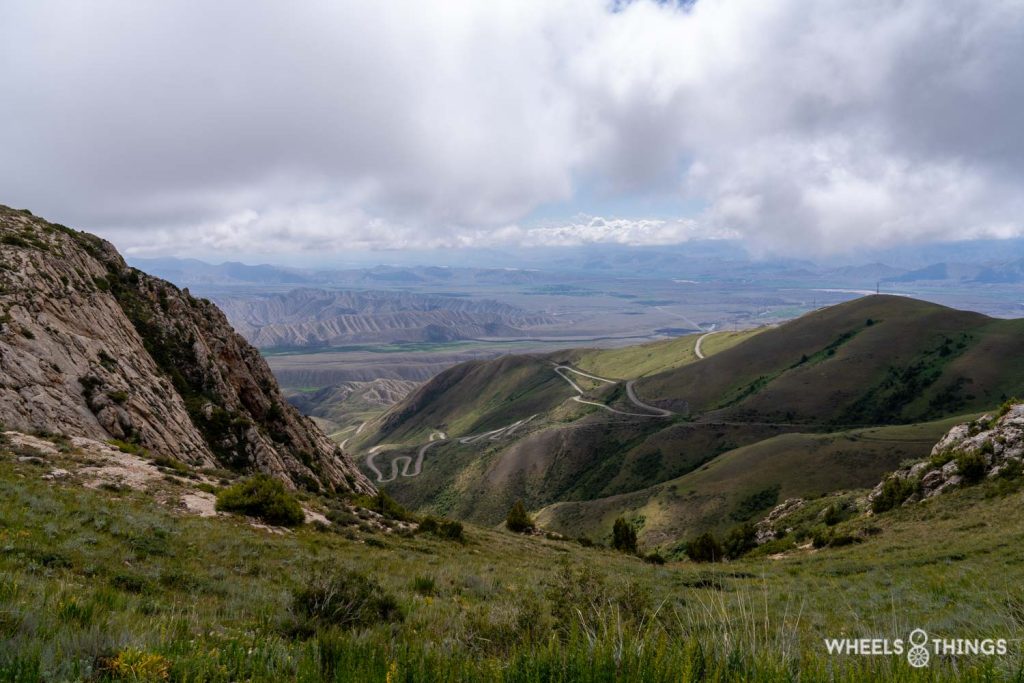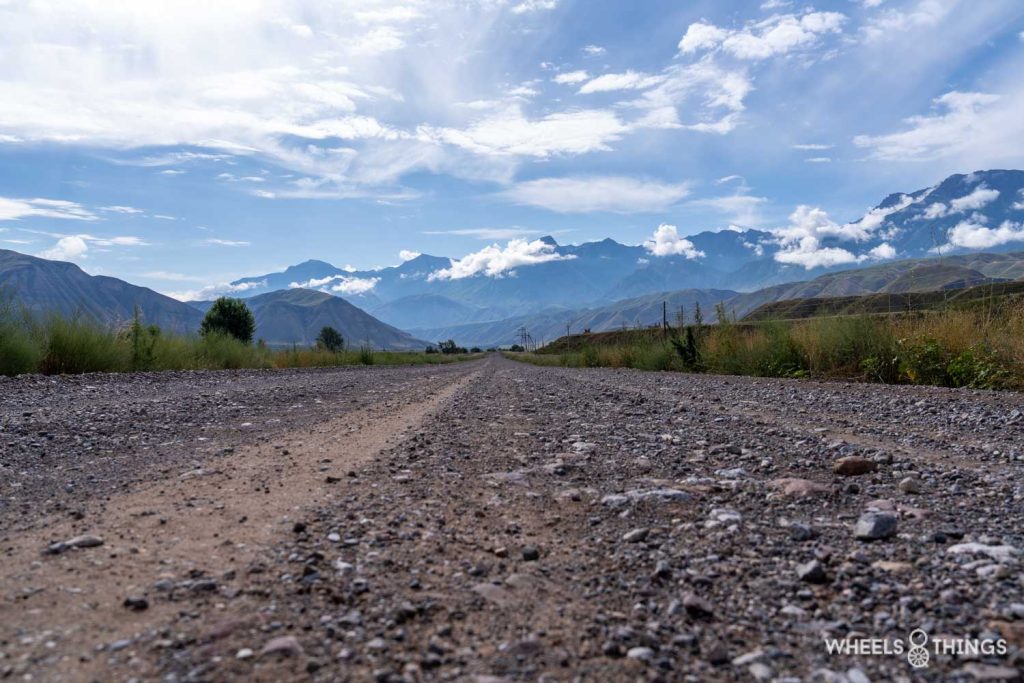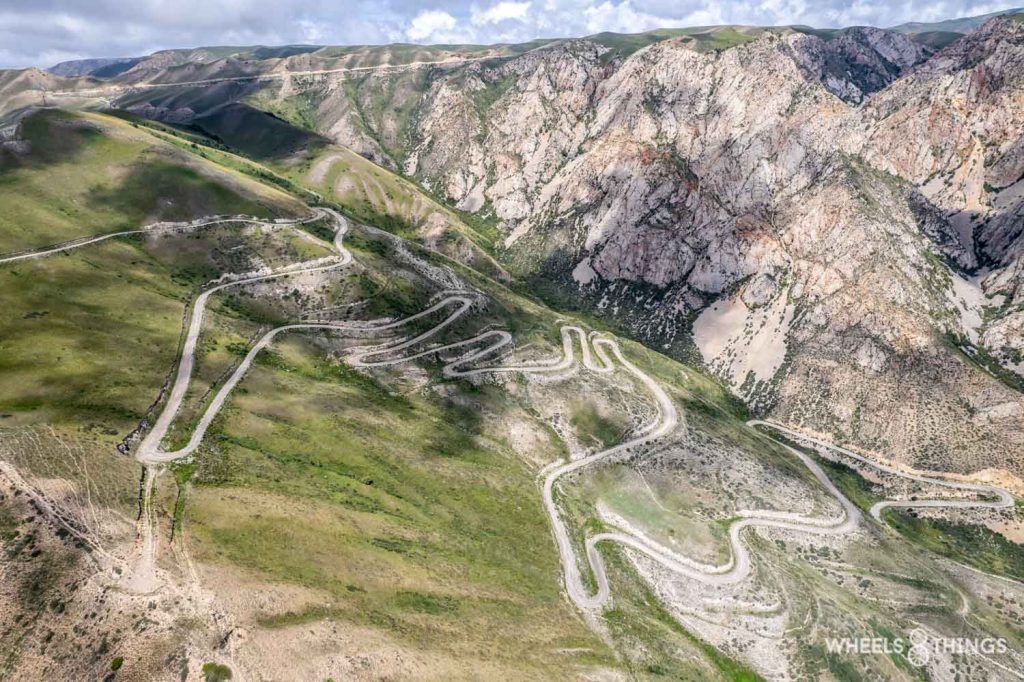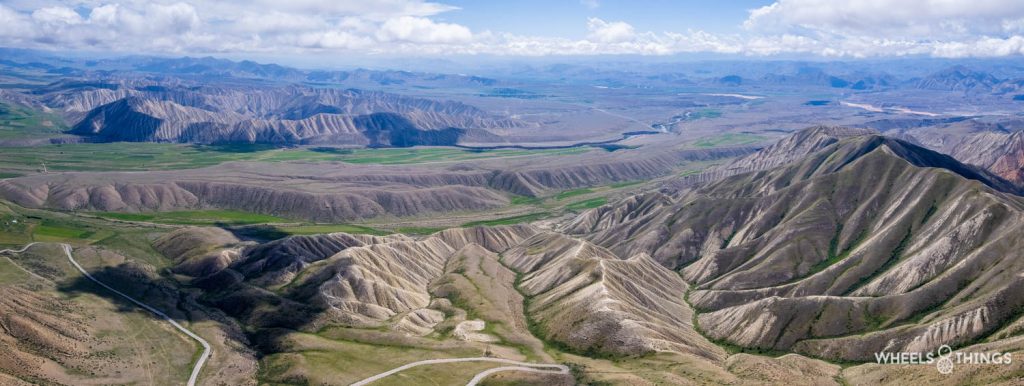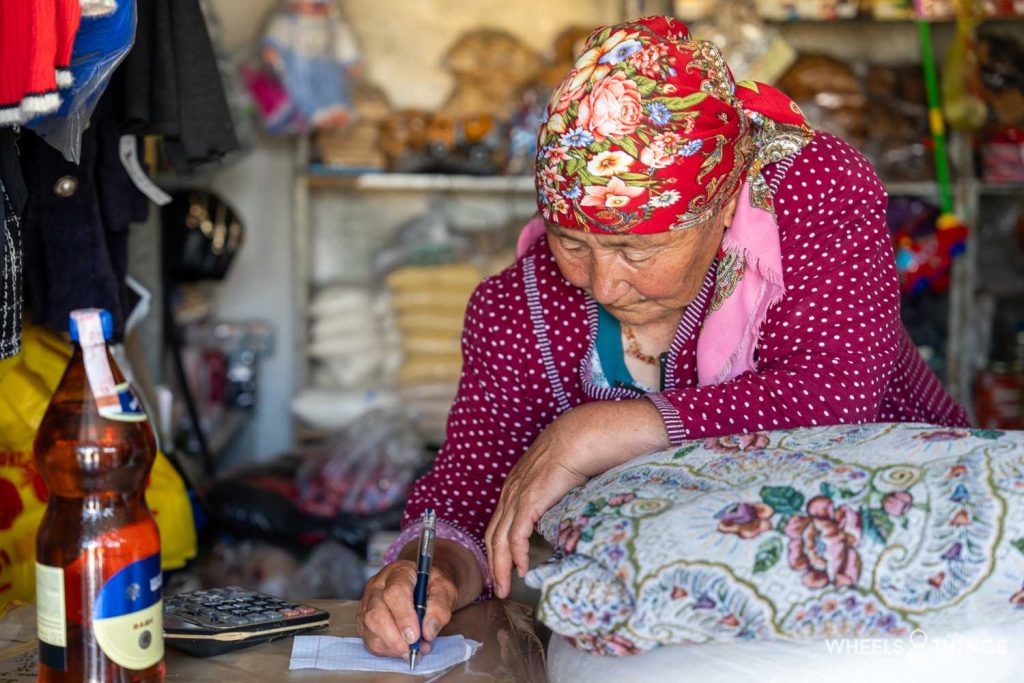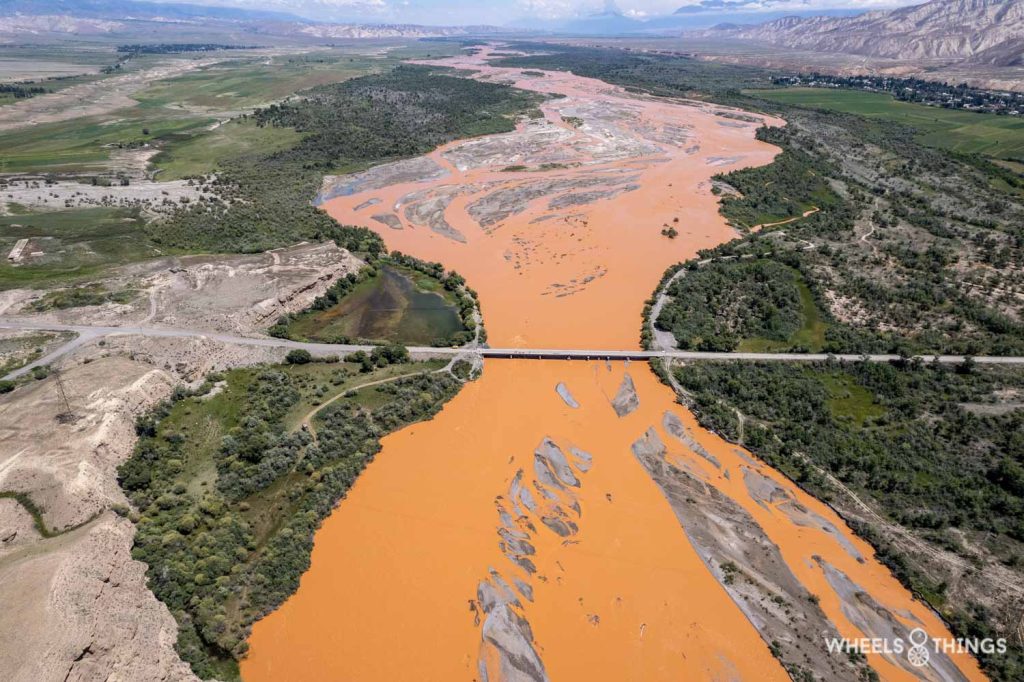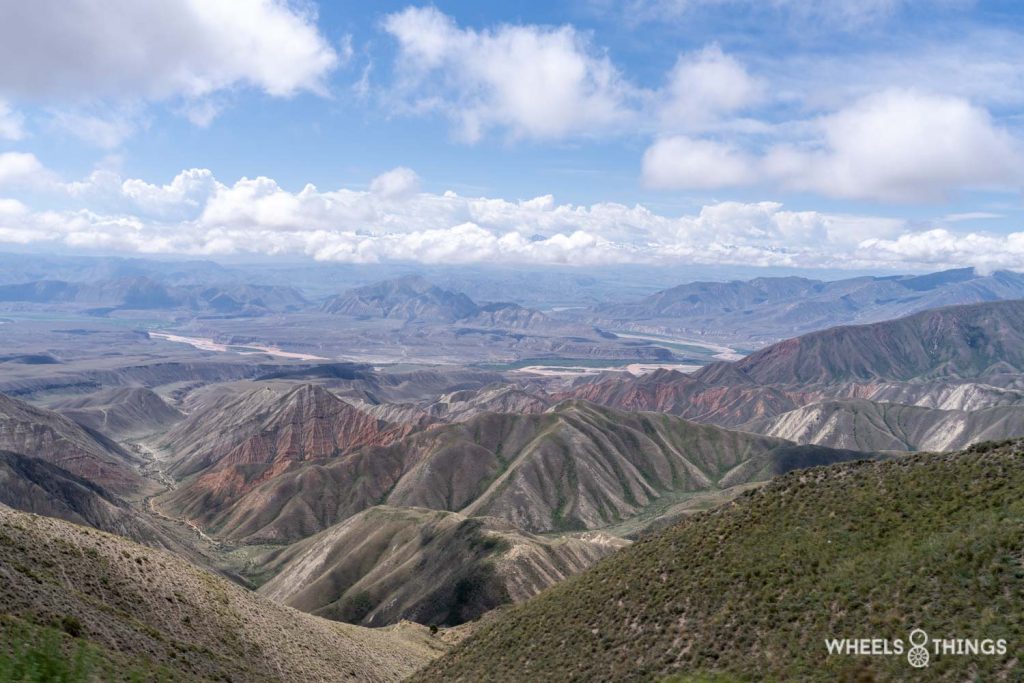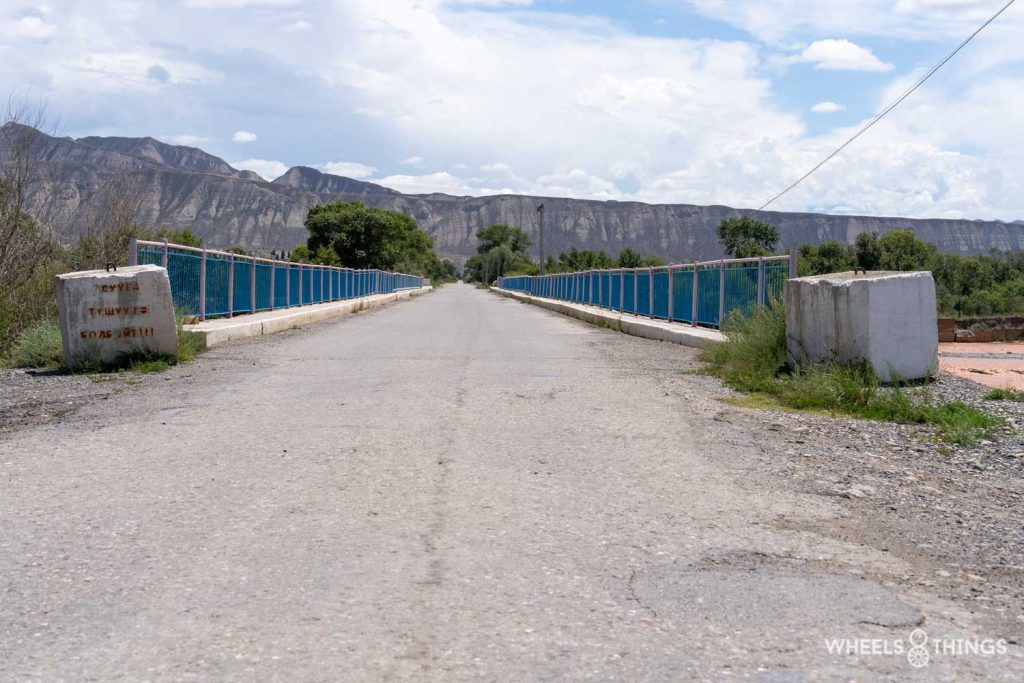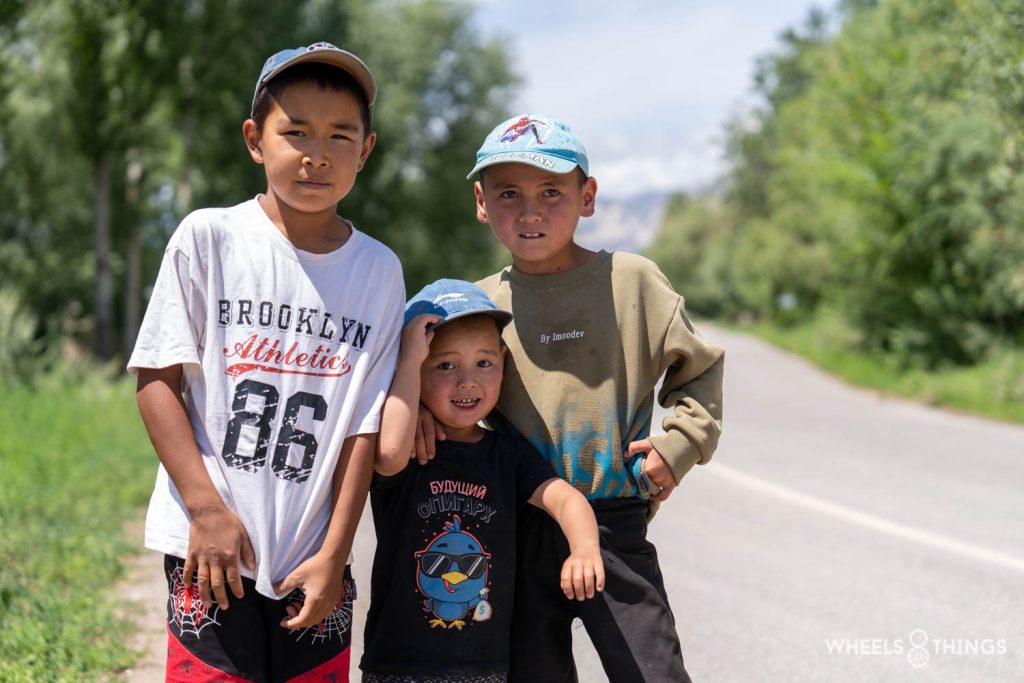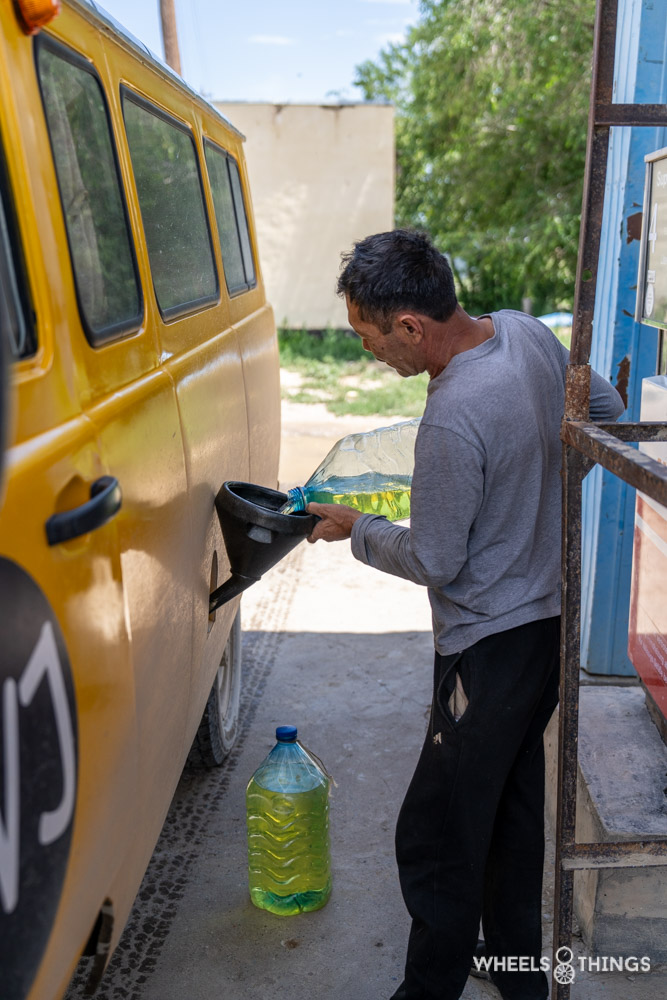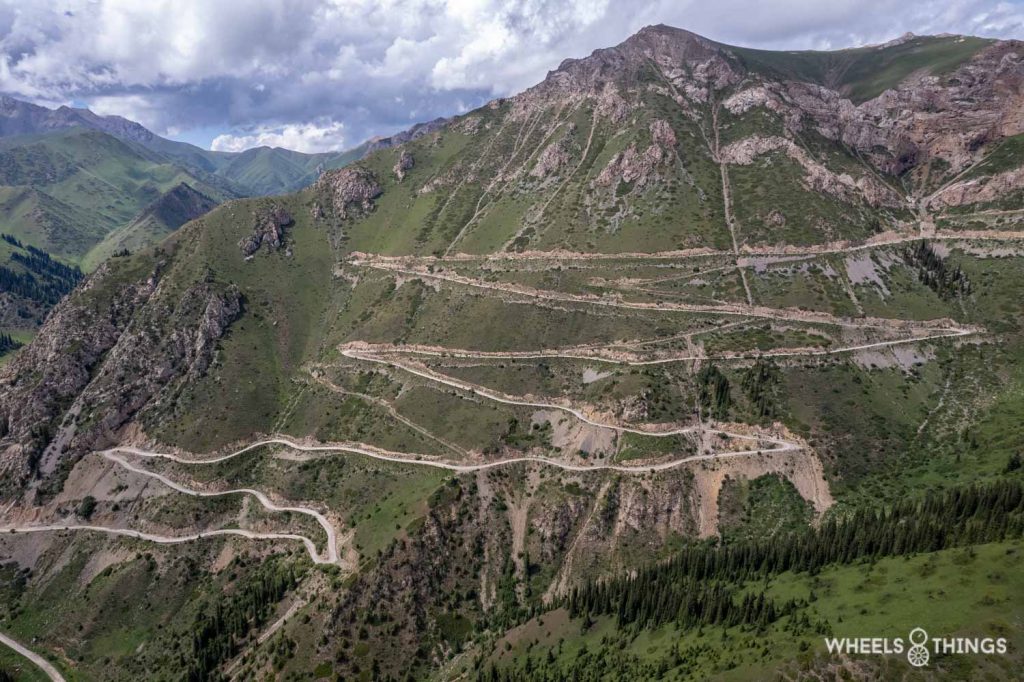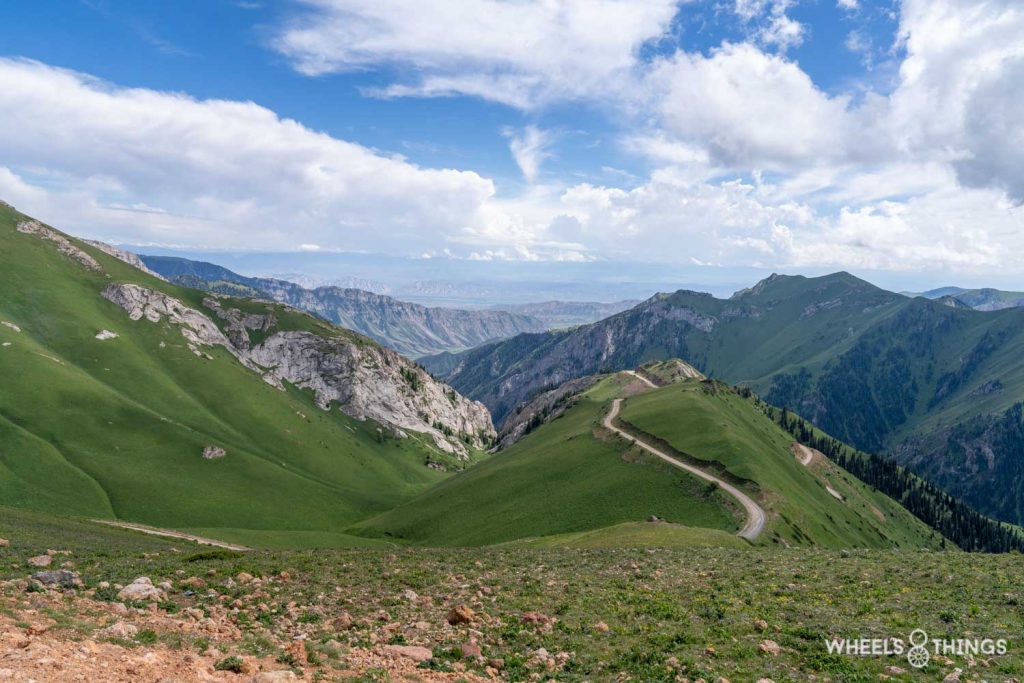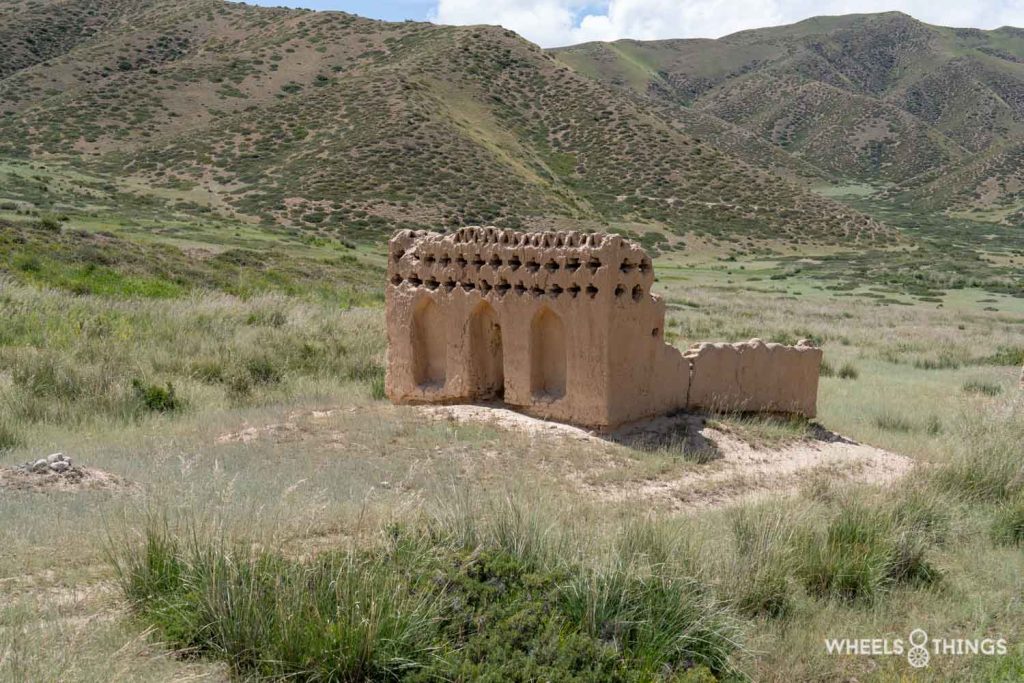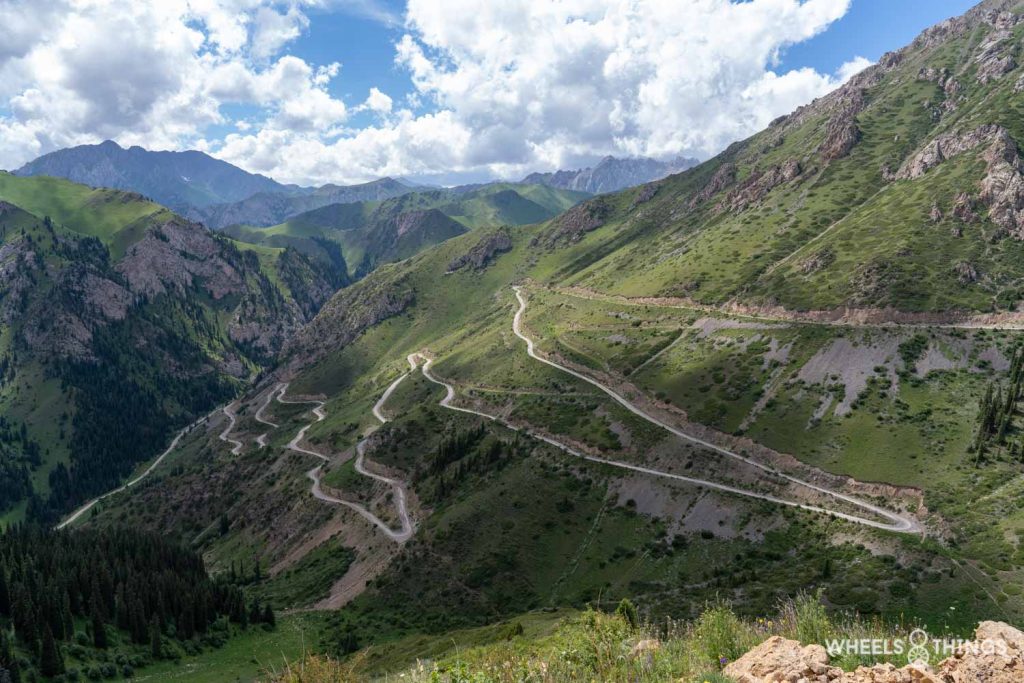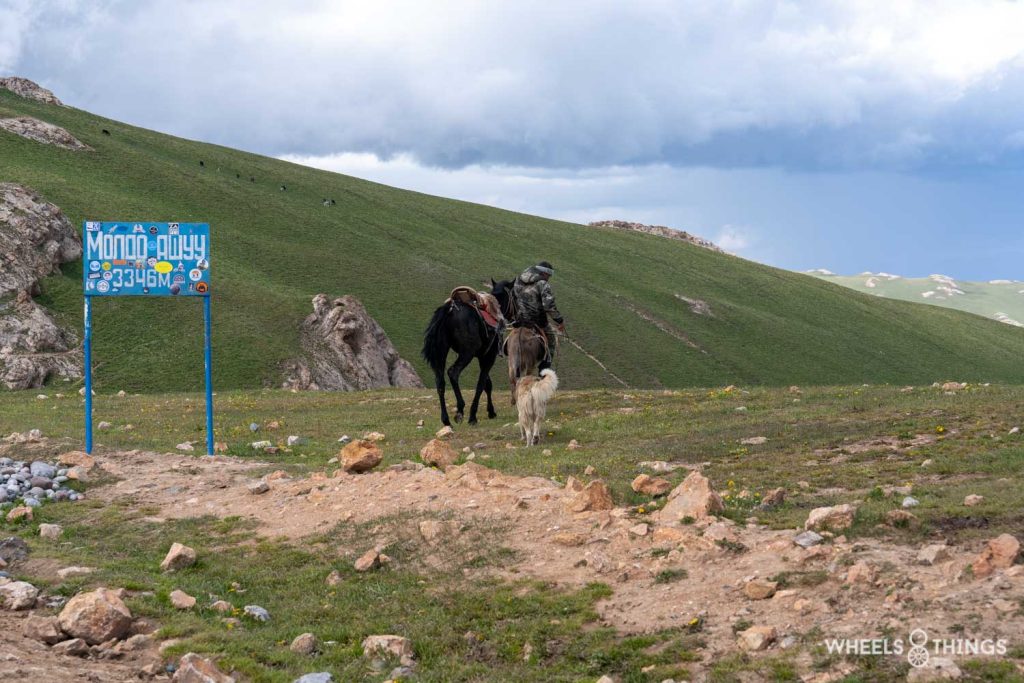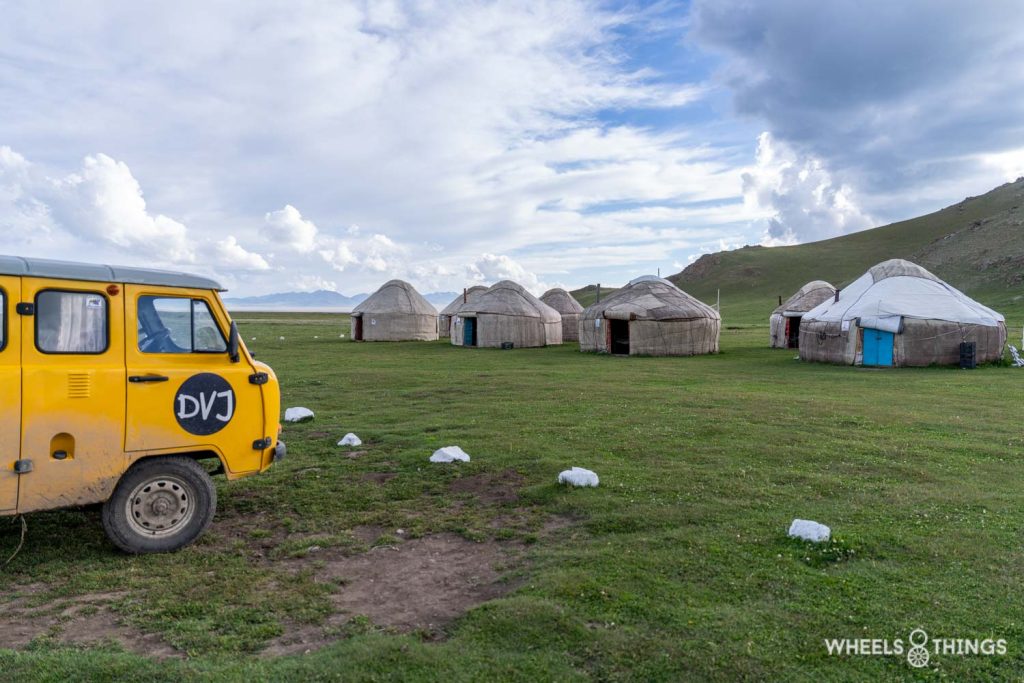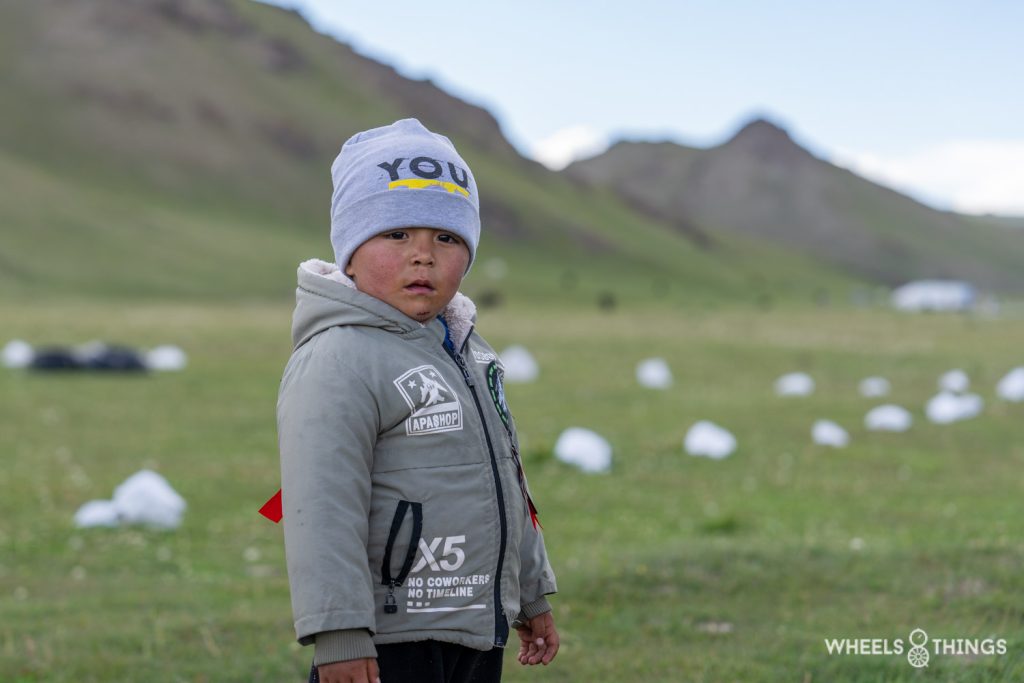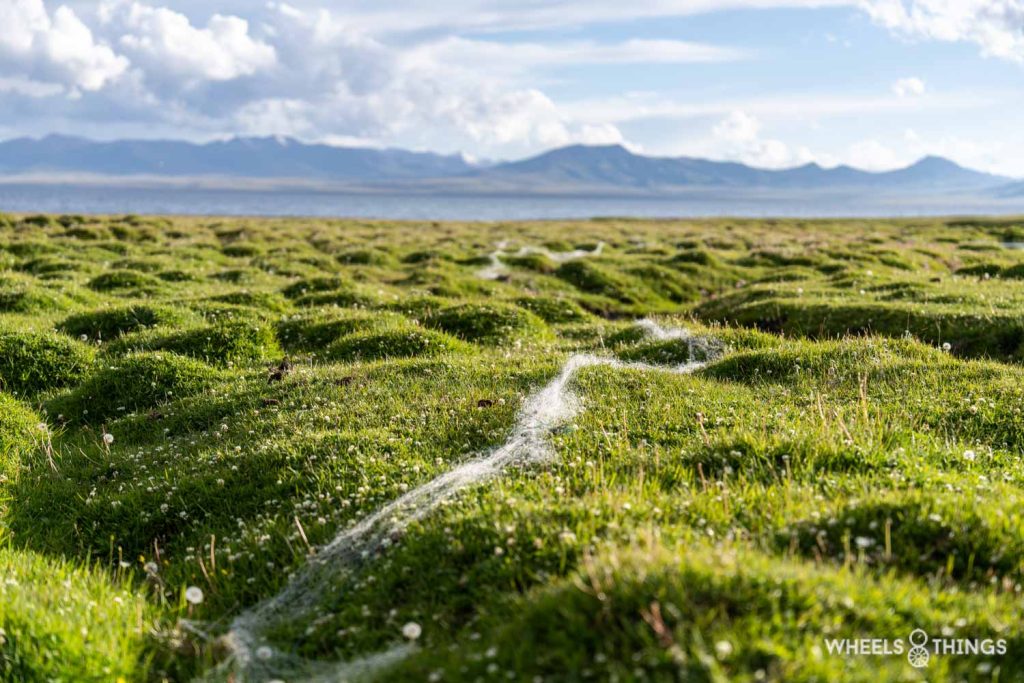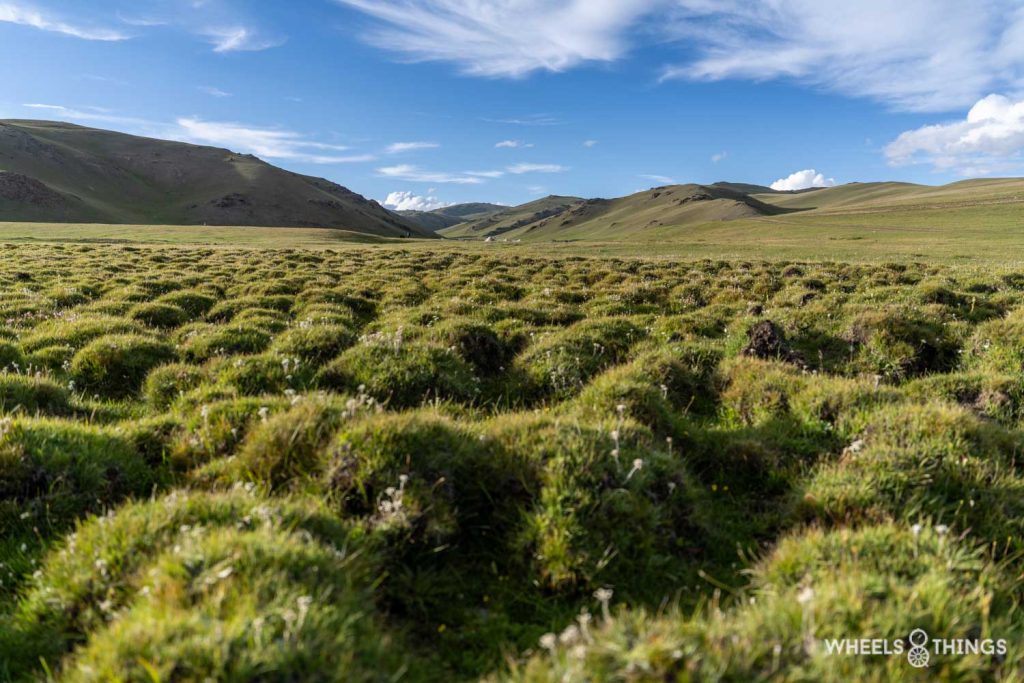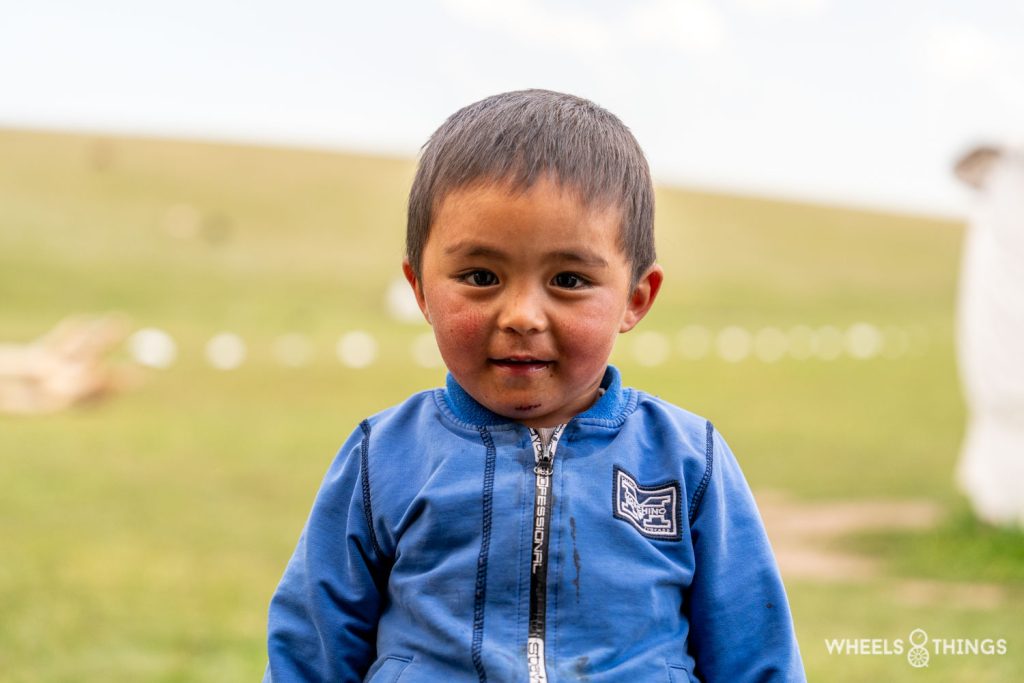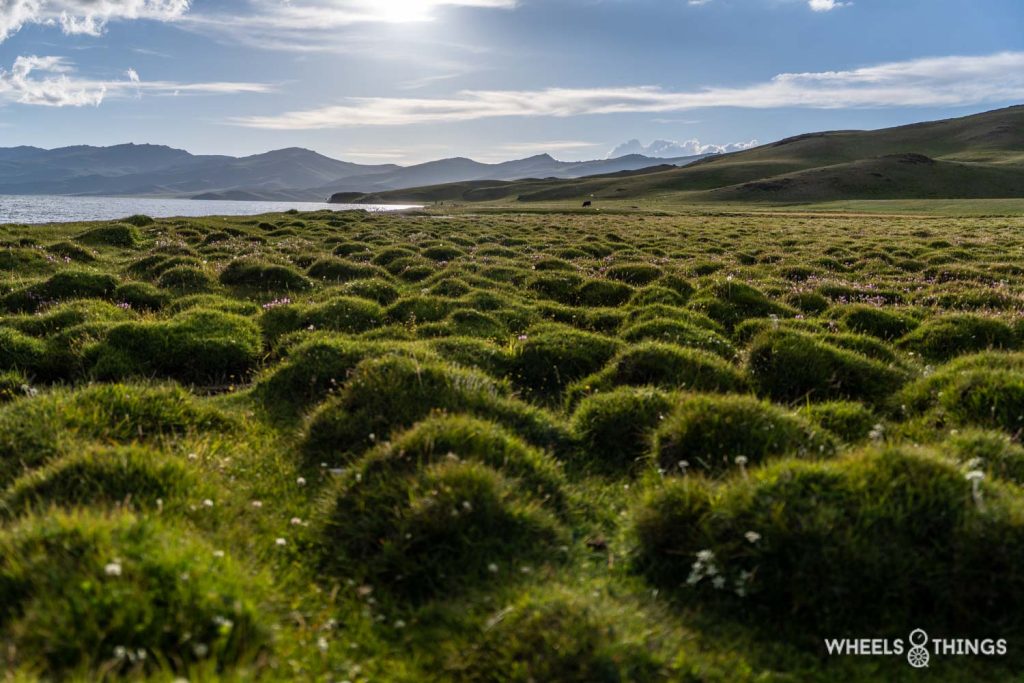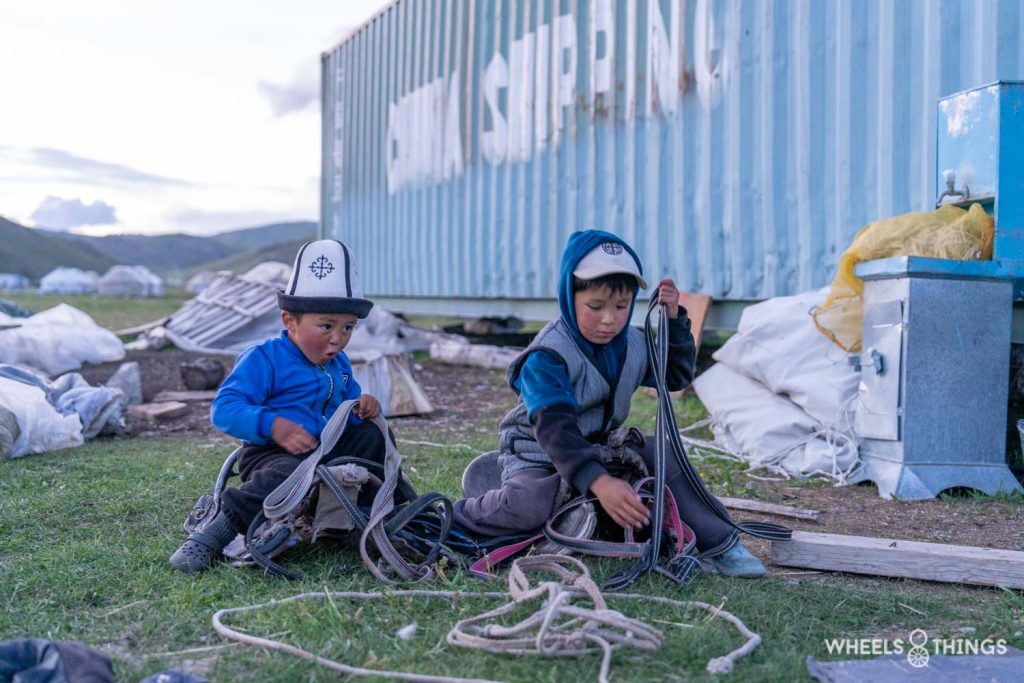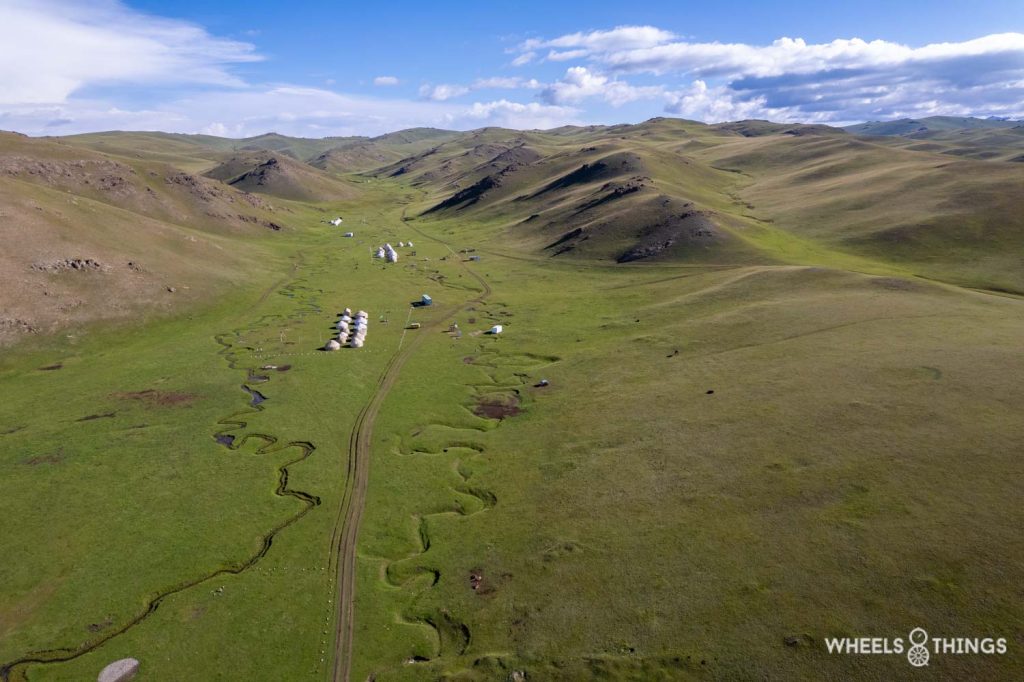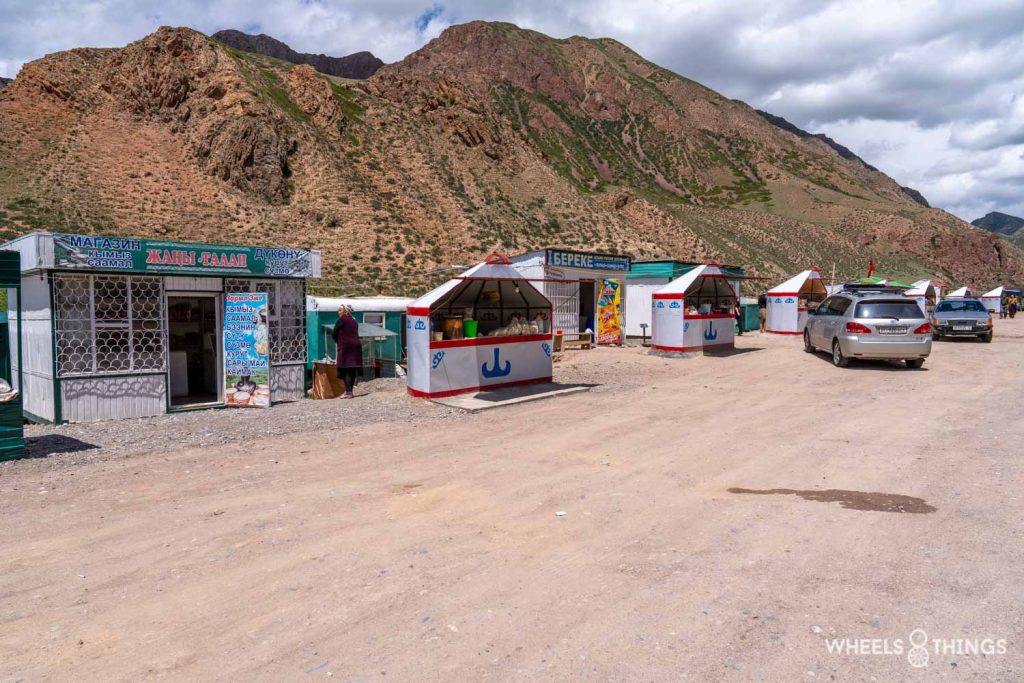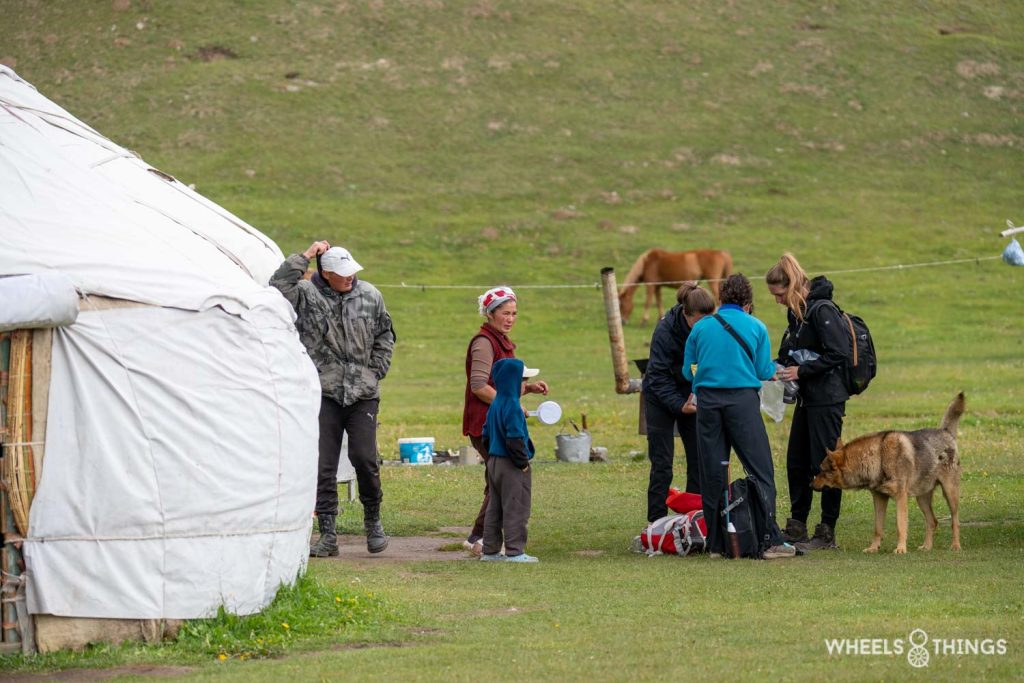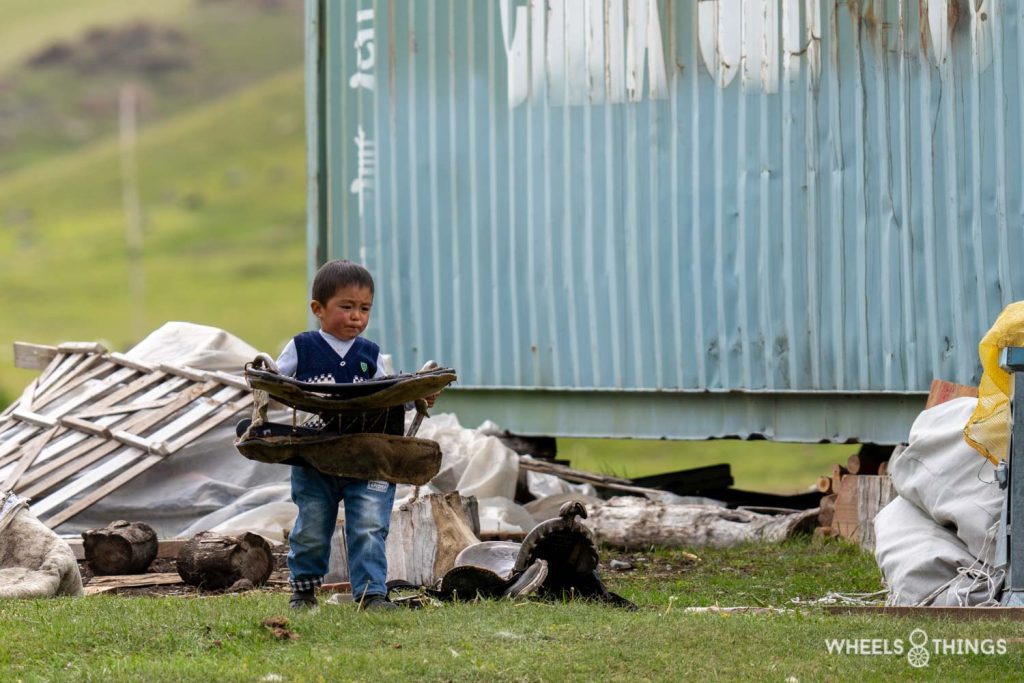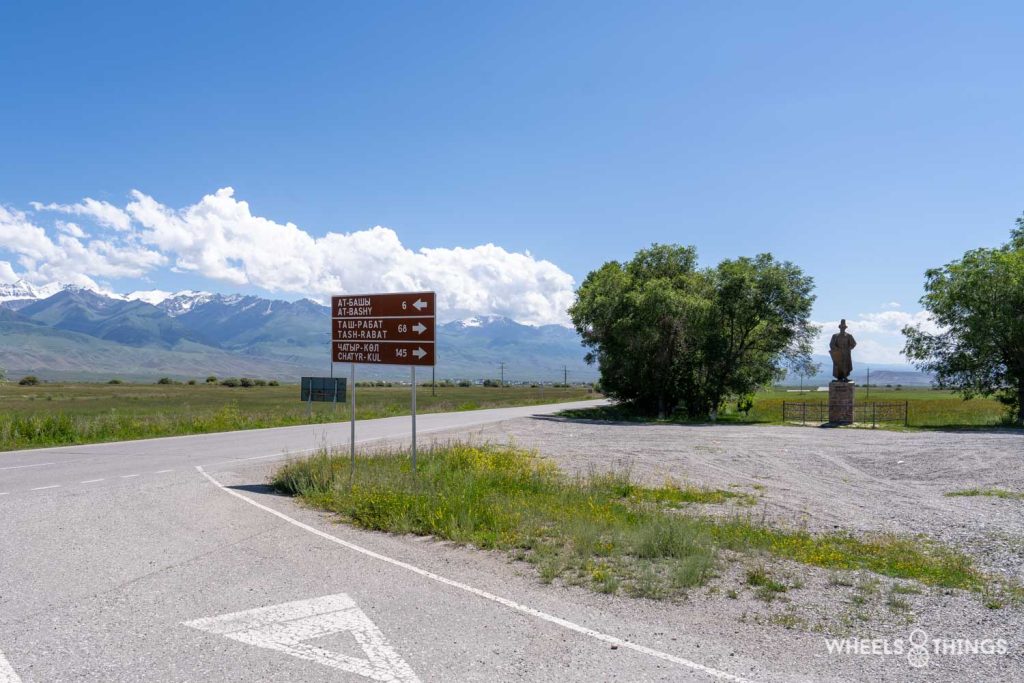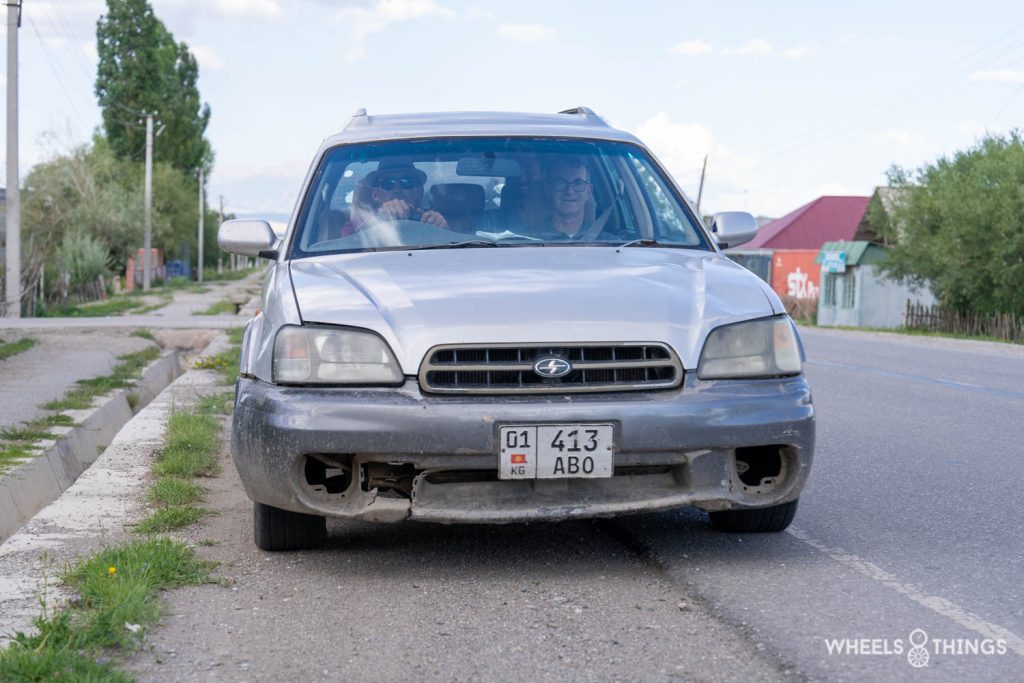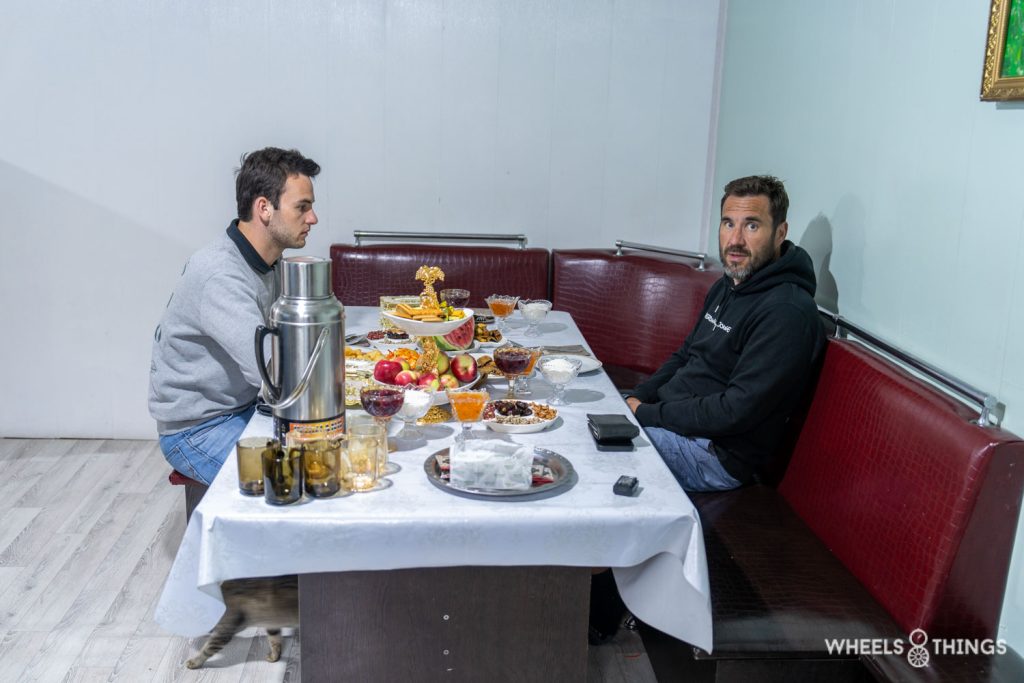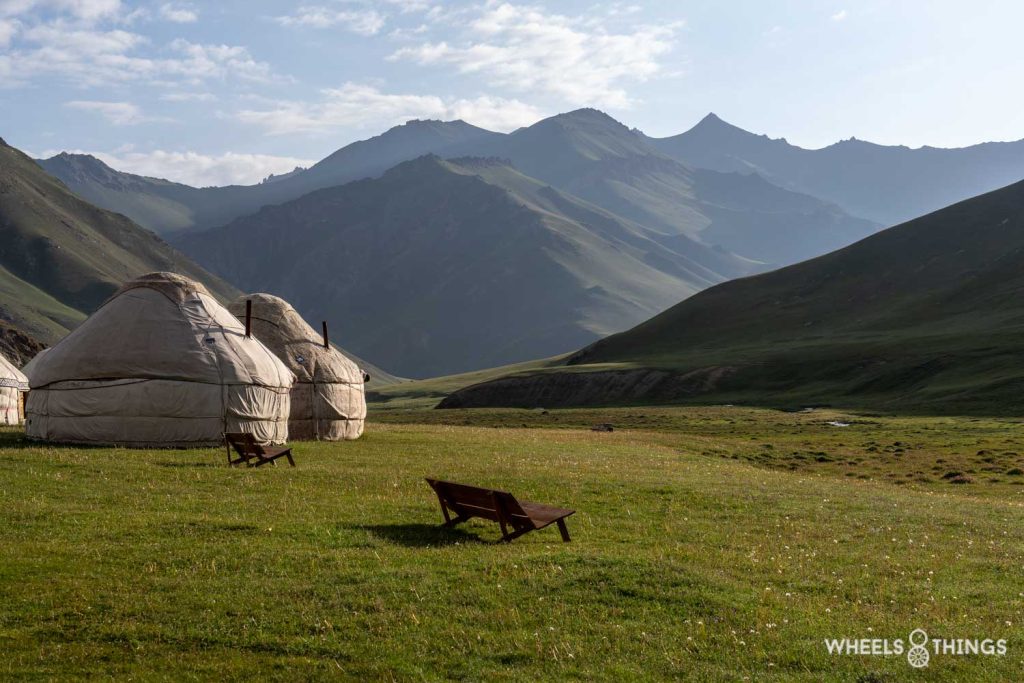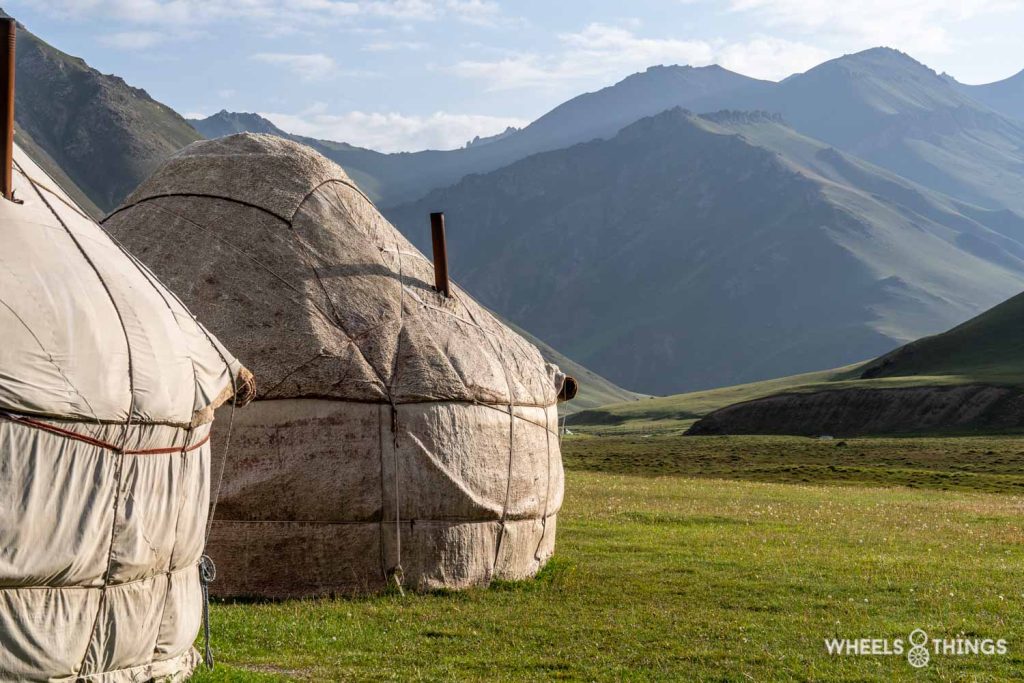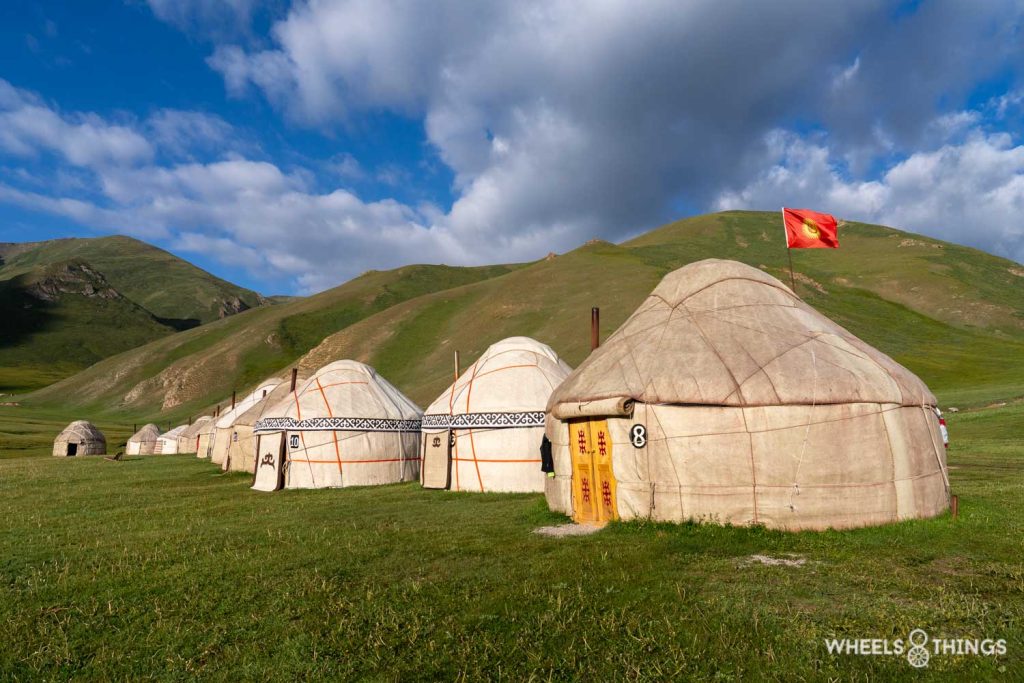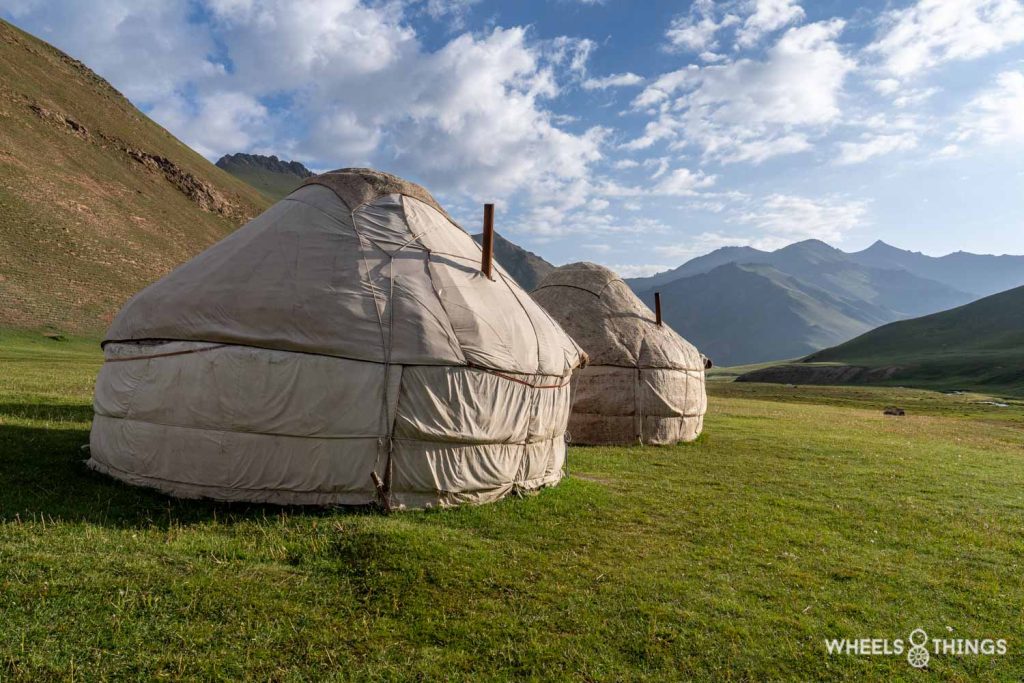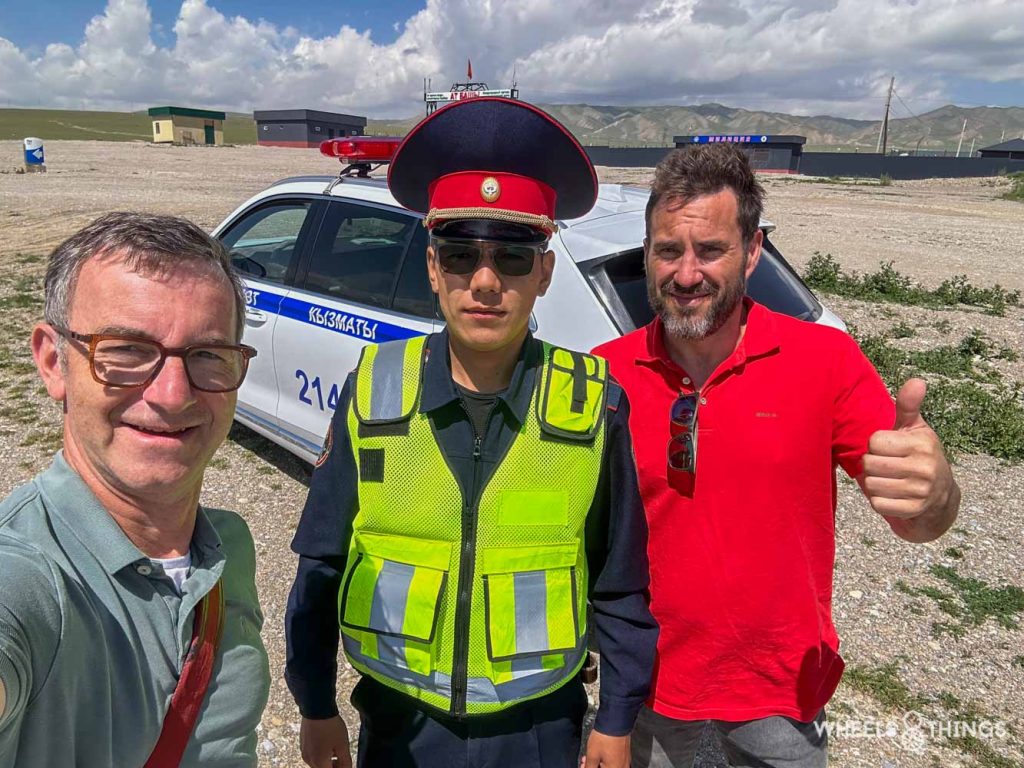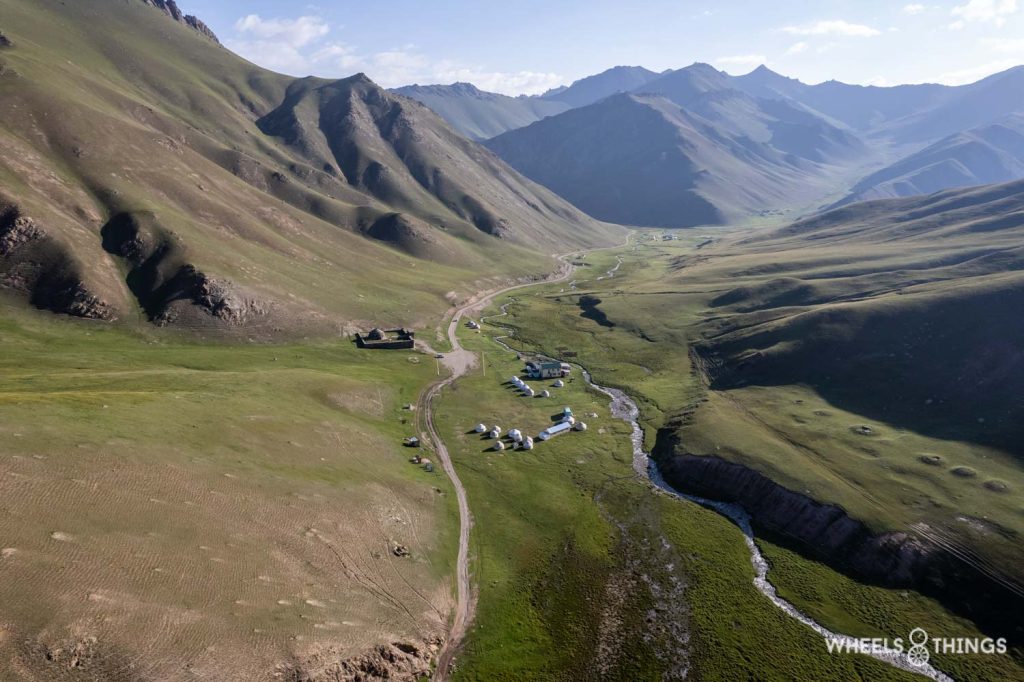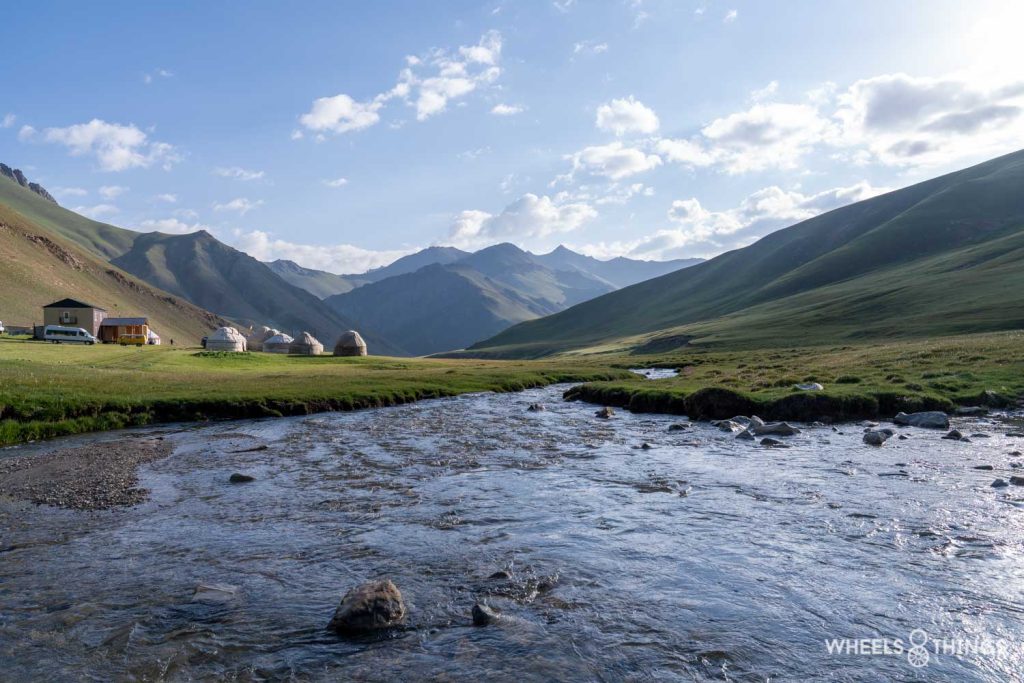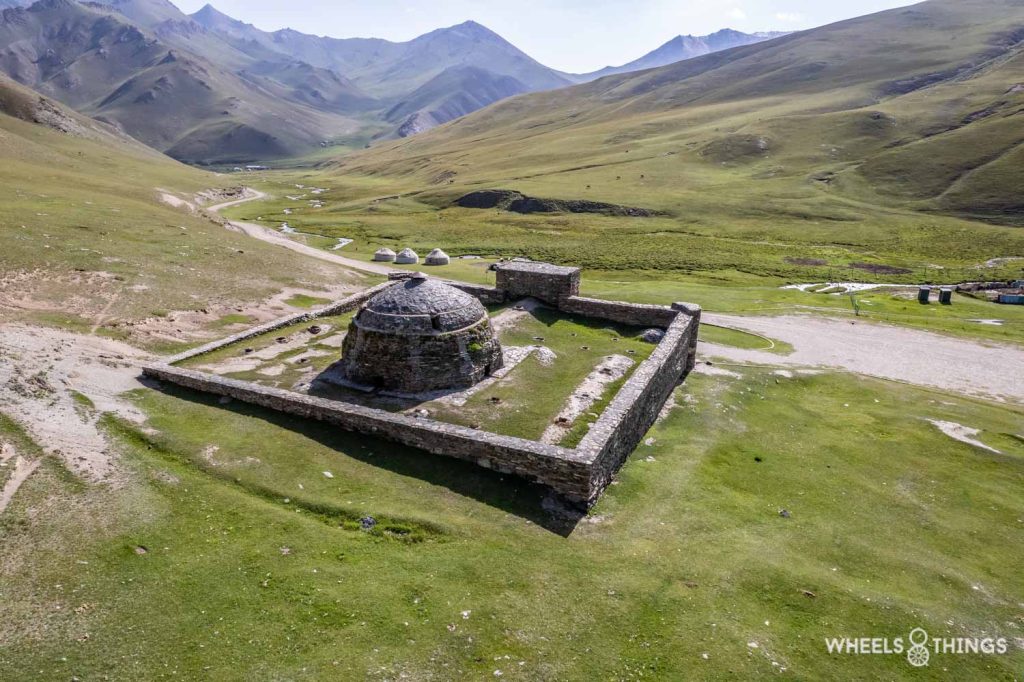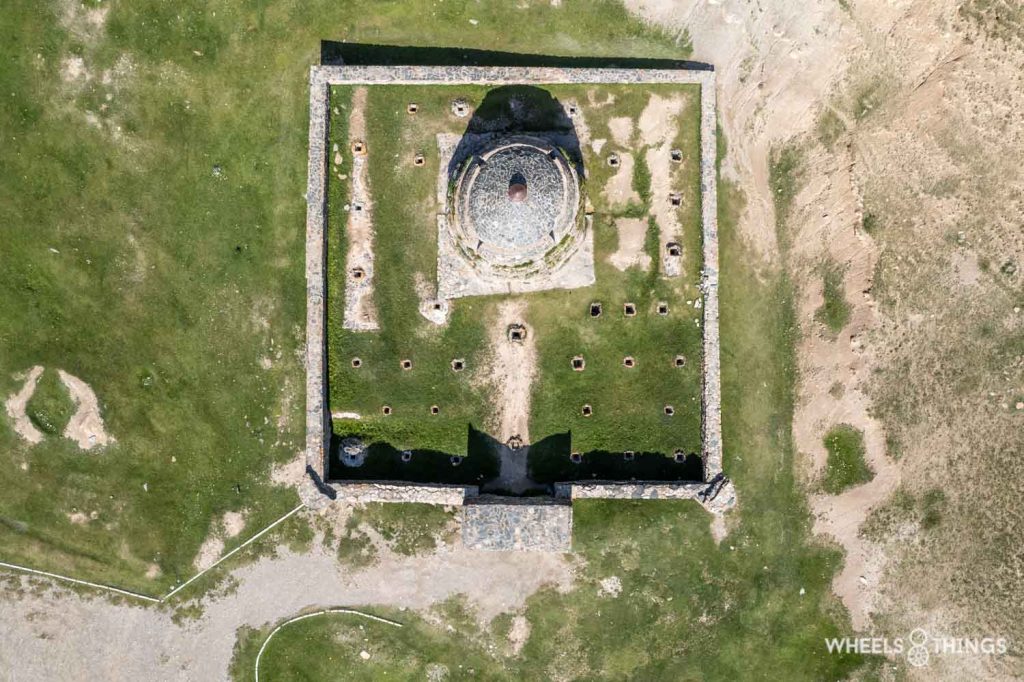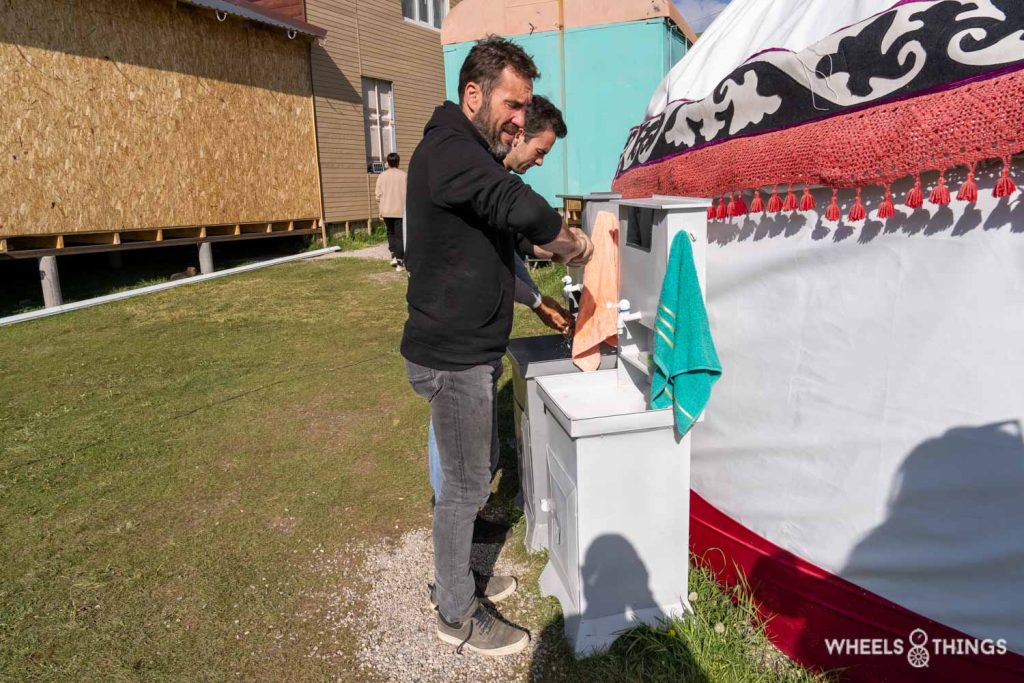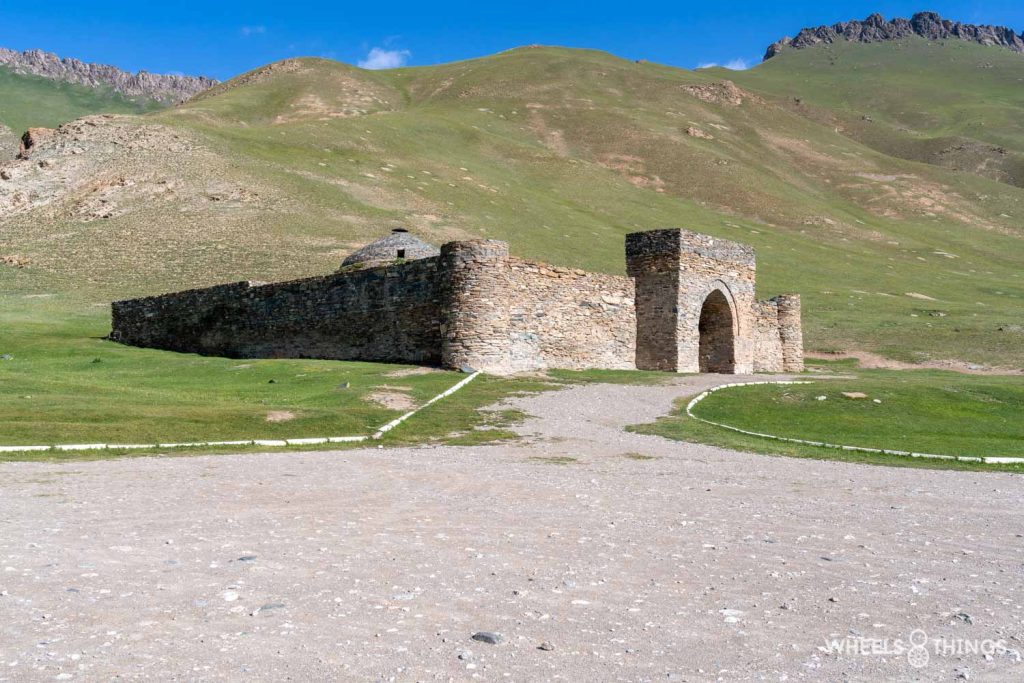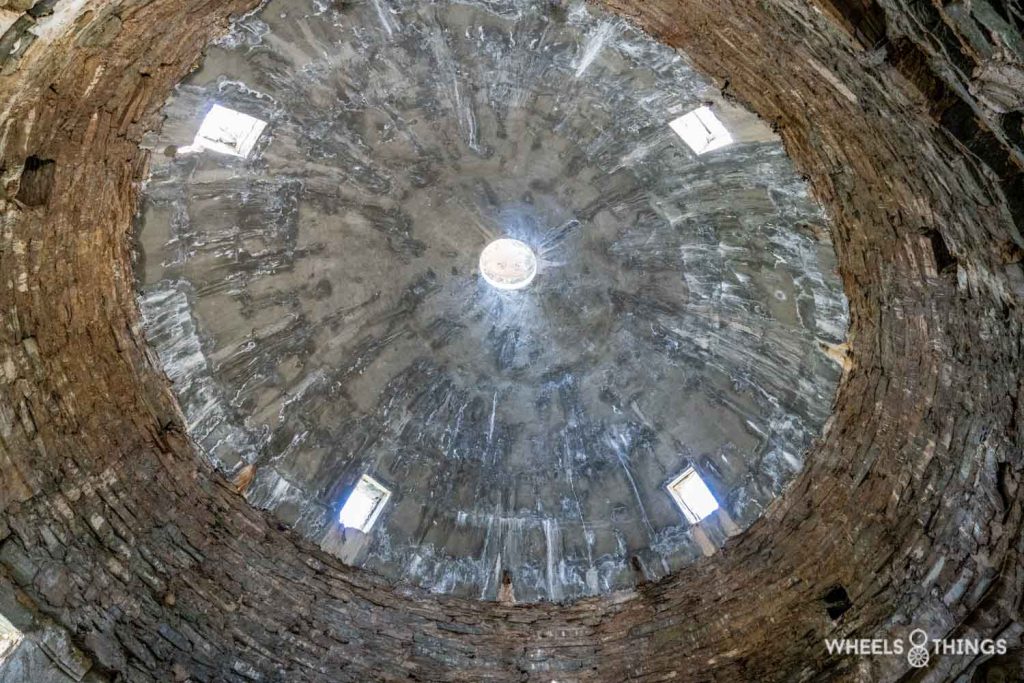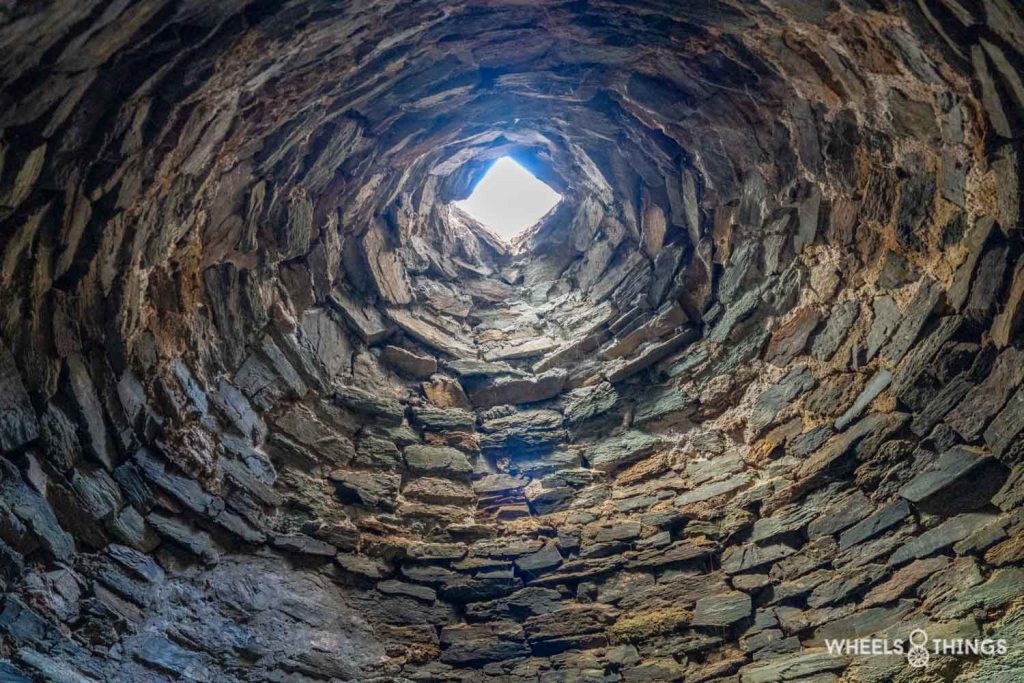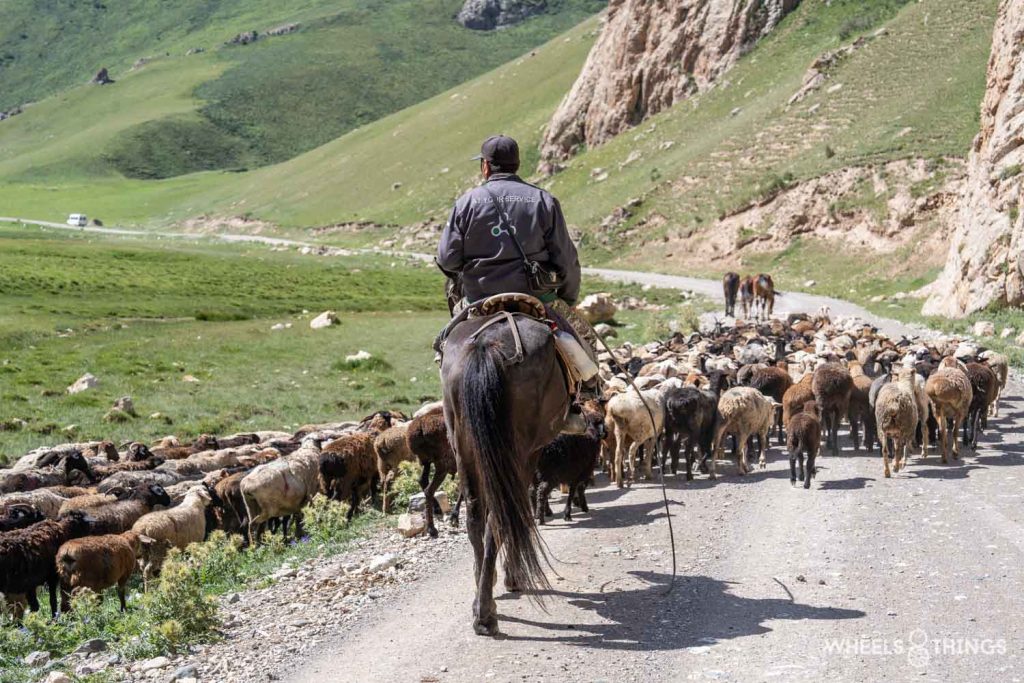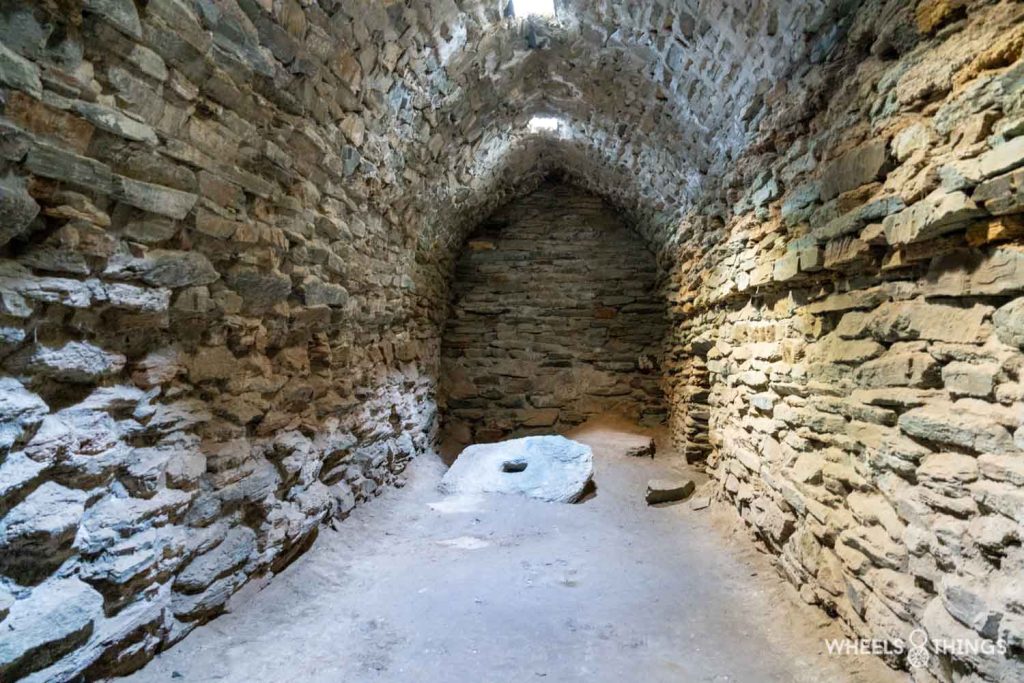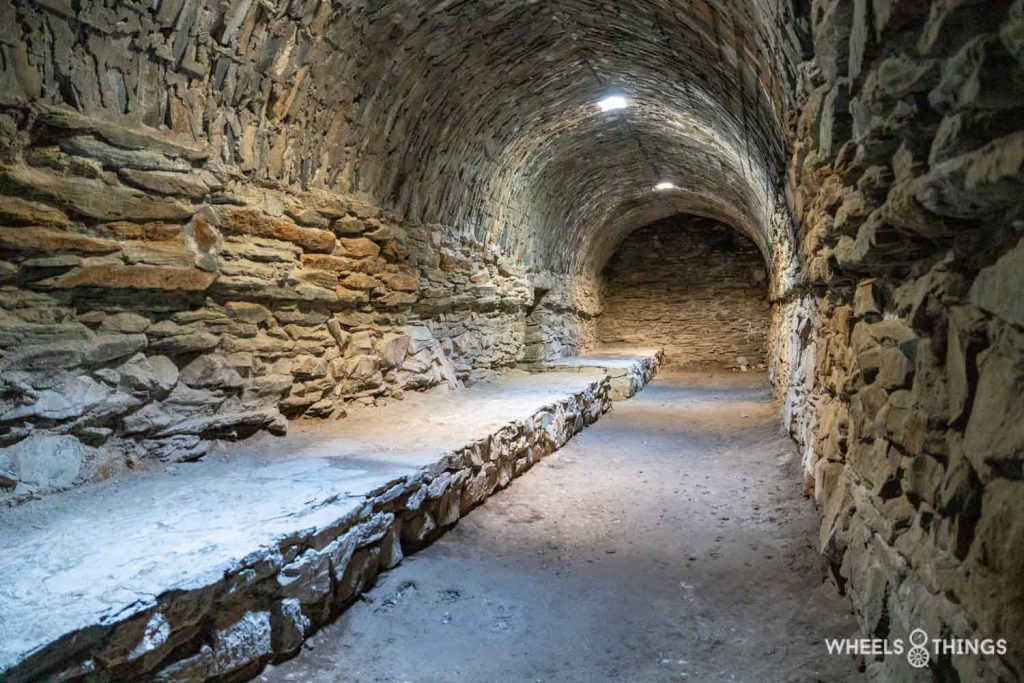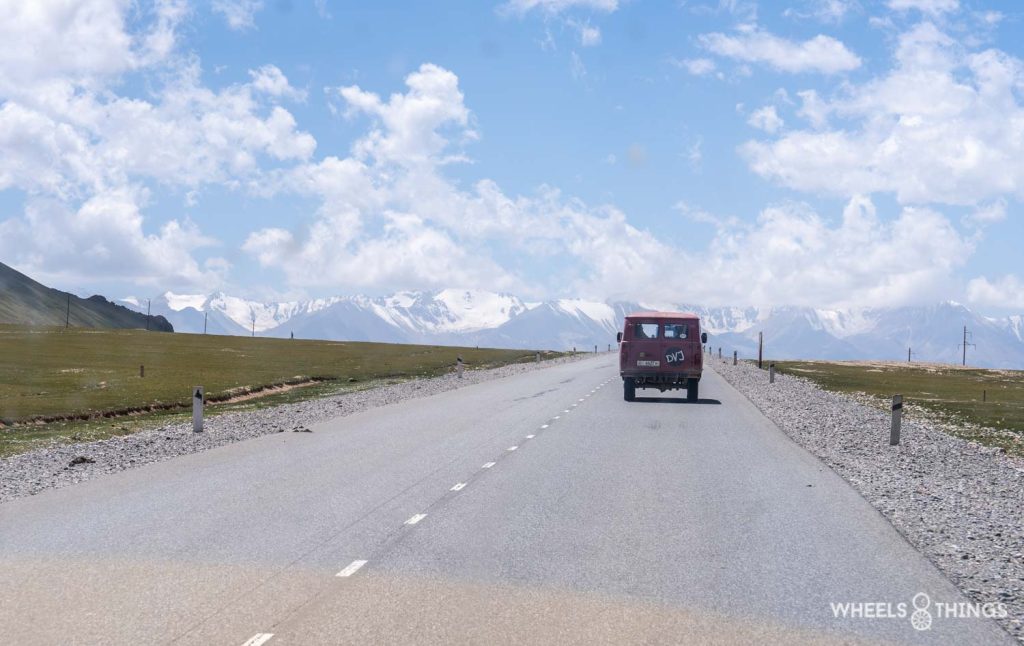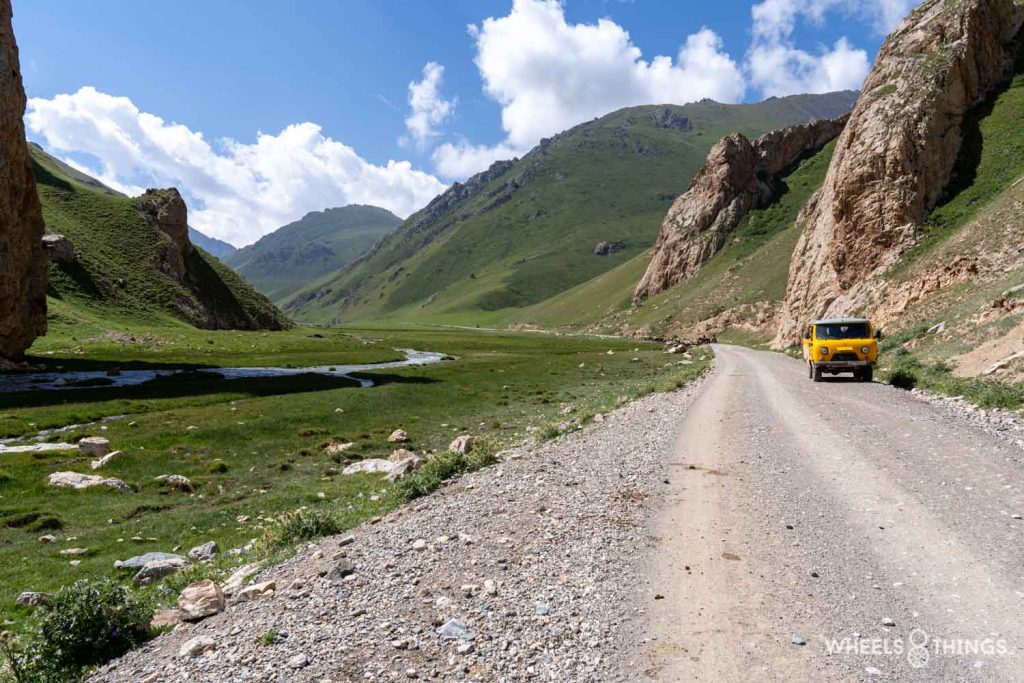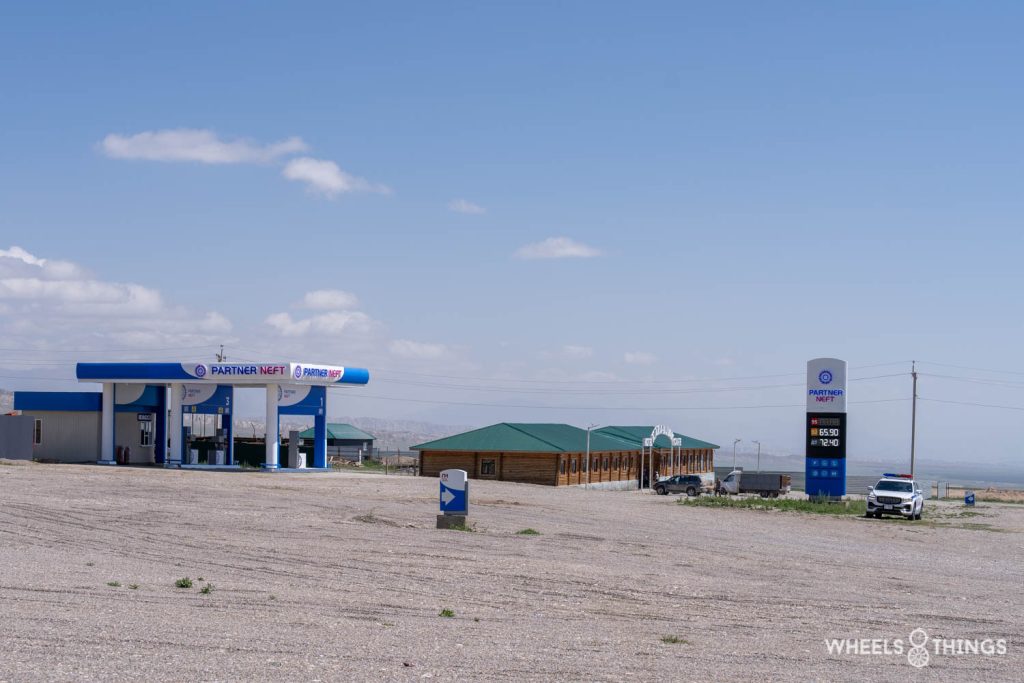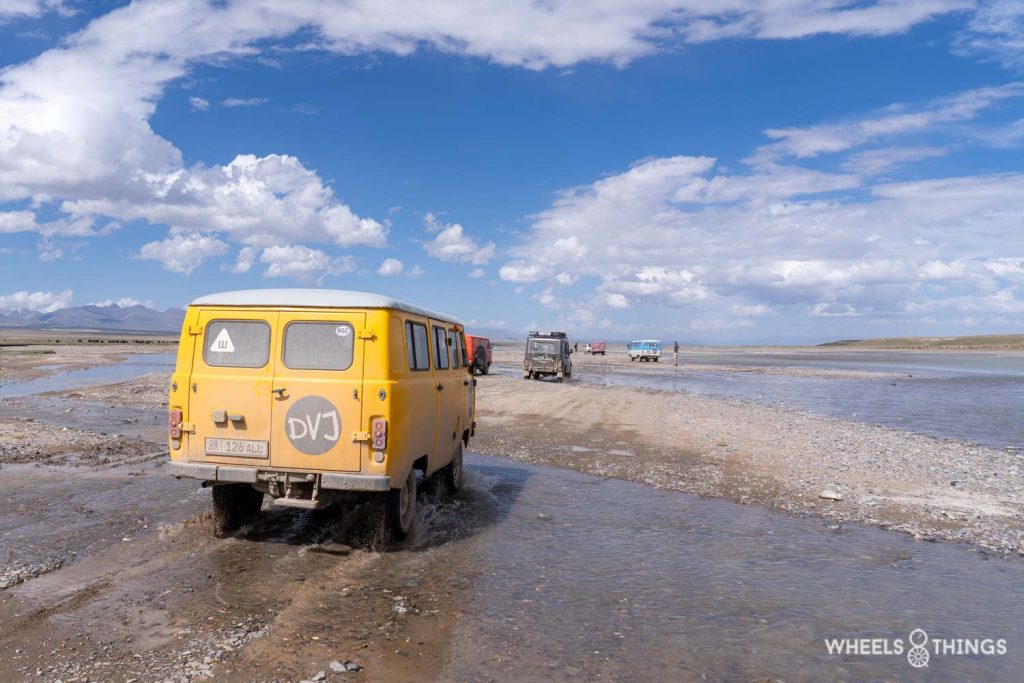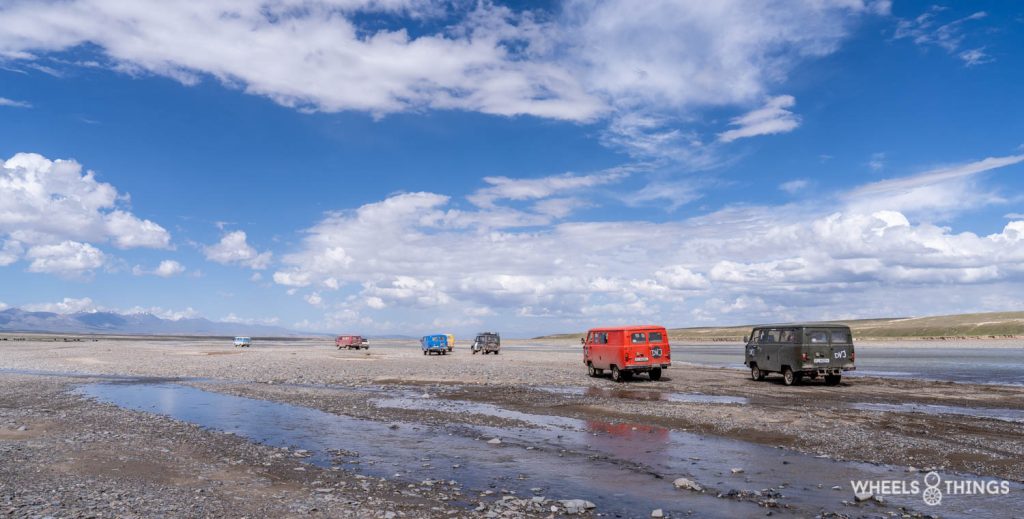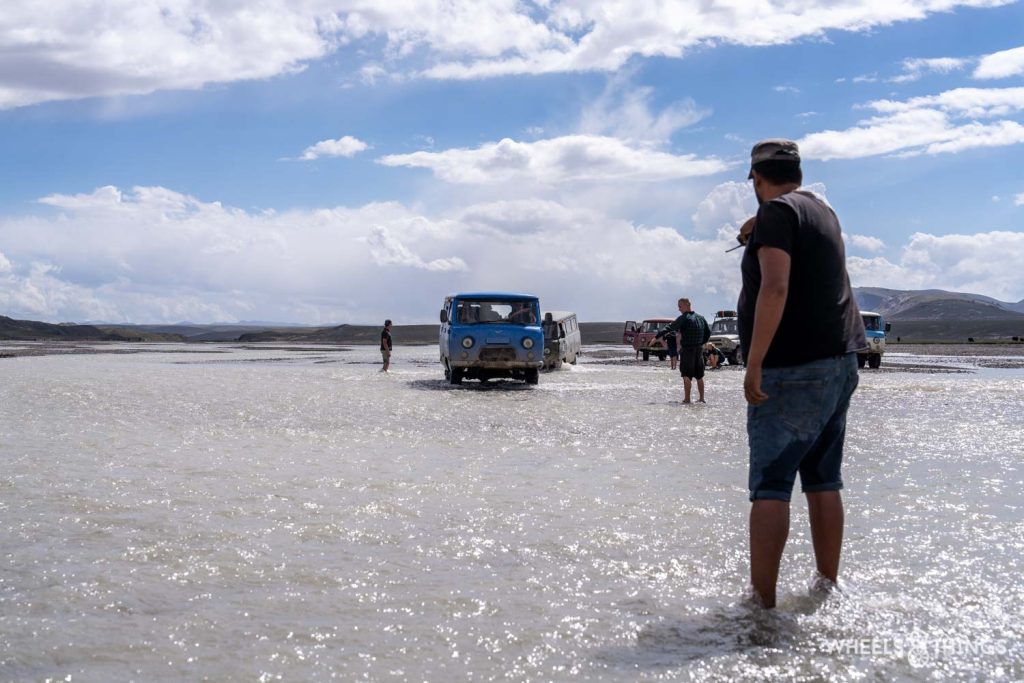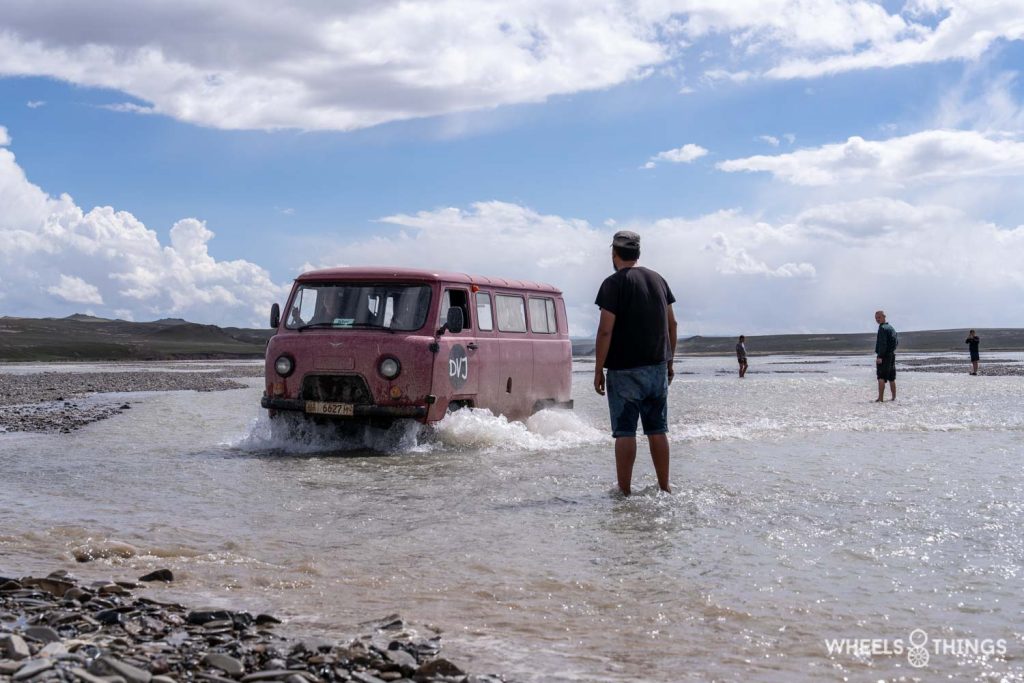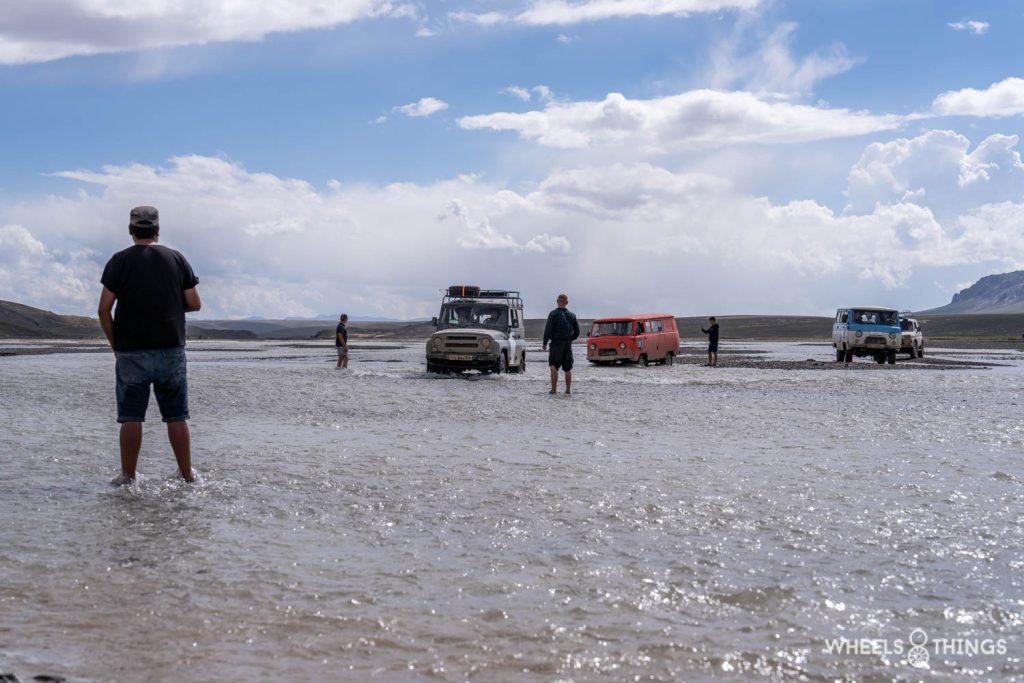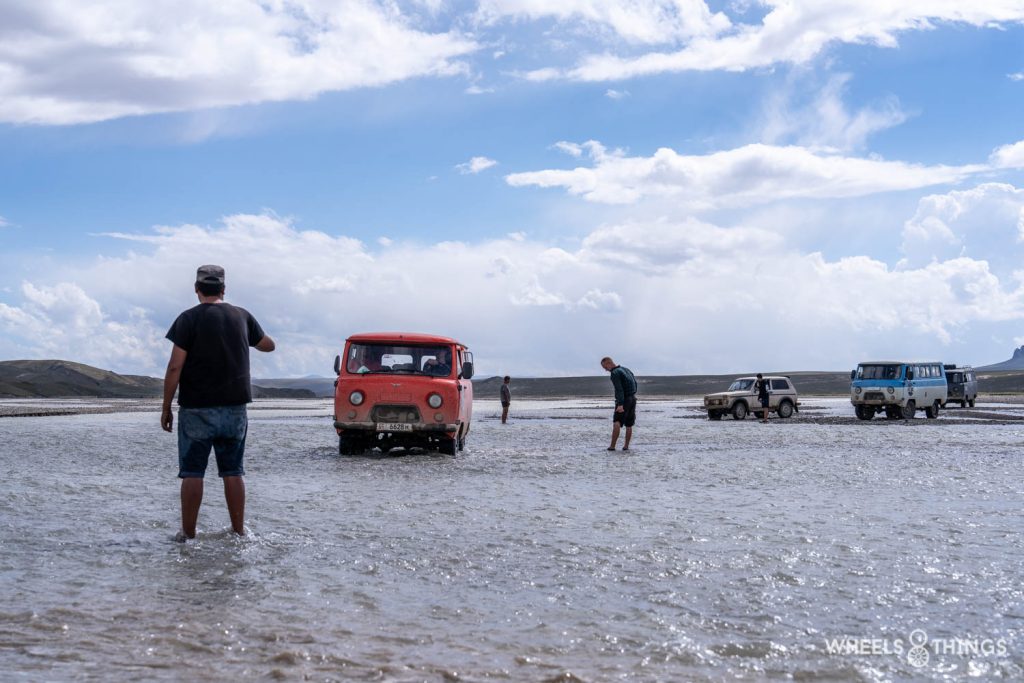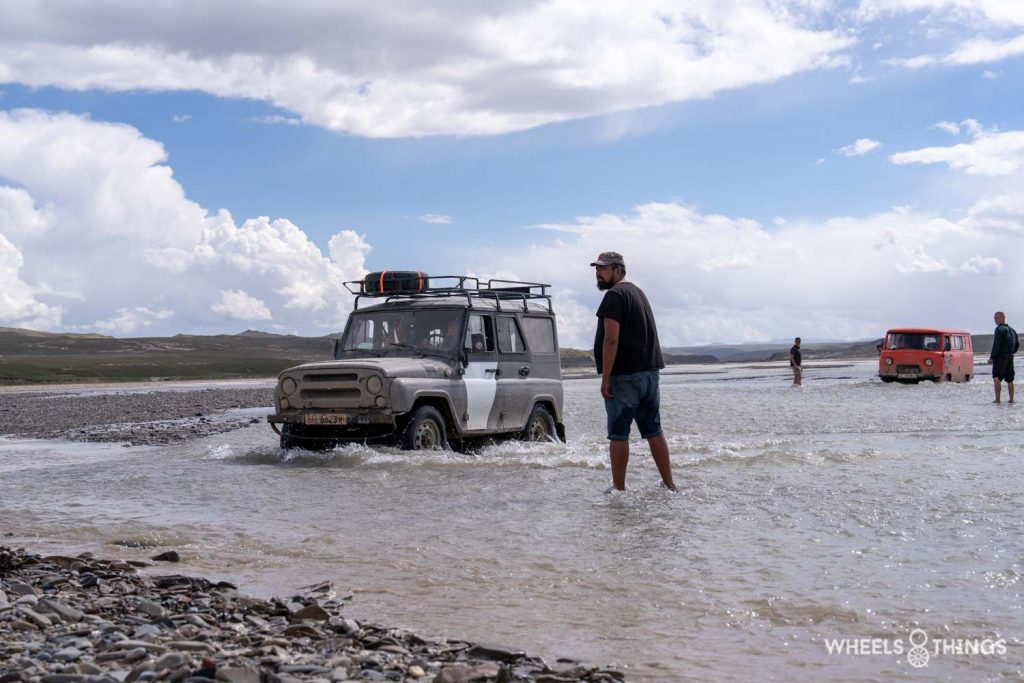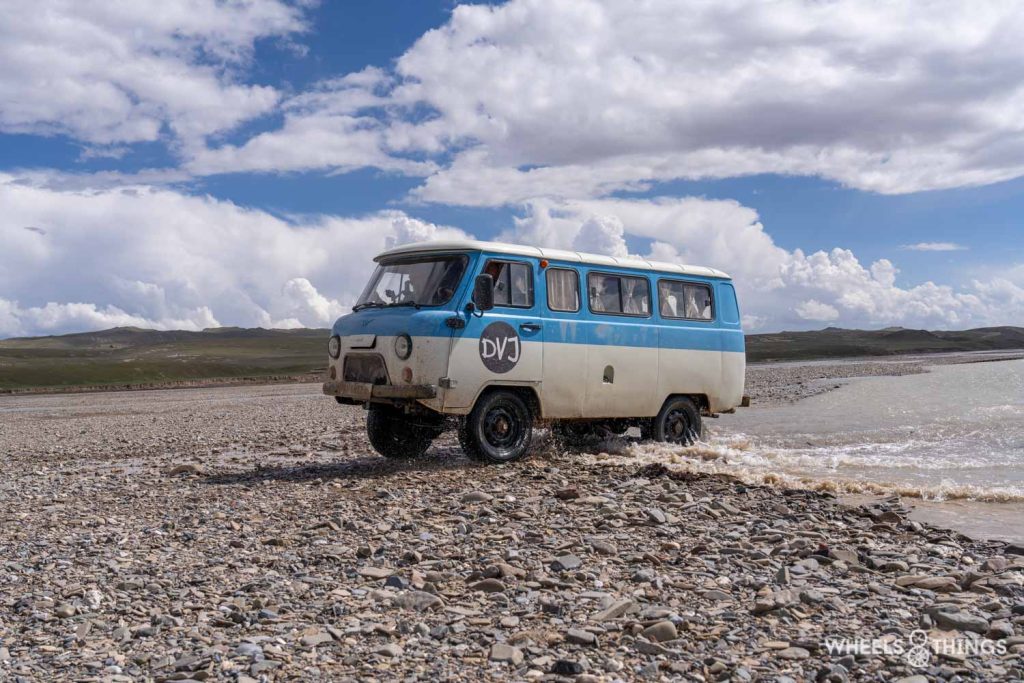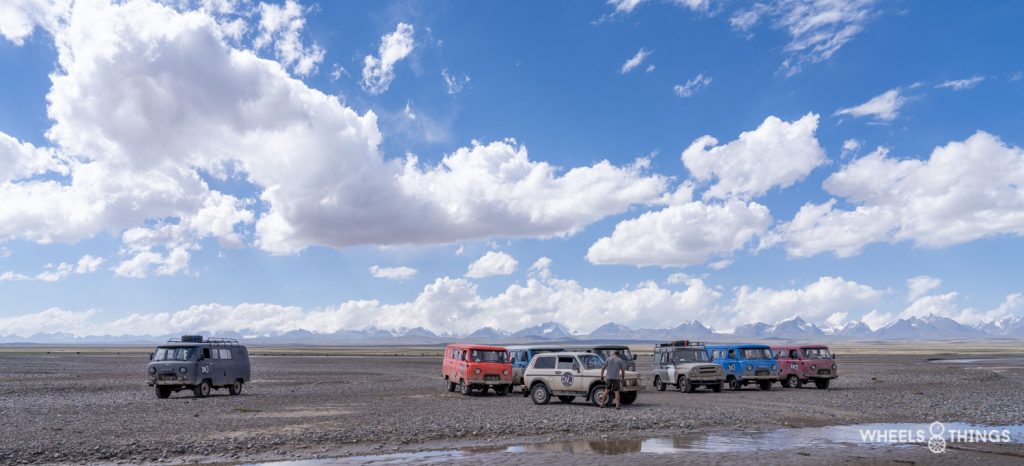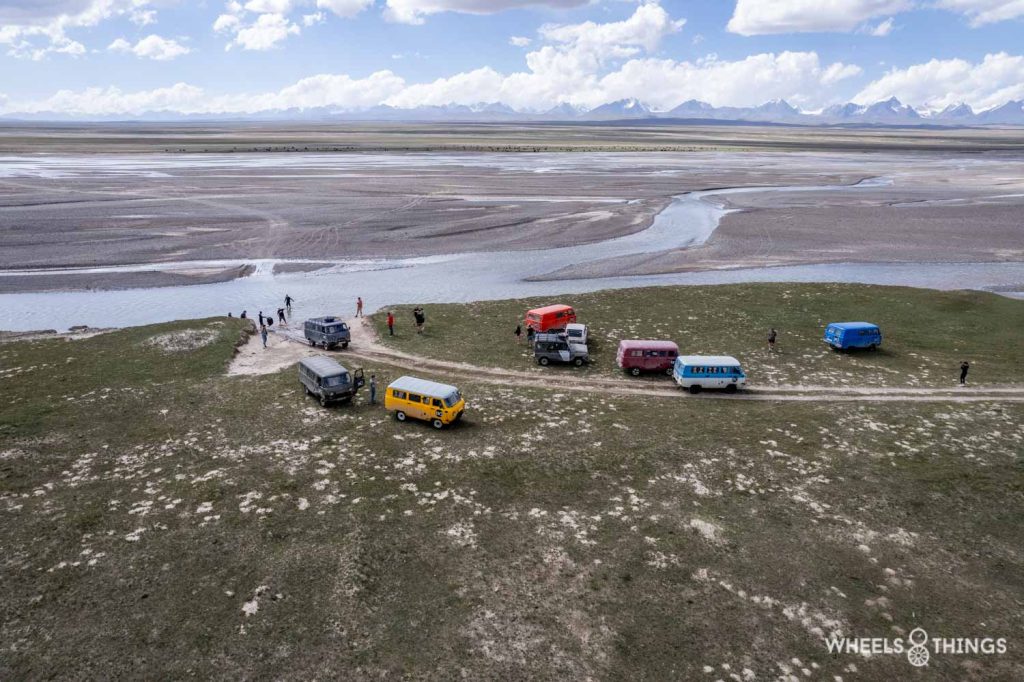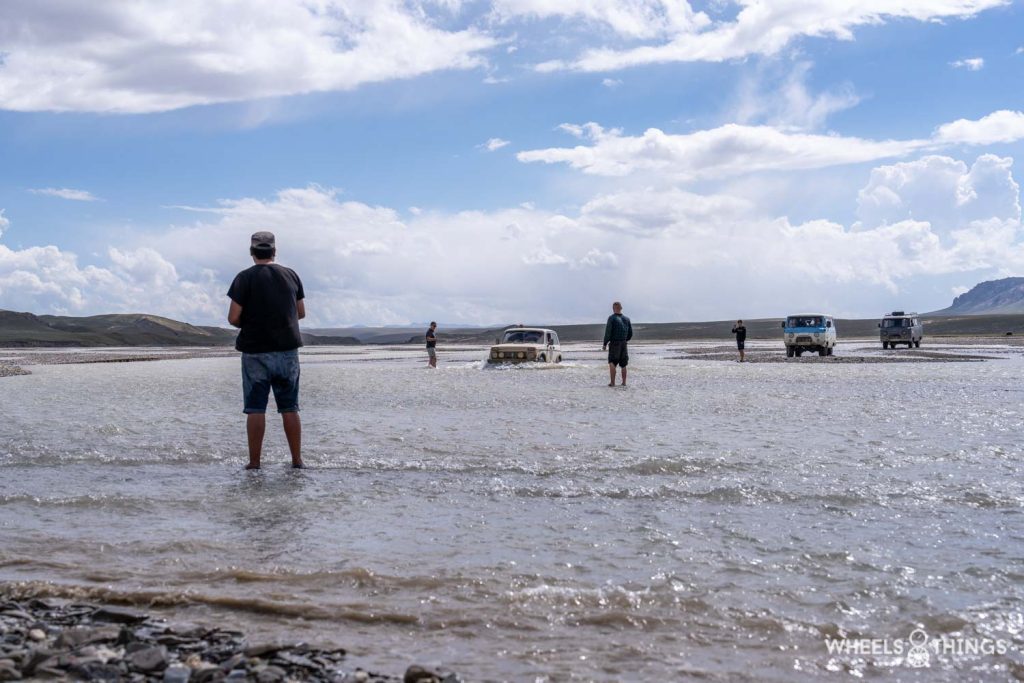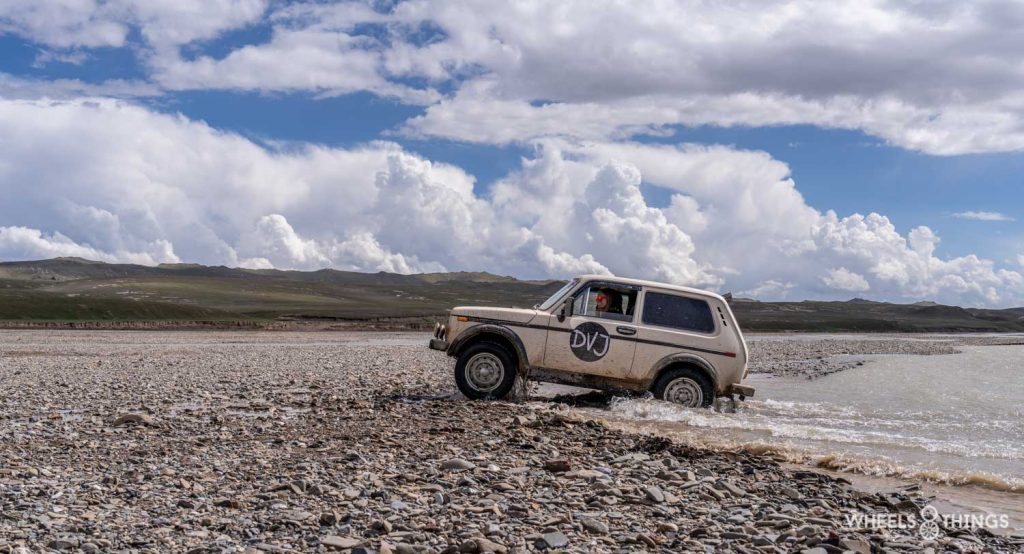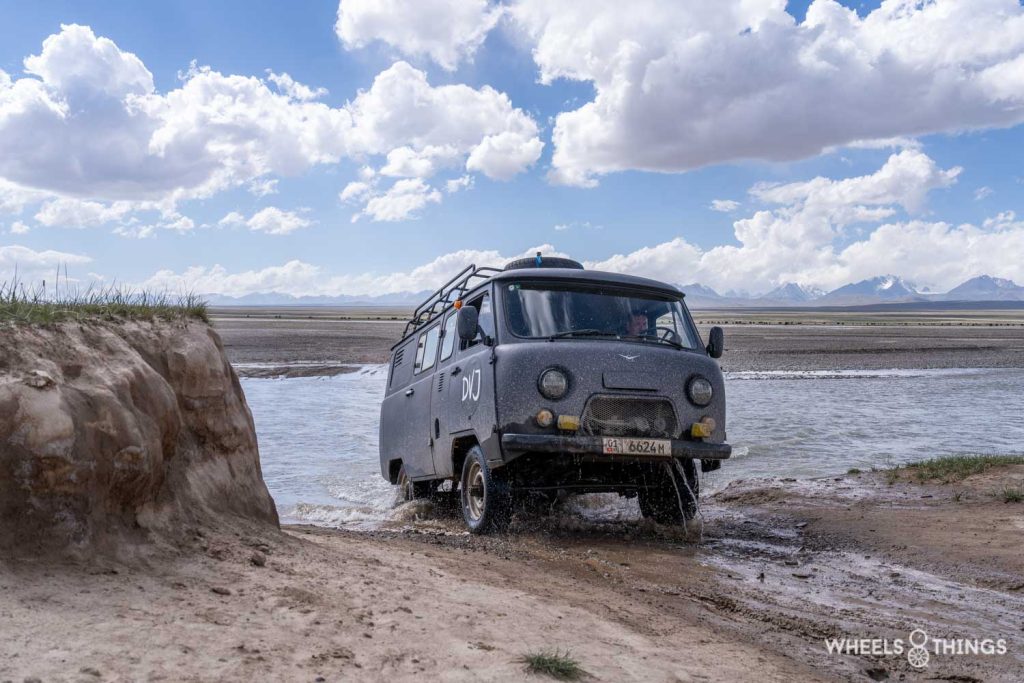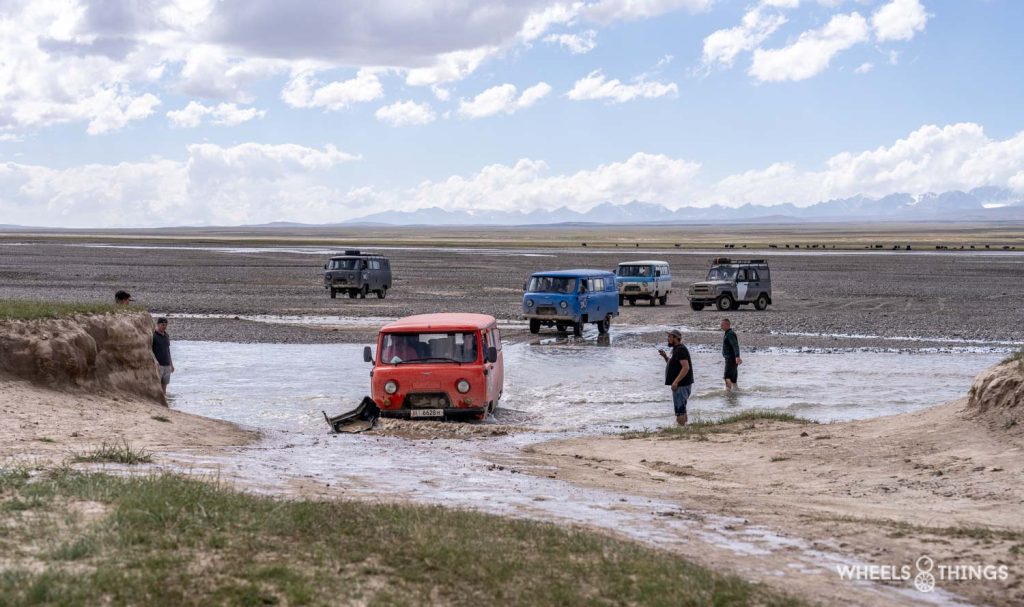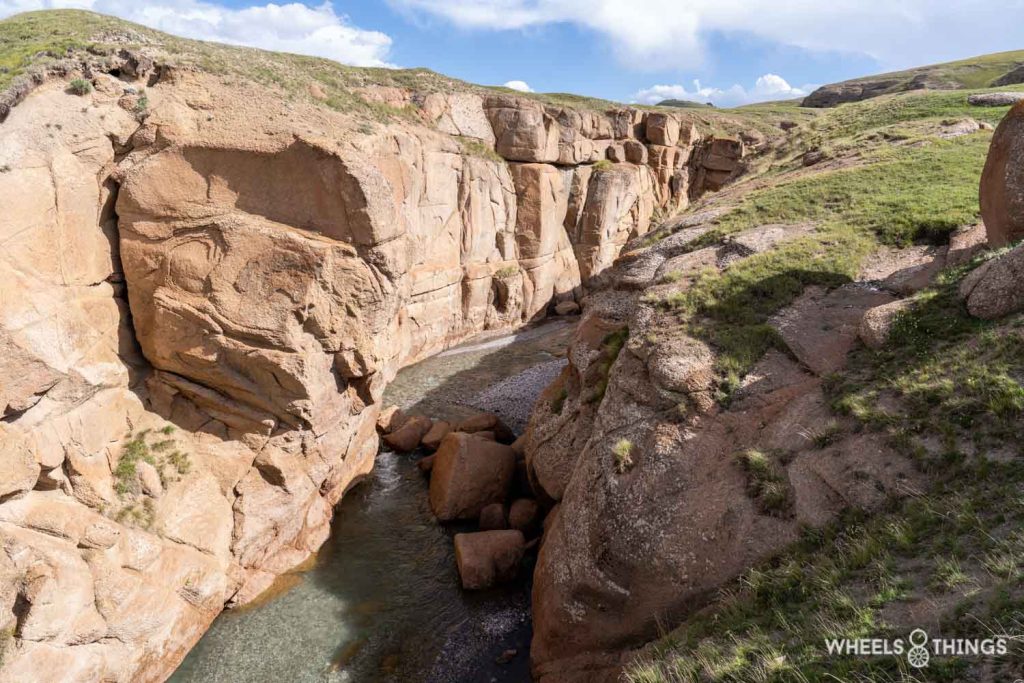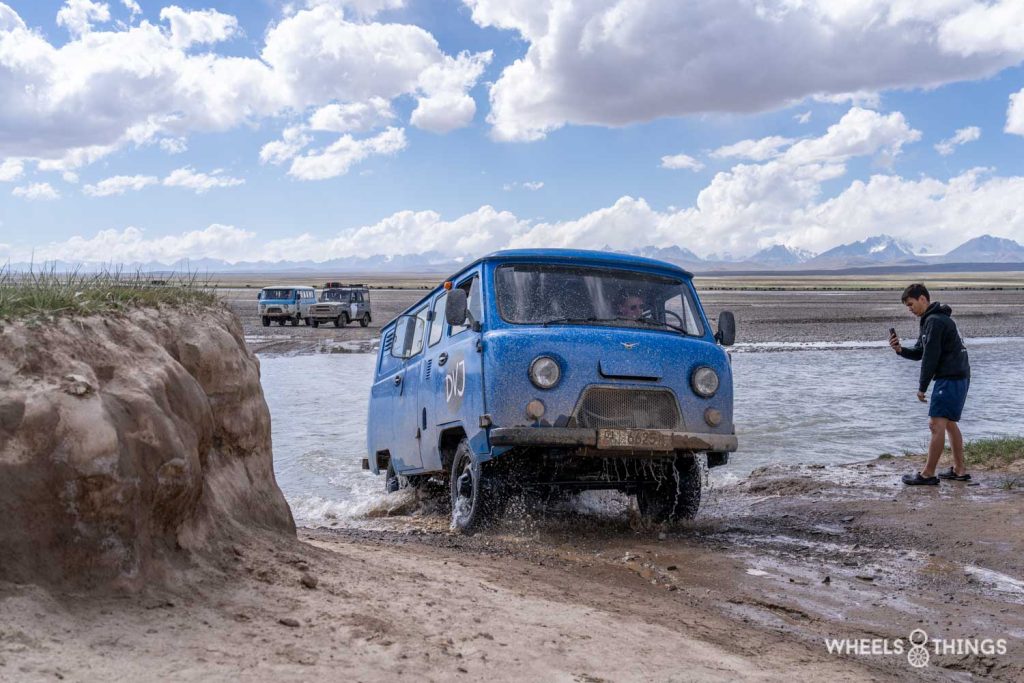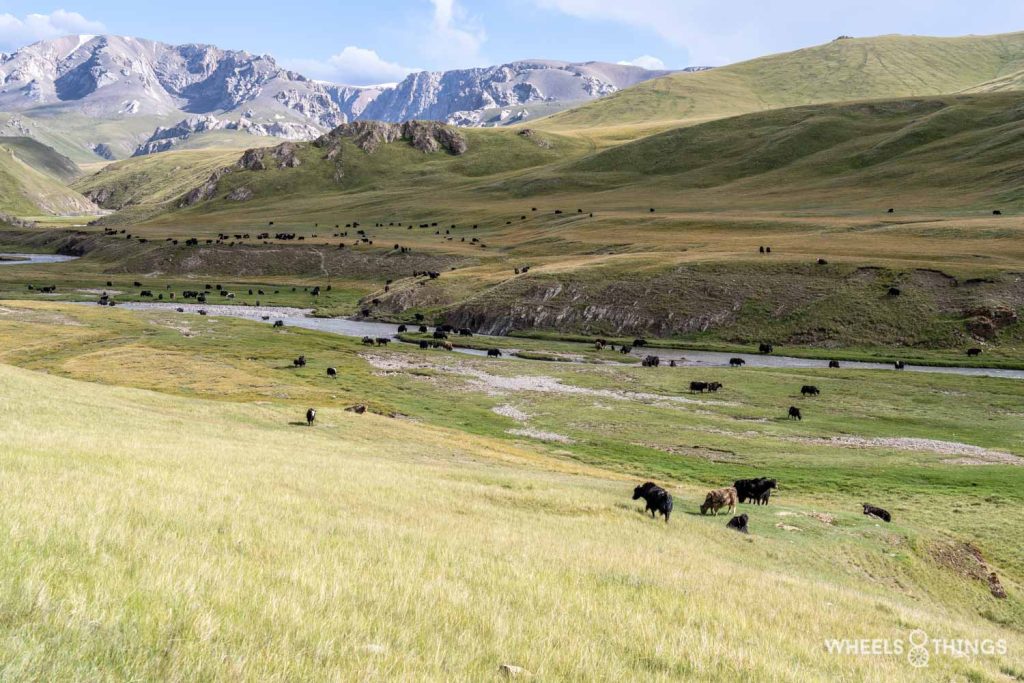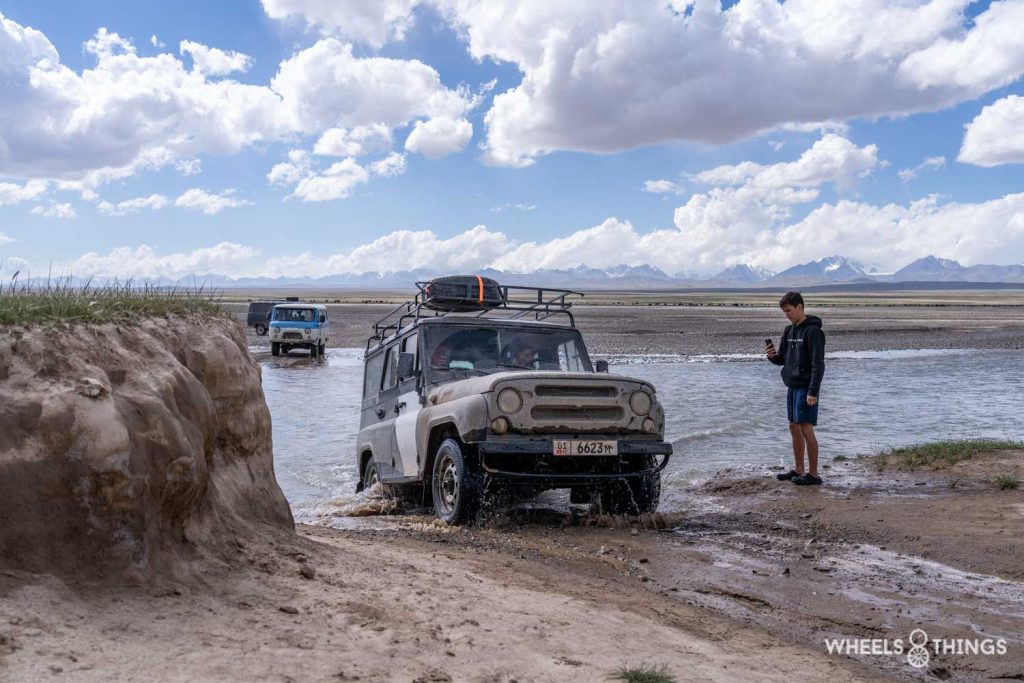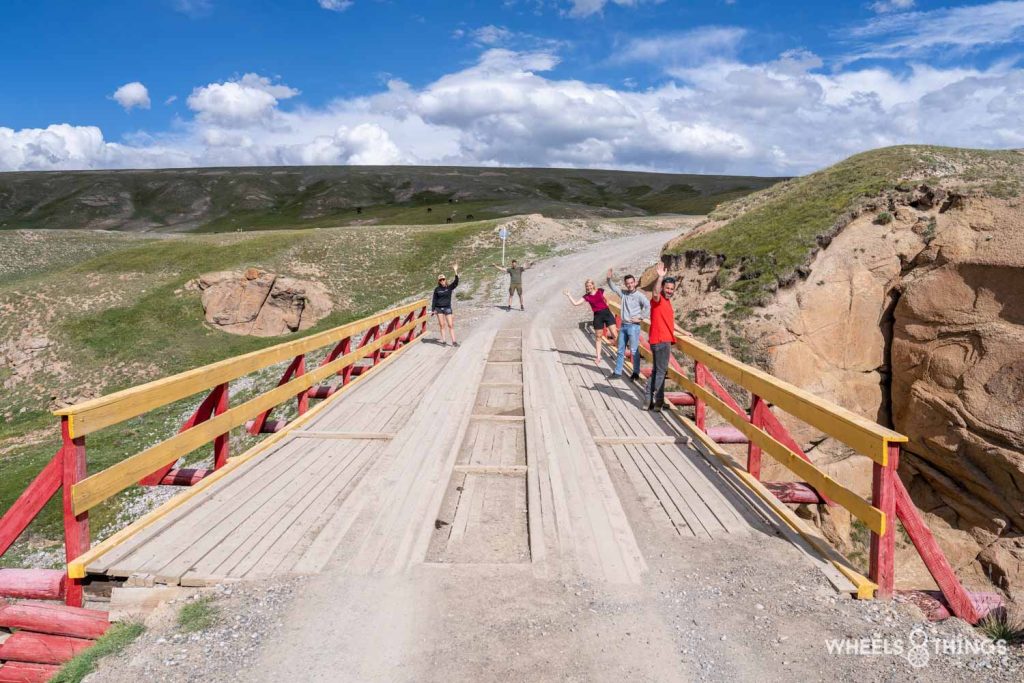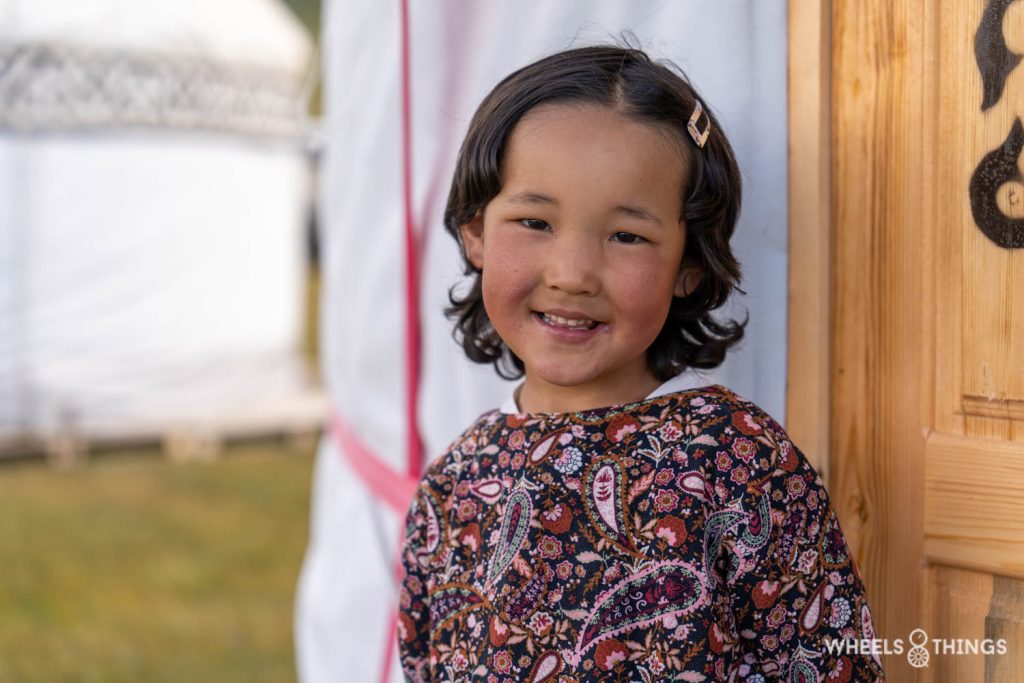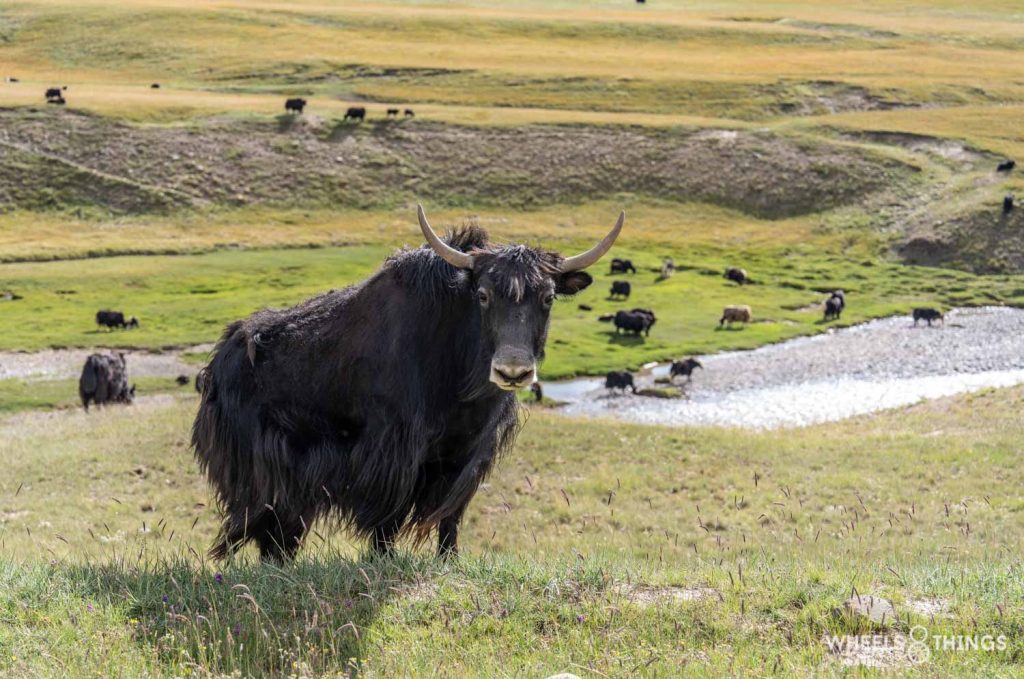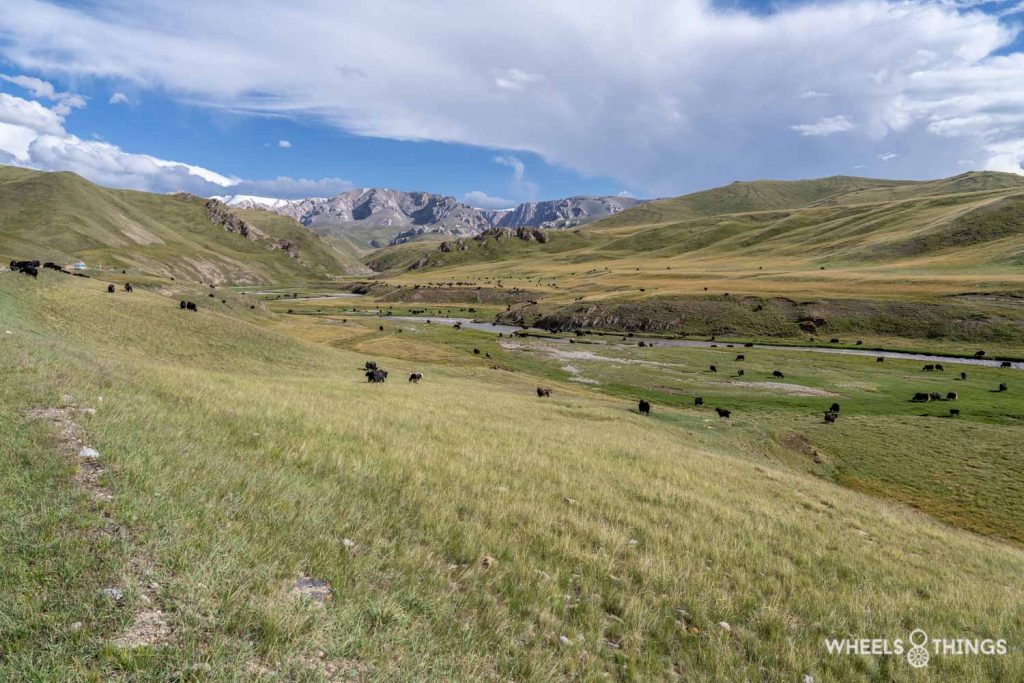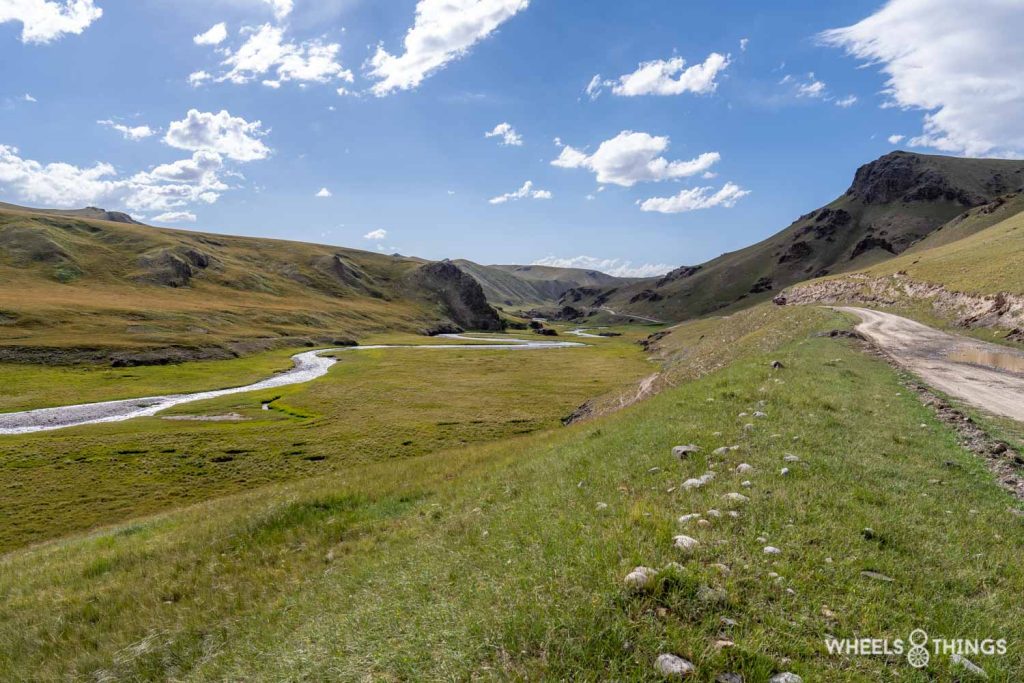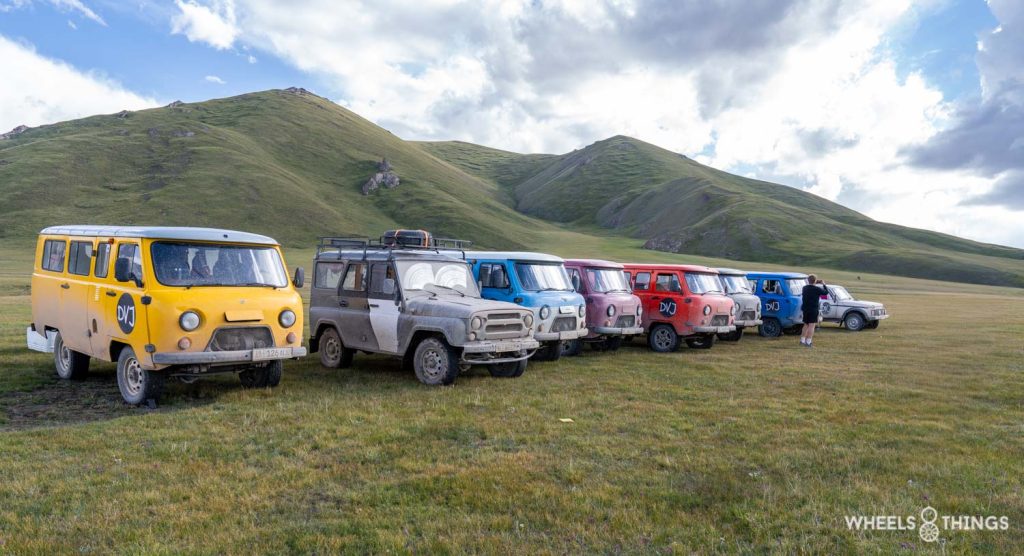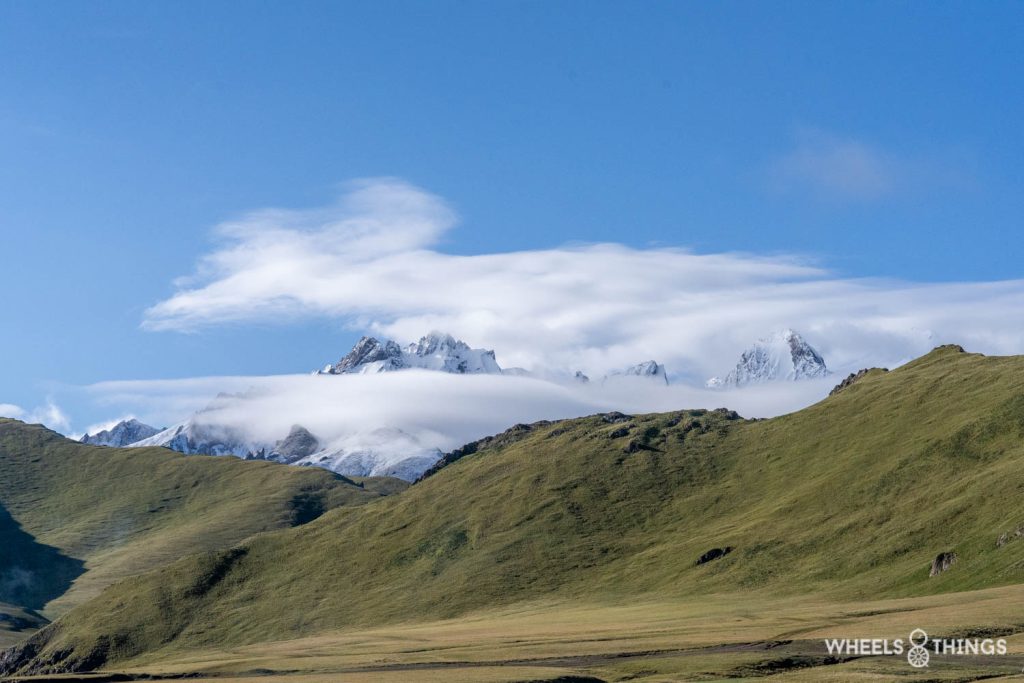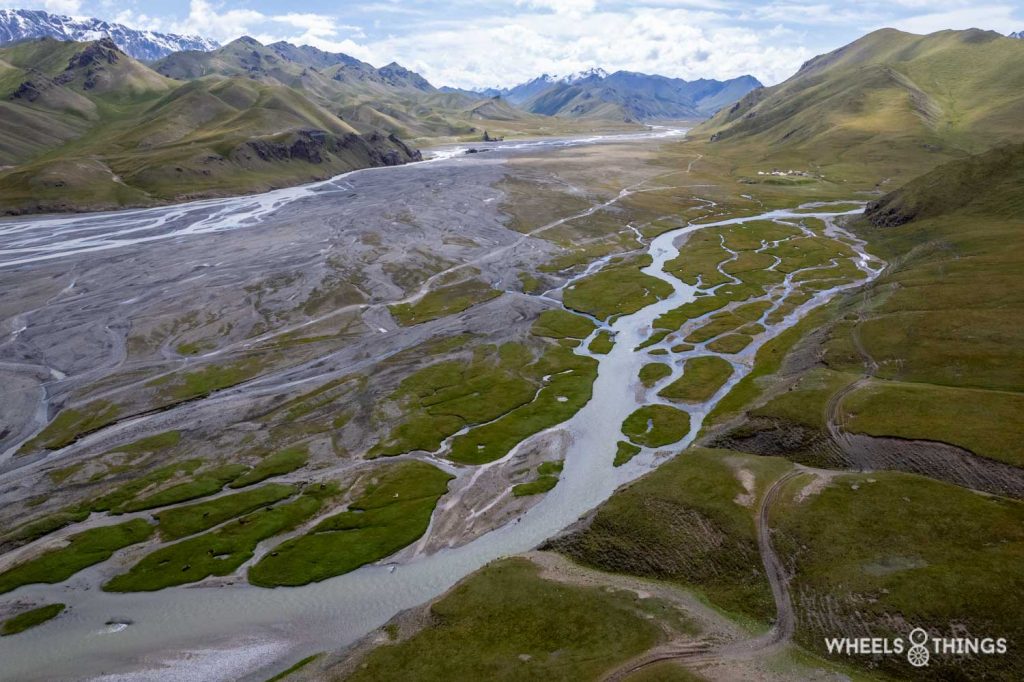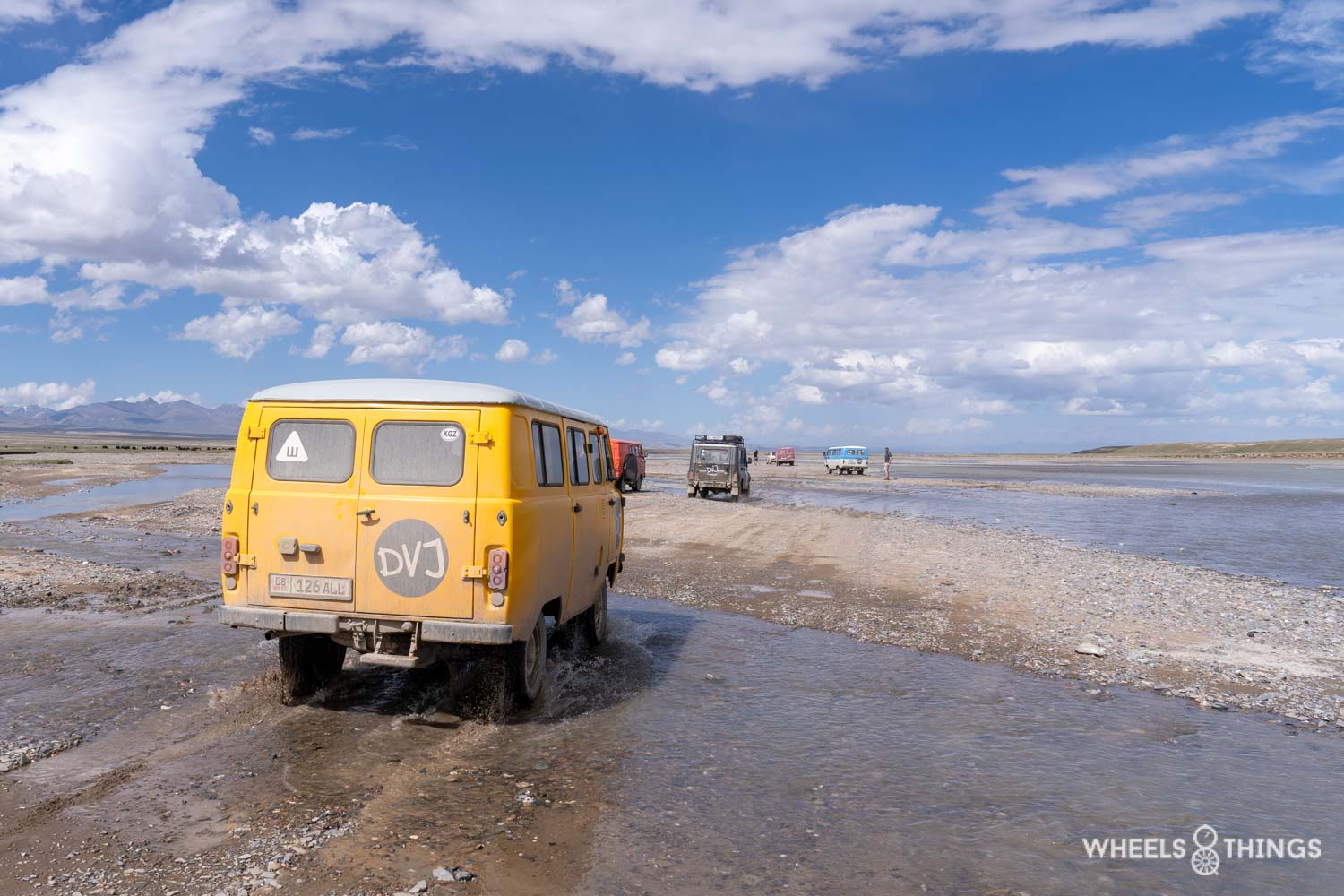MONDAY 15 JULY – 235KM TOWARDS SONG KUL
Last night the three of us slept in the Bukhanka, for this we had to take out a seat. Pitching the tent would not have been easy with all those boulders hence our choice. Well, we were promised an adventurous road trip didn’t we.
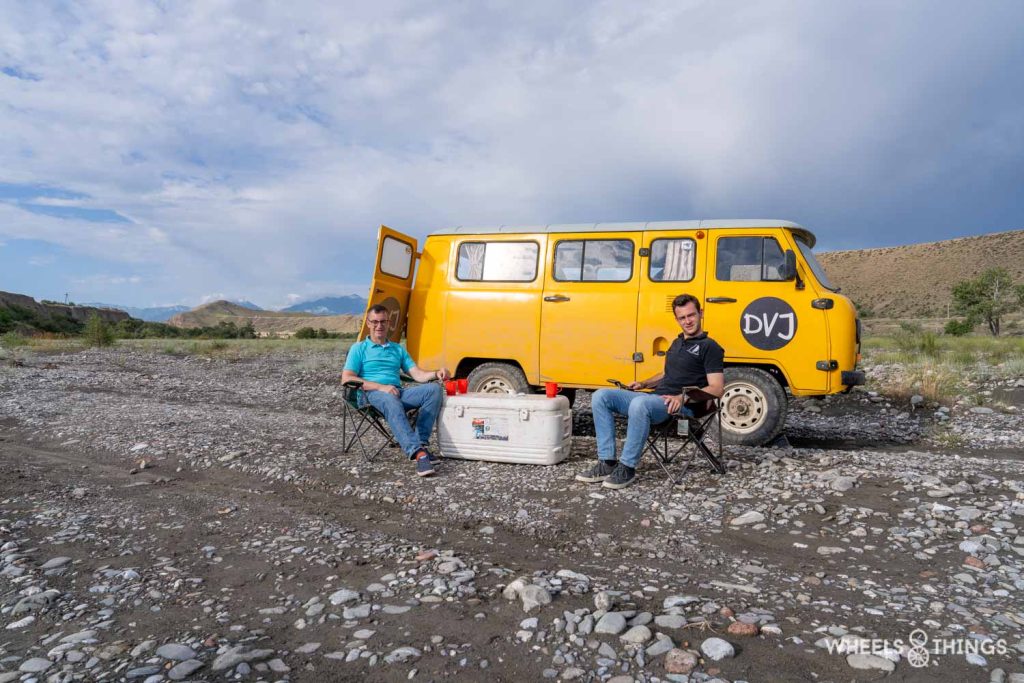
We still had some bread with us so had a quiet breakfast. And quiet it certainly was because we still hadn’t heard from our Dutch friends. Once we were back on the road and had coverage again, we got Urmat on the phone. He was able to reassure us that everyone was fine. He also told us that they might be stuck for a while and that it was best for us to continue our route.
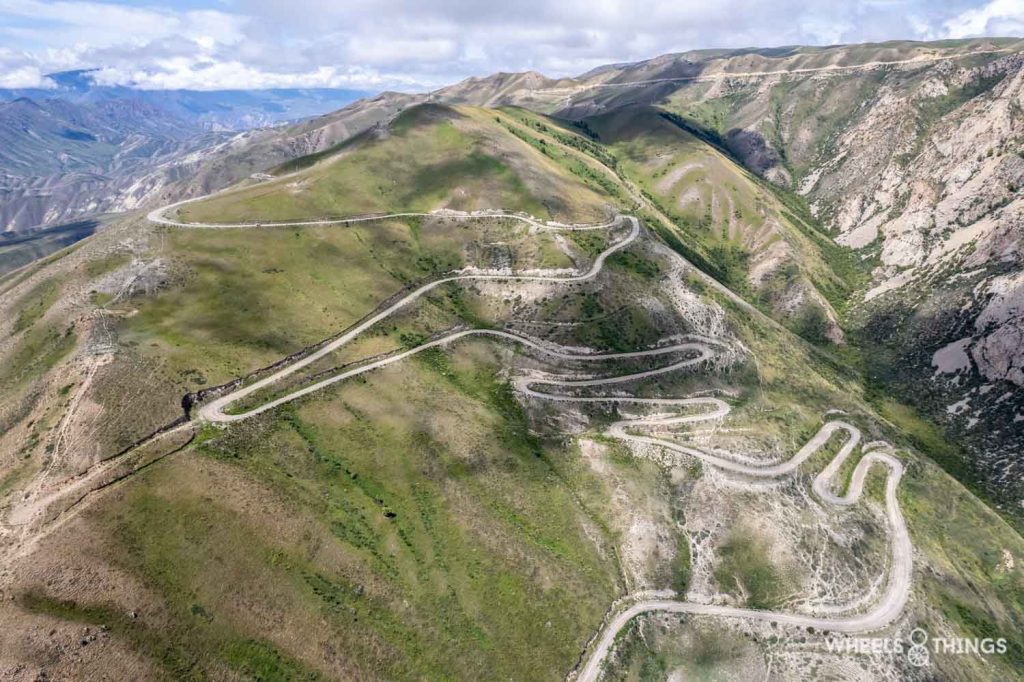
We conquered several mountain passes with the famous hairpin bends. Once you get to the top, the views are vast and exceptionally beautiful.
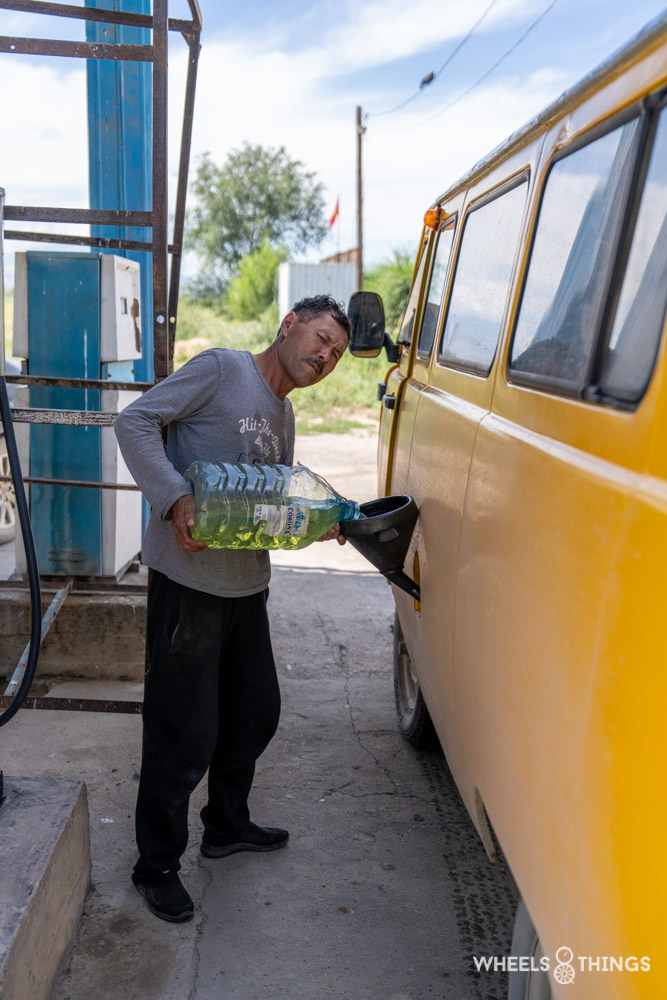
Our Bukhanka consumed about 15l/100km. A quick calculation told us that perhaps 60 litres had been consumed since the last refuelling stop. High time to fill up again, it was a bit in the old fashion way but at least we could move on.
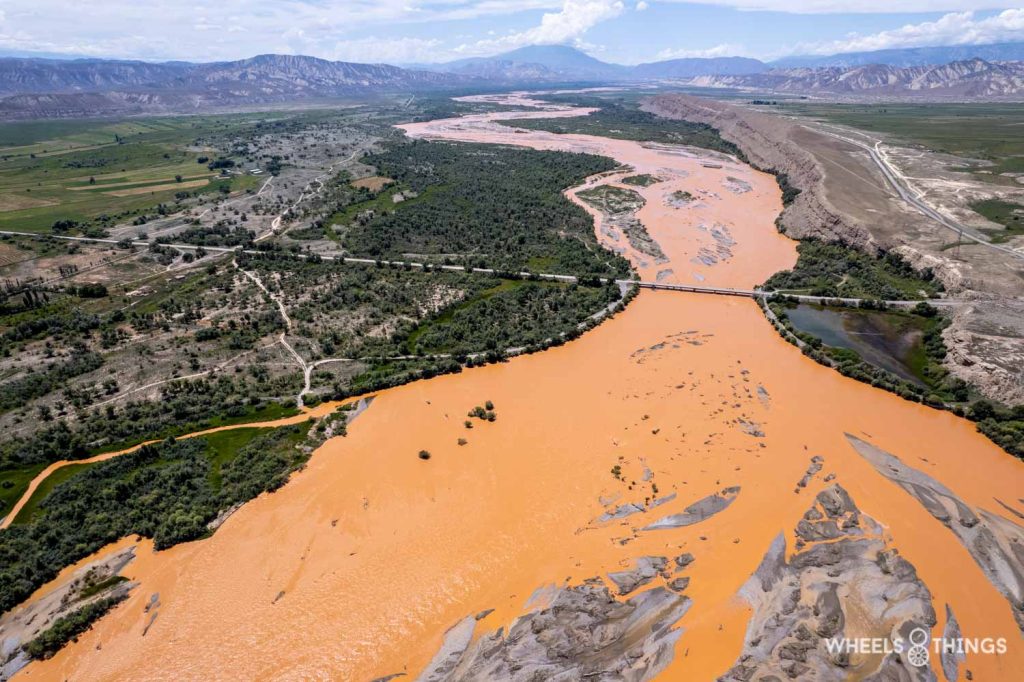
The open plain of this river invited a drone flight, so I was able to take some photos again.

The road to Song Kul was fairly monotonous, lots of open nature with the familiar nice views but otherwise pretty bad (gravel) road. So it was quite nice to be able to have a short chat with the occupants of this group.
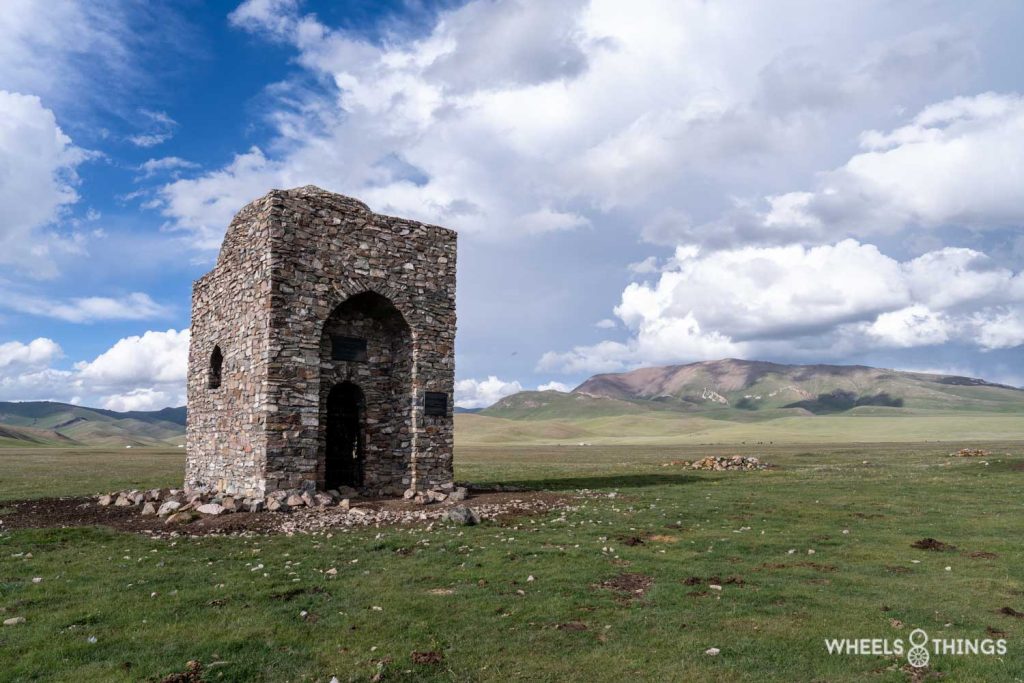
On our way to the yurt camp, we came across this building. We are in Kochkor and it is the Gumbuz mausoleum for Olzhobolot uulu Andash Baatyr. This is in honour of a battle against the Kazakhs in 1847. The road to the yurt camp was treacherously slippery as both myself and Dieter made a 360 with our Bukhanka and when that happens without you expecting it, it’s just nasty anyway.
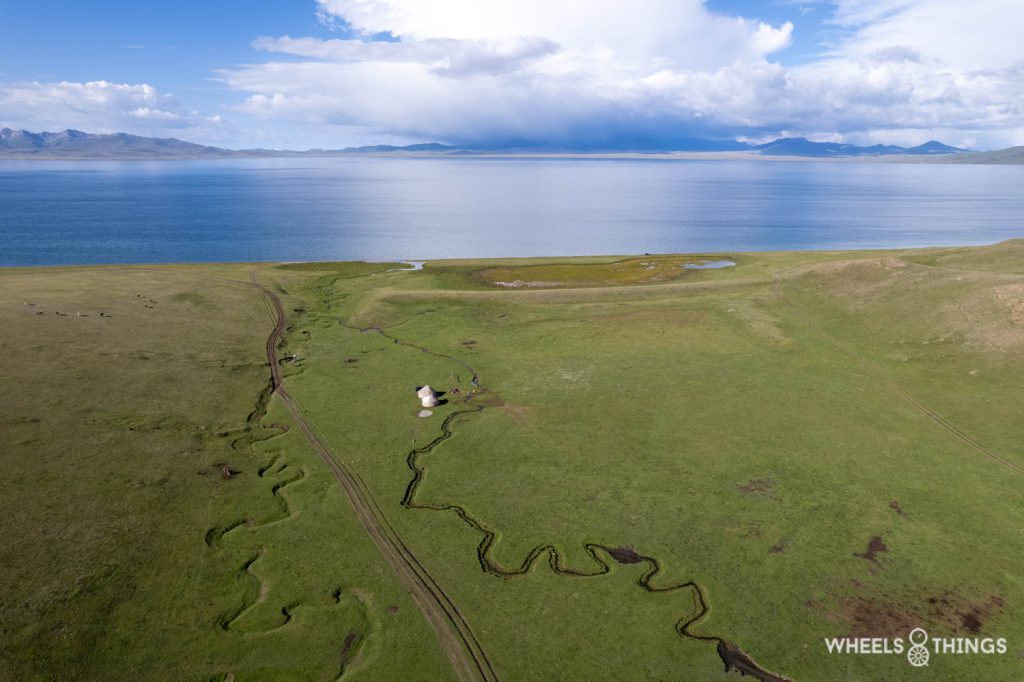
Song Kul is the second largest lake in Kyrgyzstan. It covers an area of 270 km2 and lies at an altitude of 3016 metres. It is the largest drinking water supply lake in the country. Even though it is a very large lake, its maximum depth is only 13 metres.
Yurts
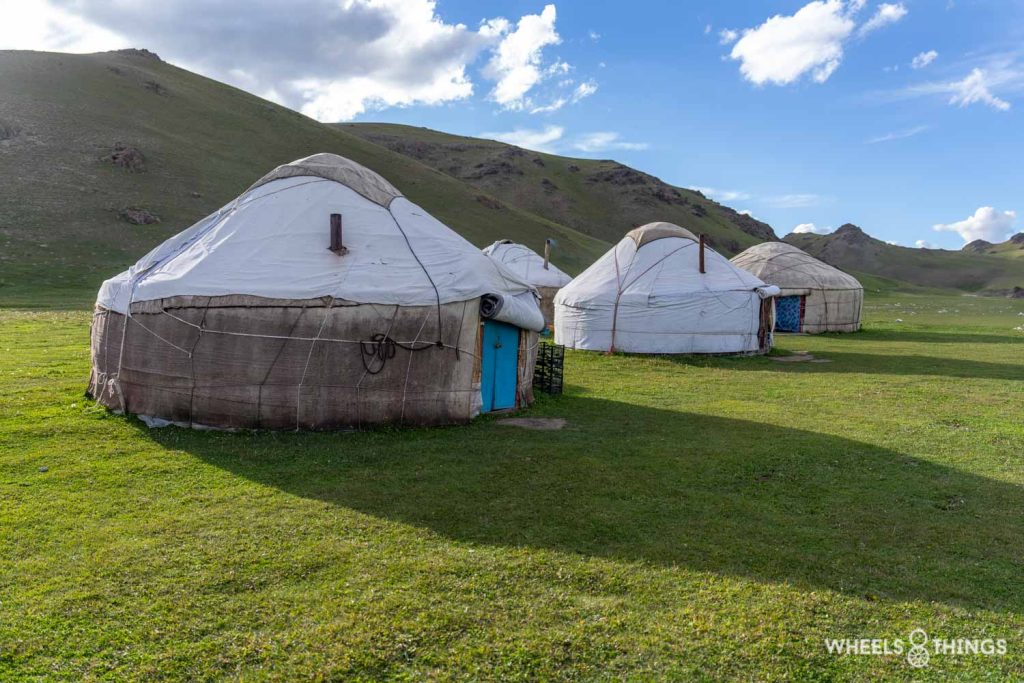
It would be our first oven night in a yurt and we were looking forward to it. I don’t mind sleeping in a tent, but that mat is less comfortable than we had hoped… Normally there would have been a total of 25 people here, but there were only three of us because the rest were still stuck on the mountain. Fortunately, the people from the yurt camp had been notified.
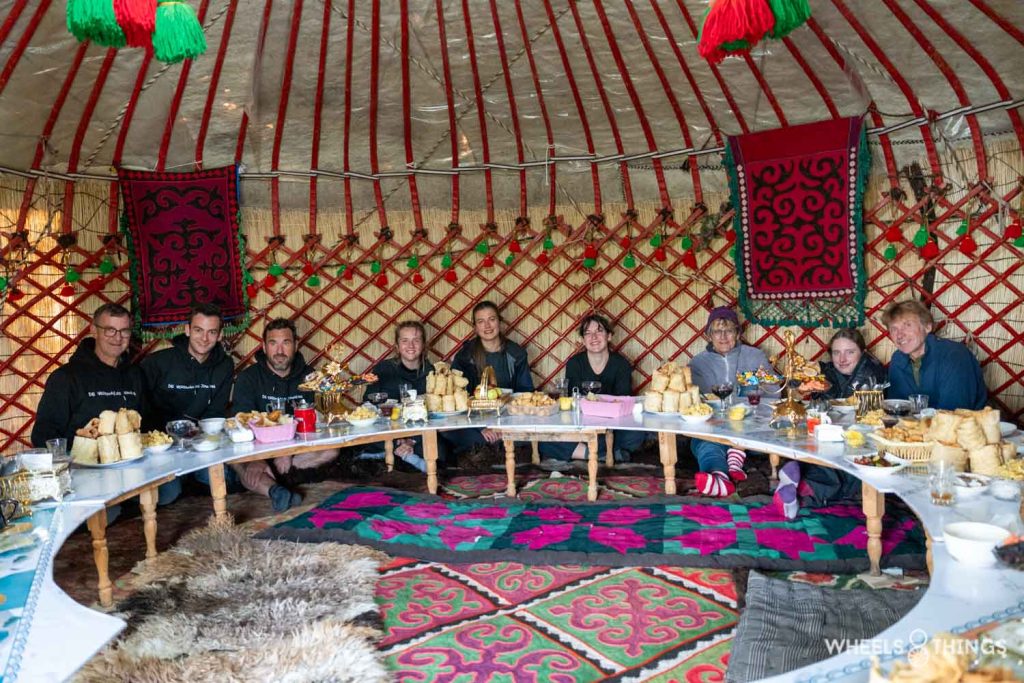
We soon became acquainted with the other ‘tourists’. A Brit with his daughter, a Frenchwoman and three Belgian girls from the Koekelberg region. We could all enjoy delicious soup and hot food together. Breakfast was also served in this yurt.
TUESDAY, JULY 16 – 327KM TOWARDS TASH RABAT
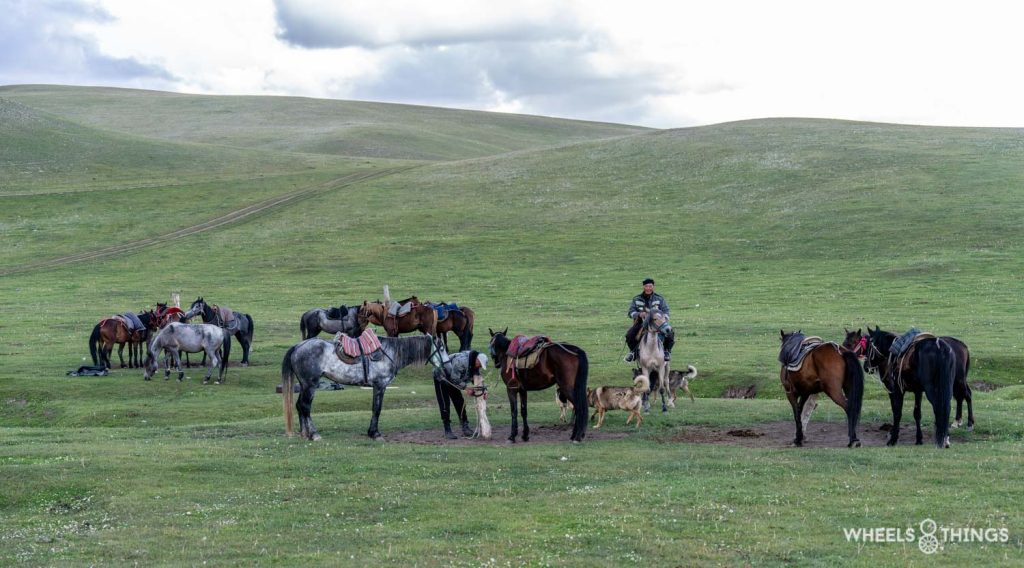
Actually, we wanted to witness Kok Boru, Kyrgyzstan’s national sport, after breakfast. The sheep had already been brought and lay with legs tied together waiting for her end. Unfortunately for us, the weather gods were not with us and we were short on time. The people who were supposed to play Kok Boru thought it was still too dangerous and we had to move on. We decided not to wait any longer and drive on, at least that sheep had been saved.
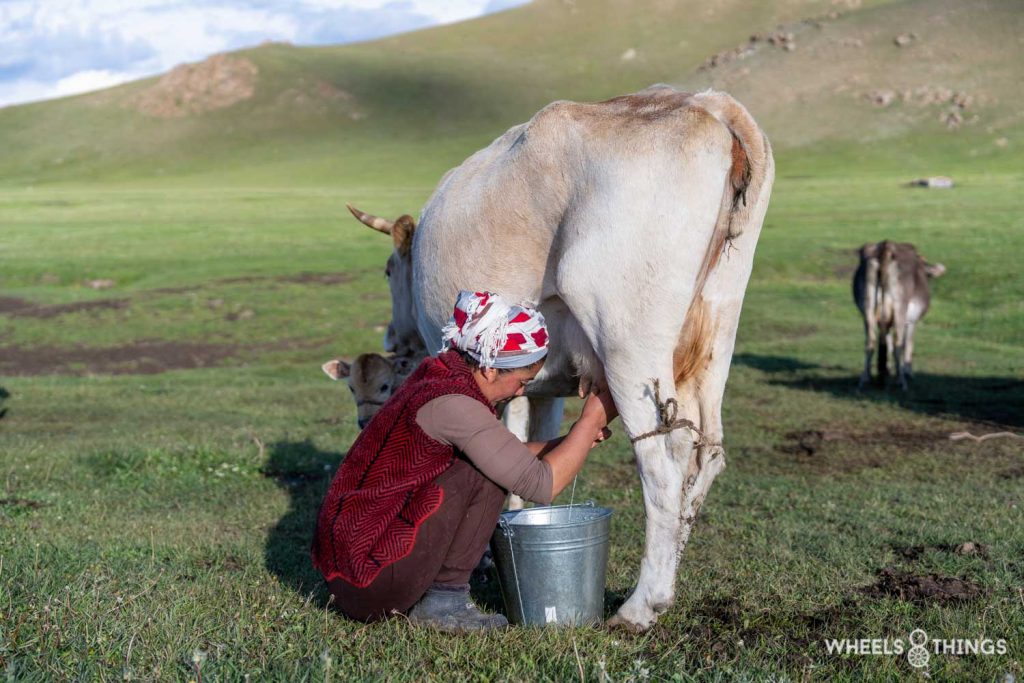
There was a 327 km ride ahead and the estimated driving time was ten hours. Jos is fairly optimistic in this, we must say. So after breakfast, we said goodbye to our hostess who, meanwhile, was milking the cows.
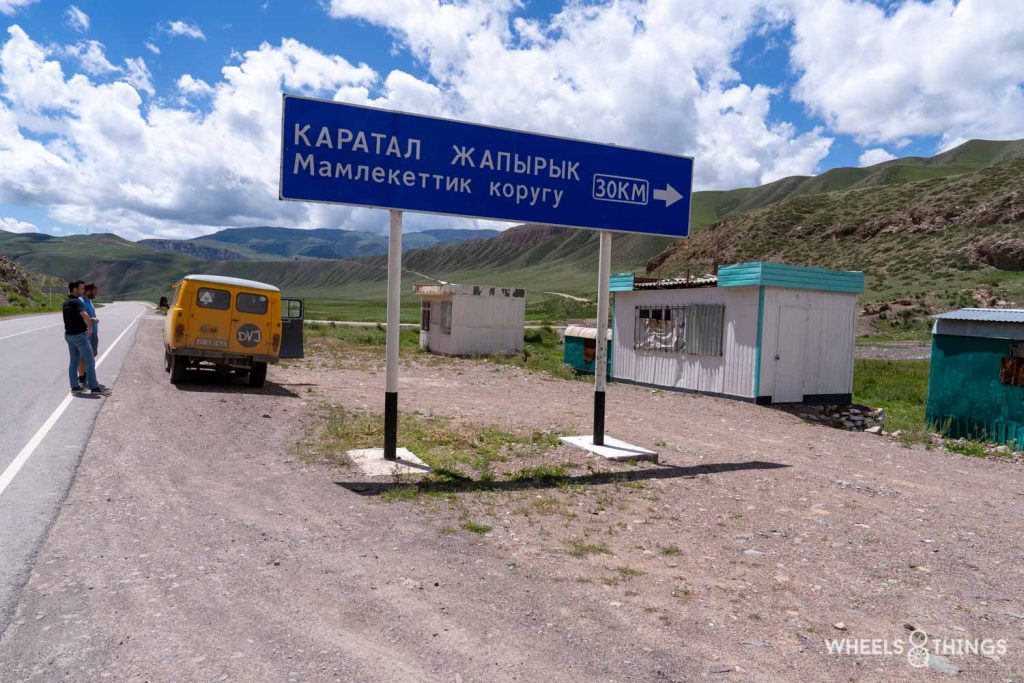
The roadbook mentioned that two mountain passes were scheduled today. After looking at the clock and deliberating for a while, we decided to do only one mountain pass. In hindsight a good decision, more on that in a moment. Above one of the many signposts, there is something at 30km but that is all we can make out 😳.
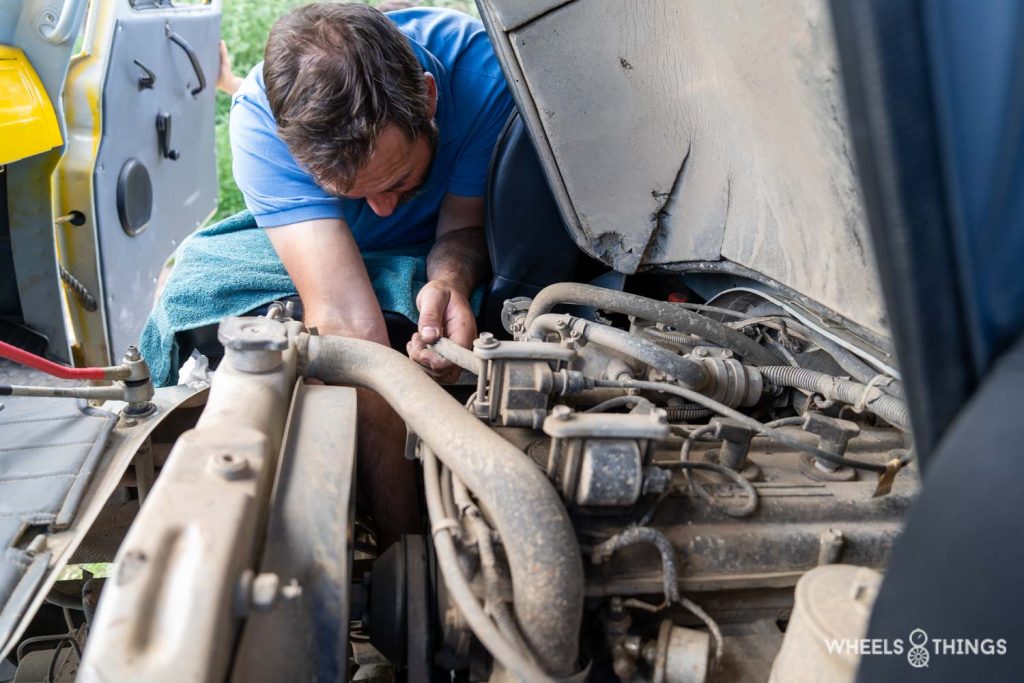
In total, we drove around 3000 km in Kyrgyzstan. The driving itself was always well divided. For one thing, all three of us enjoy driving and it’s also just nice to be able to alternate. At one point Loïc is driving and he remarks that he had heard something unusual. Now something like this in a Bukhanka is not completely abnormal but you become a little more alert. A few minutes later, he noticed that the temperature was rising to over 100°c so Loïc pulled over our Bukhanka.
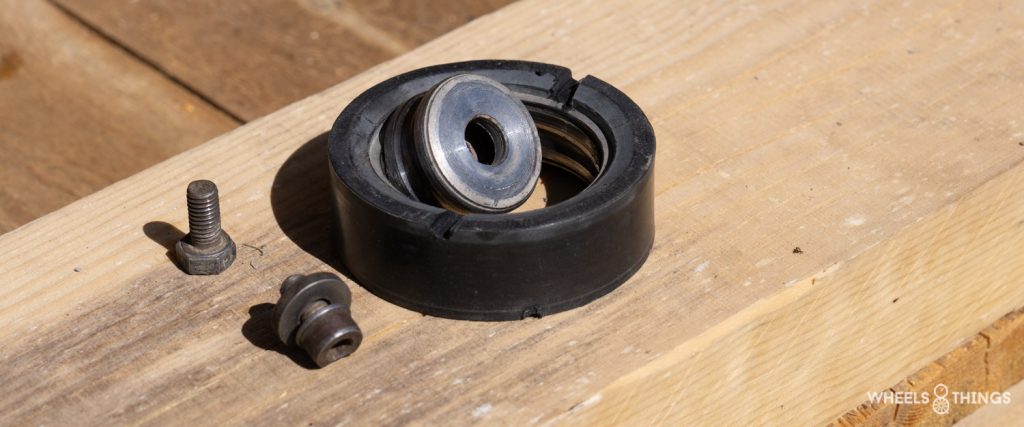
Broken
And yes, we had a problem, a tension roller had burst completely, causing a belt to expire and the engine to have less cooling.
So there you are, fortunately only one and a half kilometres from a village. Dieter removed the defective tension roller from the engine and we went looking for it together. In the village, nobody actually understood what we wanted (barely 2% of the population speaks a bit of English). Finally, we met someone who was able to explain to us hand and foot that 20 km away was a town where we might be able to find that part.
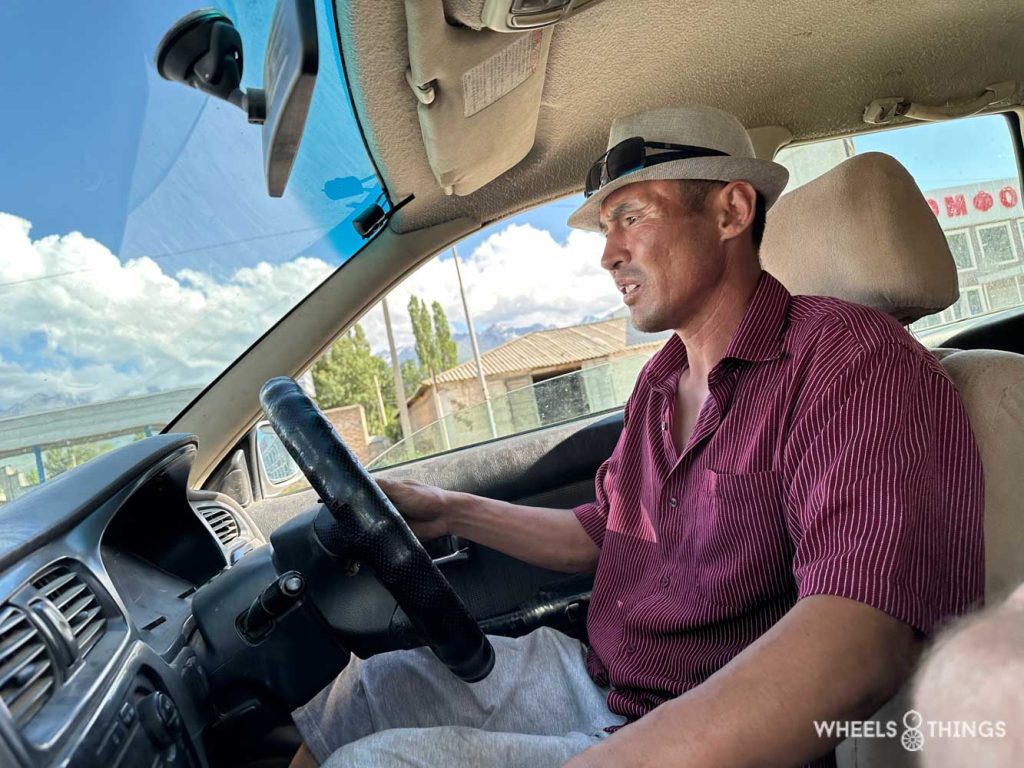
After a bit of discussion, the man was willing to take us back and forth for 1,000 sum. Only ten euros for us but a good deal for him we think. We had noticed for several days that there are very many cars driving around with the steering wheel on the right side. Apparently, one of the reasons would be that some years ago, right-hand-drive cars were banned in neighbouring Kazakhstan. Because of those new rules, many have been exported to Kyrgyzstan.
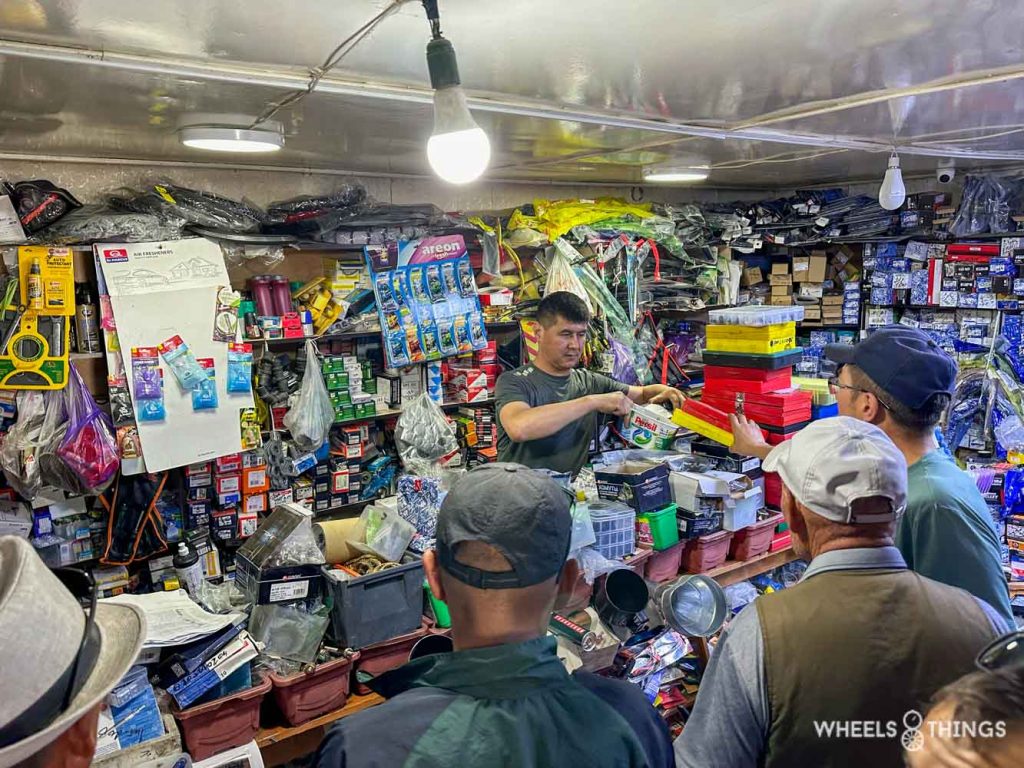
The shop was an outright mess but when we showed the part, the man knew immediately that it was about a UAZ. And yes for barely 300 som (so that’s 3 euros!!!!) we had a brand new tension roller. At the neighbouring shop we then found the necessary bolts for which we were not allowed to pay.
Thanks to Dieter’s skill and a little help from myself, there was only a good 3h30 between breaking down and being able to drive on again. So that wasn’t so bad. Onwards towards Tash Rabat.
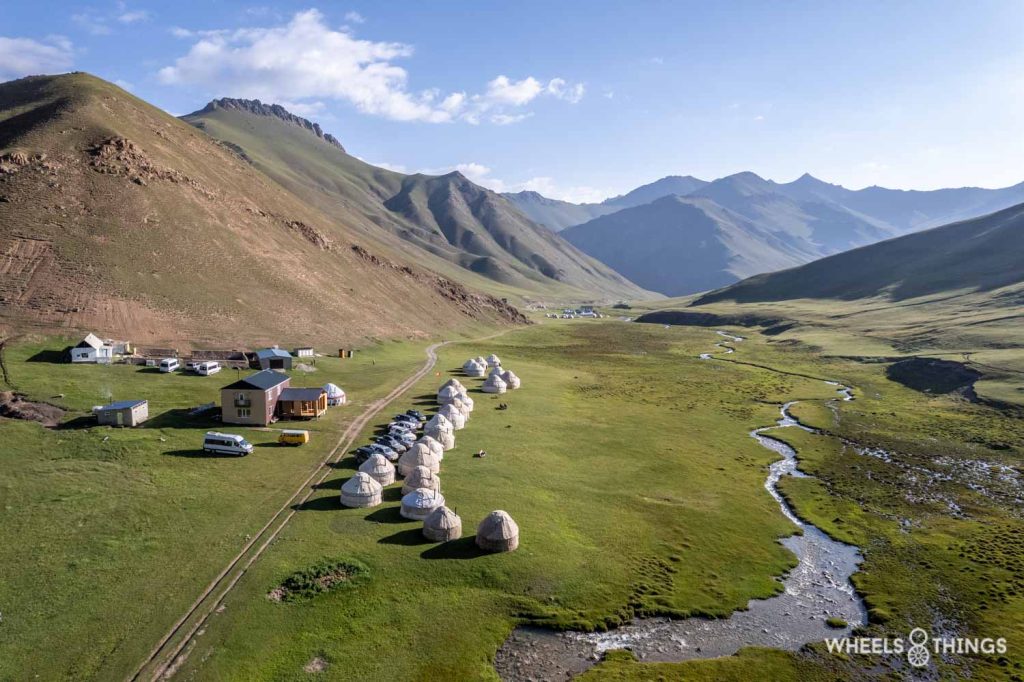
Yurt camp at Nazira
Due to the breakdown, we arrived only around 6pm. Nazira was waiting for us as she and her family had cooked for us. The disappointment on her face spoke volumes when we told her we were the only ones to come. In fact, she had prepared food for 25 people. Communication is not always easy here. For instance, there is no mobile phone reception in this place.
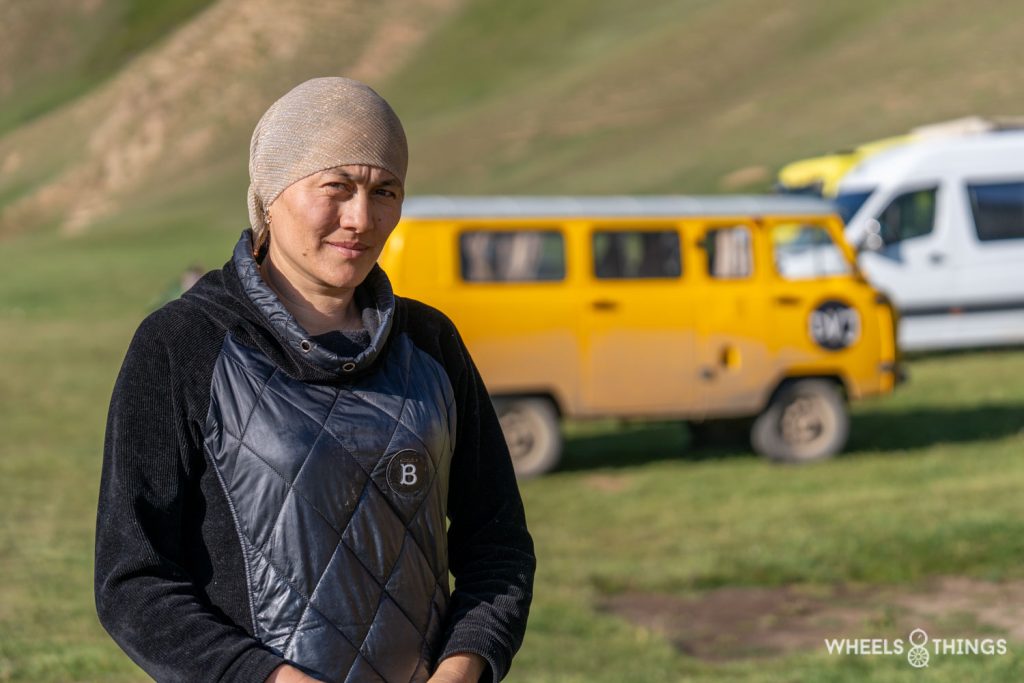
The normal plan was that we would wild camp here. We didn’t really feel like it so we asked Nazira if we couldn’t use a yurt. However, those were all occupied. However a few minutes later, she suggested we come along for a while. We entered her private home and were assigned a very clean room with three beds. In the evening, we were able to use the Hamam, after which we slept wonderfully. Had I mentioned before how hospitable the Kyrgyz are….
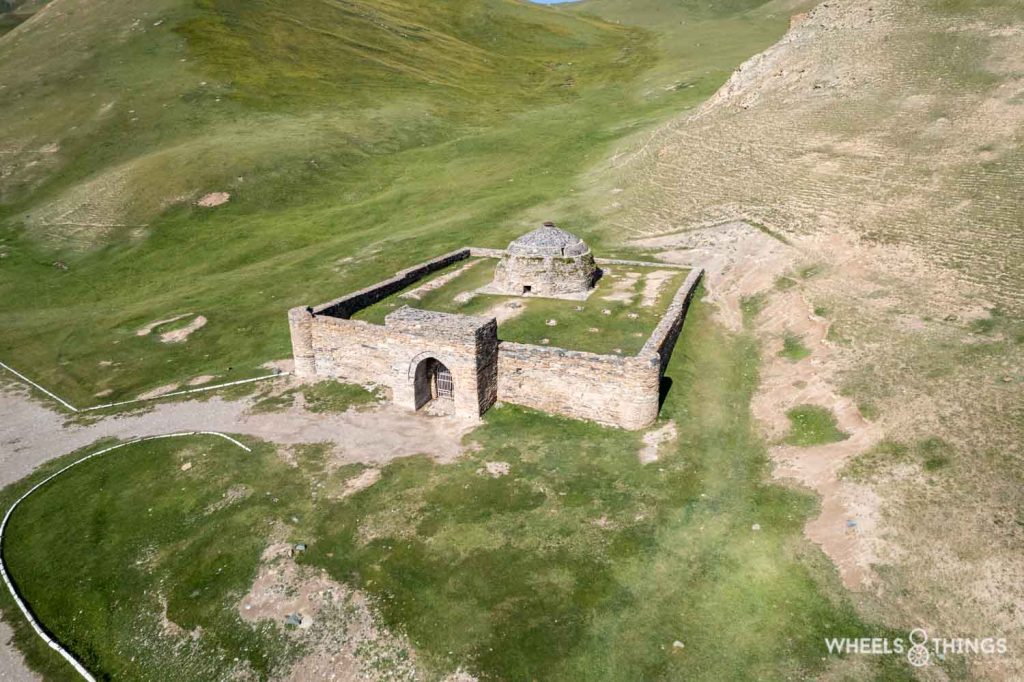
Should you ever visit Kyrgyzstan, this should definitely be one of the highlights. Tash Rabat means as much as ‘stone house’. It is a Nestorian monastery from the 10th century, from the 15th century it was used as a caravanserai. Tash Rabat is said to be the oldest stone building in Central Asia. We are here in At-Bashi district in Naryn province.
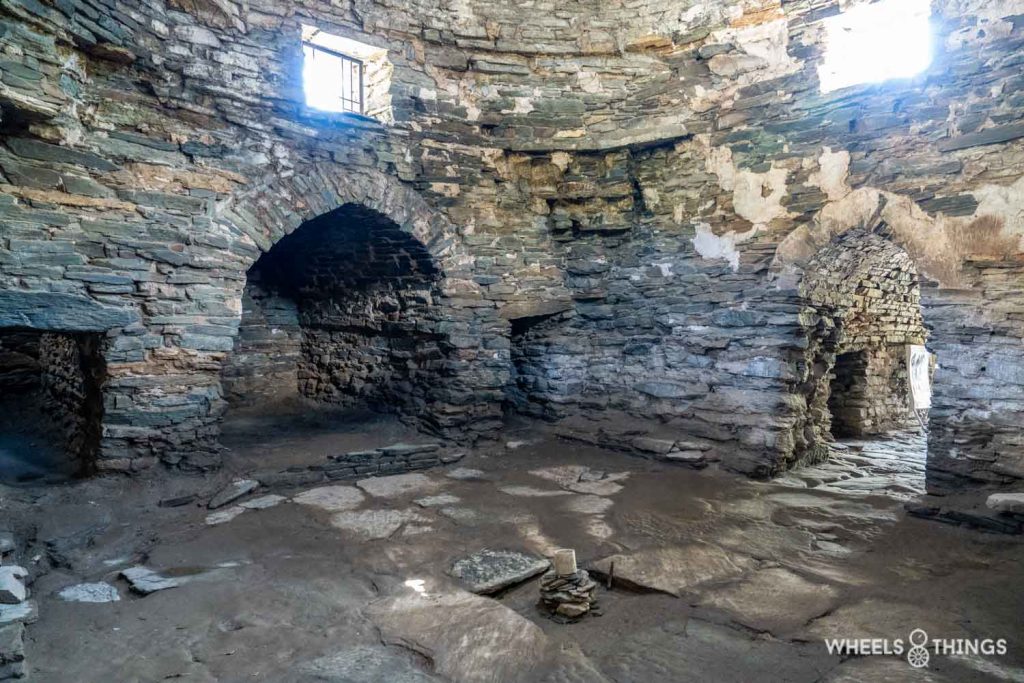
Tash Rabat is historically worth visiting. The building is located on the former Silk Road. Knowing how old the building is and what its functions were will definitely give you a better impression of what it was like here once in the past.
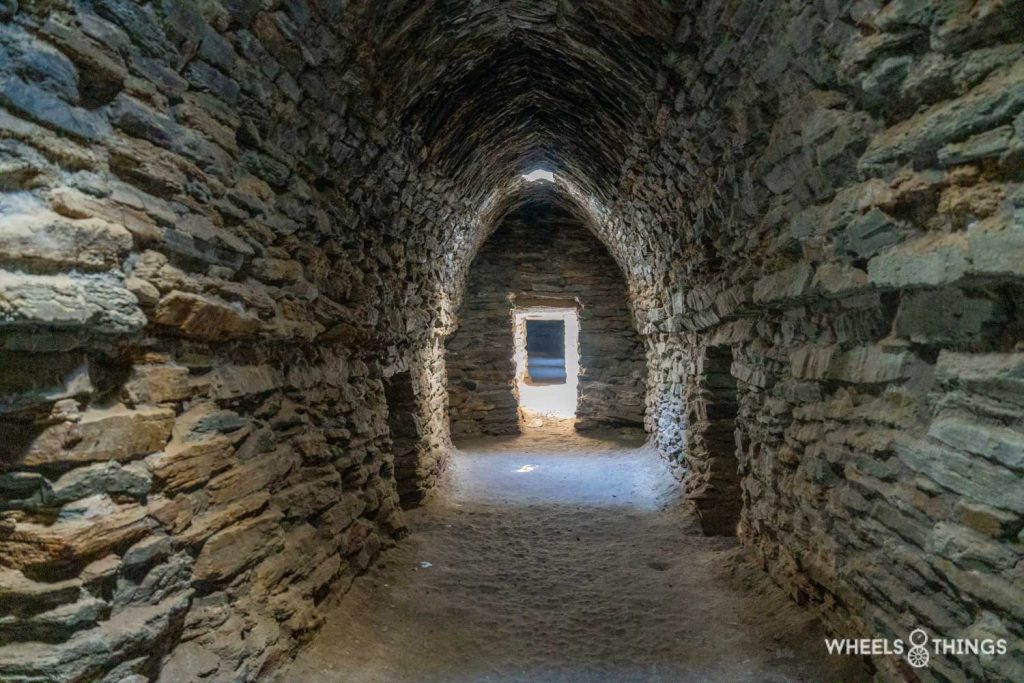
Try to visit it early because this is where they tip off whole busloads of tourists. We were luckily ahead of them. The entrance fee is 150 som so you definitely shouldn’t leave it at the price of that.
WEDNESDAY 17 JULY – 205KM TOWARDS KEL SUU
Today it was reunion time again with our Dutch friends. We agreed to meet at a certain coordinate around 11am.
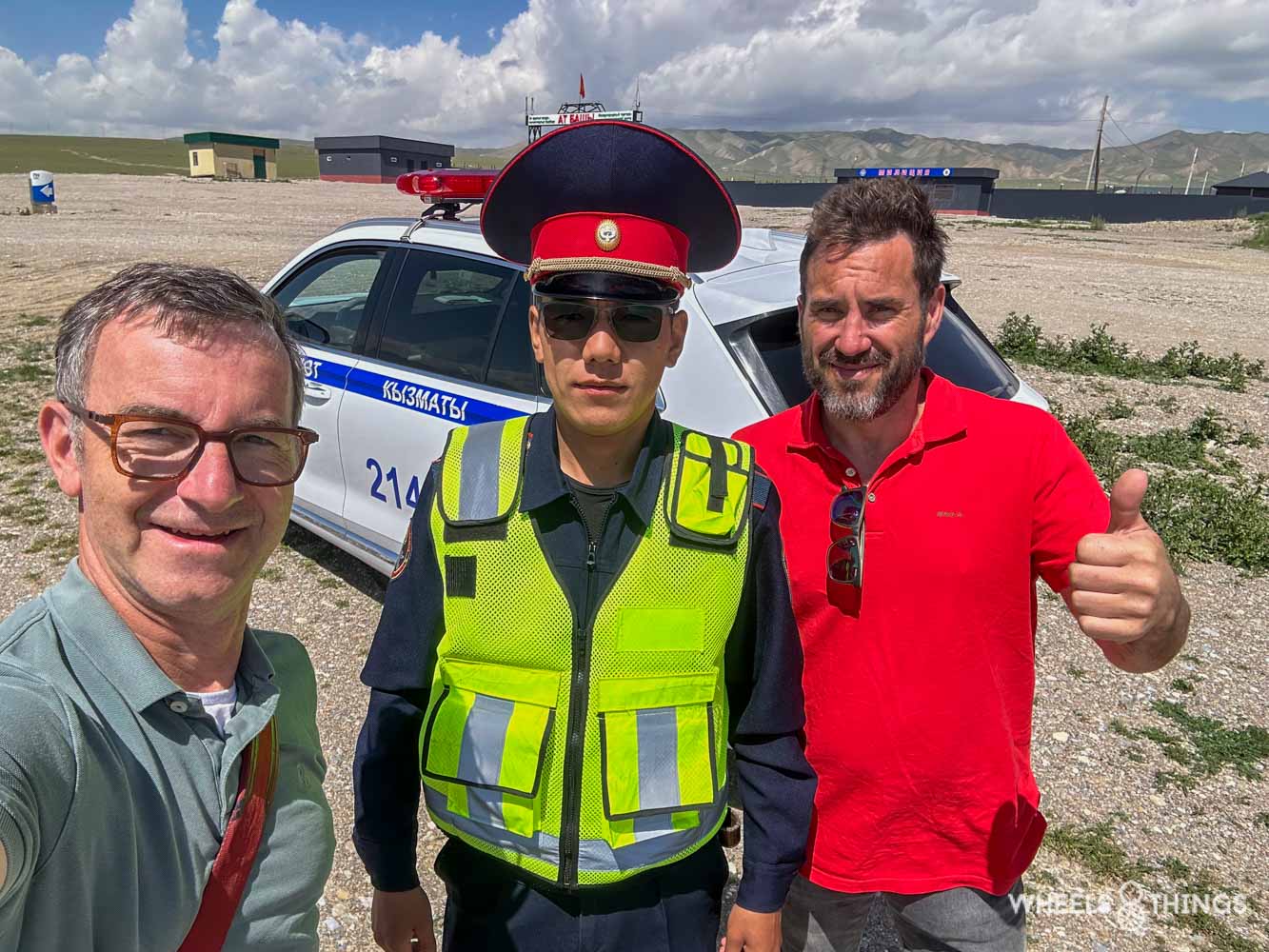
Fuelling, it remains a tricky thing
But… we still had to refuel. We passed by an all-new petrol station where we were able to socialise with the local police. We were able to have a chat via Google Translate about his Geely car that looked tellingly like a Volvo (how could that be).
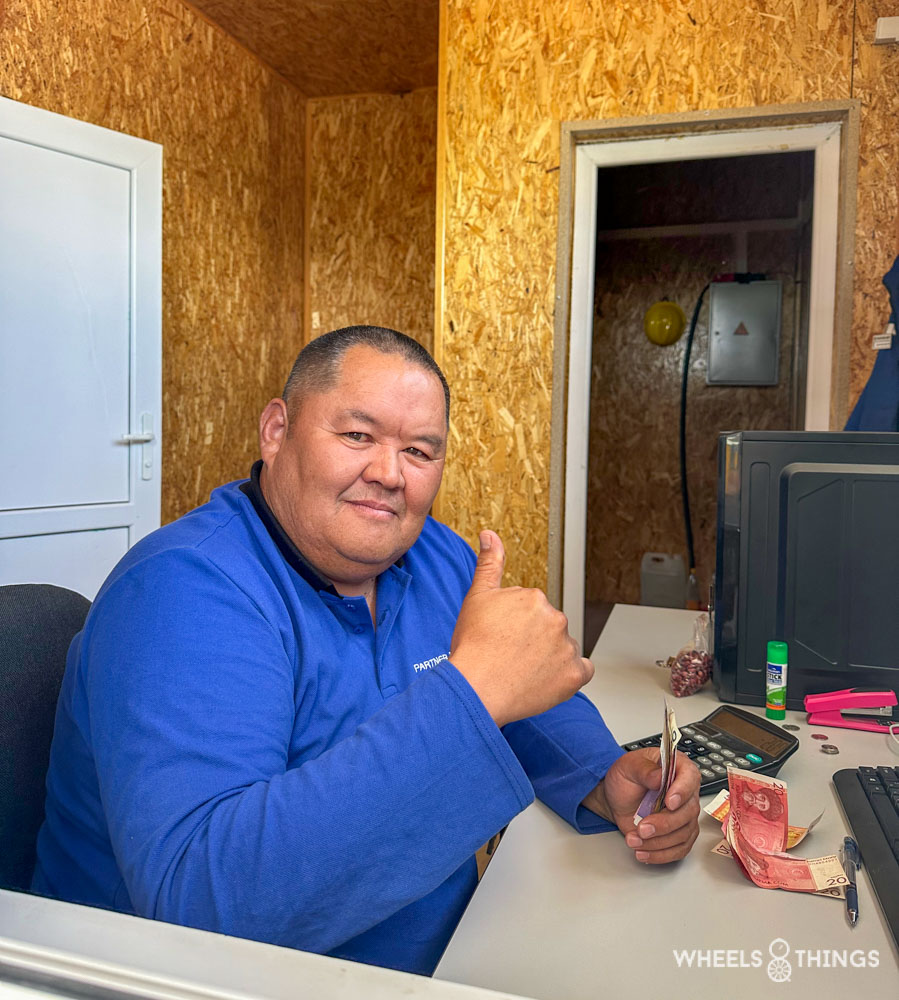
At most filling stations, they ask in advance how you want to pay. Not here…
We filled up for 1340 som and Dieter went to pay with his card. However, it turned out that their payment terminal had not yet been installed. So we had to pay in cash. We put everything we had together and we arrived at 1130 som. Using Google Translate, I explained to the man that this was really all the money we had. Dieter had disappeared in the meantime 🤔. The atmosphere became slightly grimmer because at some point I got the message ‘I want your money bro’. I called out to Dieter if we still had a bottle of beer in our cooler. When I handed over the bottle of beer, the atmosphere turned and the pump attendant burst into laughter. He even wanted his picture taken when I asked 😁. Moral of the story, you can pay for petrol with beer 🍺.
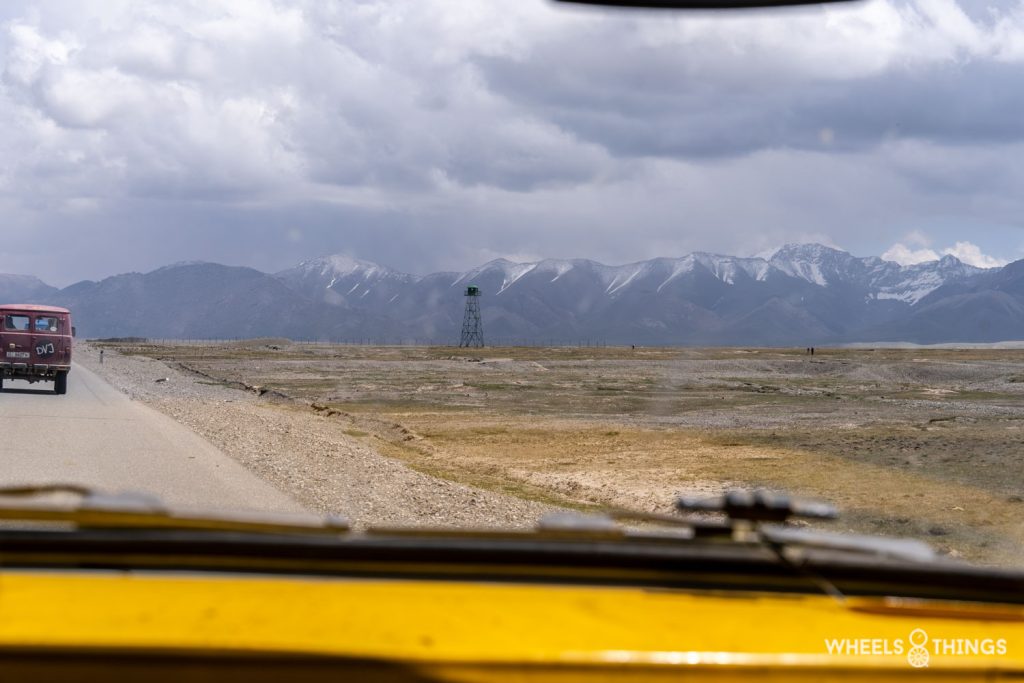
Once we fraternised we drove towards the checkpoint. We had been ordered NOT to take pictures of the checkpoint or the people who would be working there. So we listened nicely. After passport control and a cursory check of some cars, we were able to move on. Once past the checkpoint, I took a quick photograph of one of the many guard towers as well as the barbed wire fences. The no man’s land zone we were in is said to be between 60 and 100km wide before you reach the effective border.
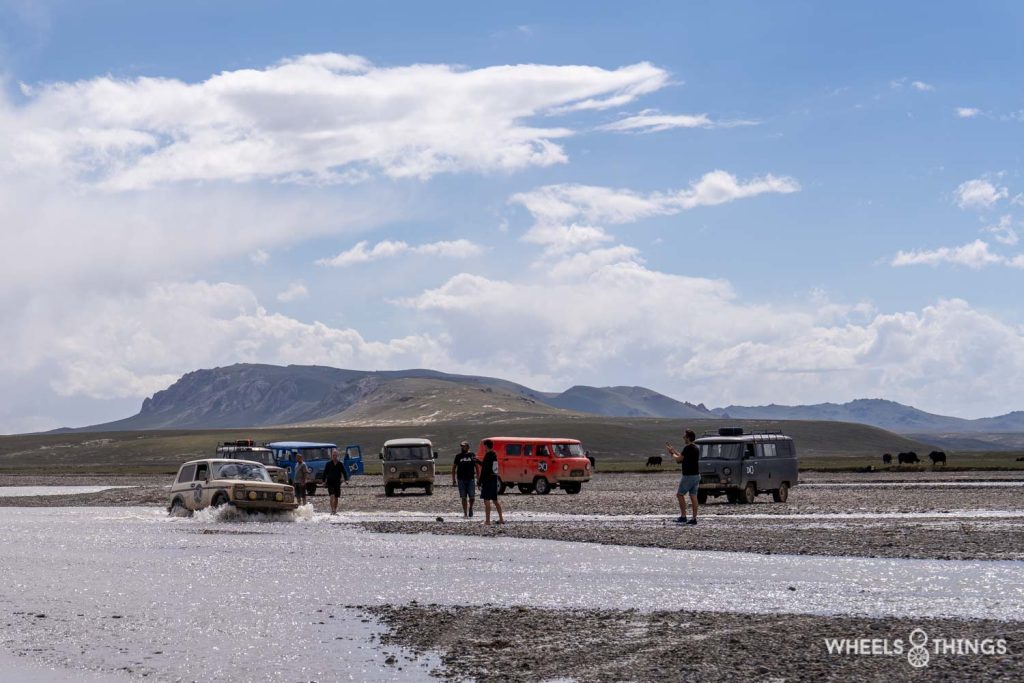
The drive to Kel Suu was smooth and crossing a fairly wide river was a nice change from the driving.
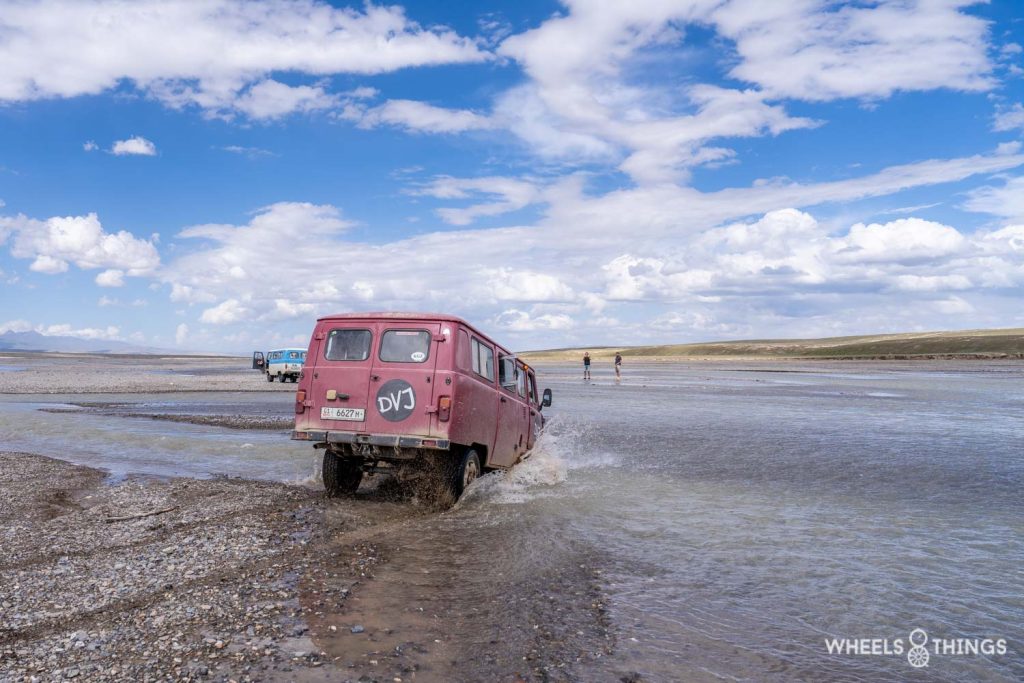
Here and there, the water was a 60cm deep.
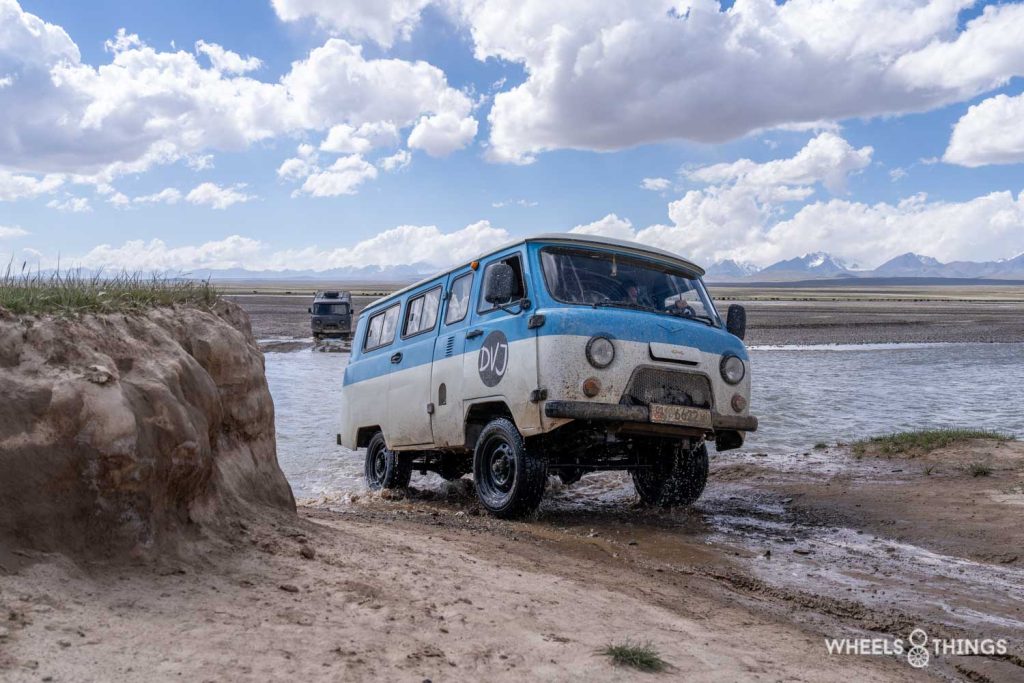
But one by one everyone got through and through. Again, we had something to talk about later in the day.
Kel Suu
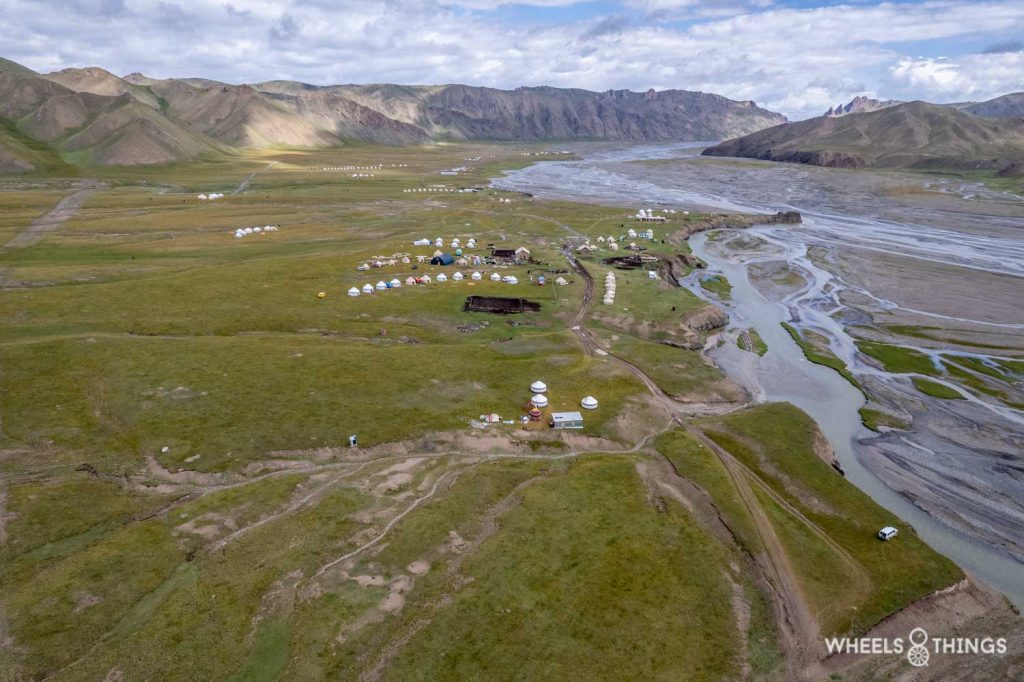
It was a fairly large yurt camp with, again, no mobile phone coverage. For those looking closely, you can see a yellow dot next to the first row of yurts on the left. Das our Bukhanka 😁.
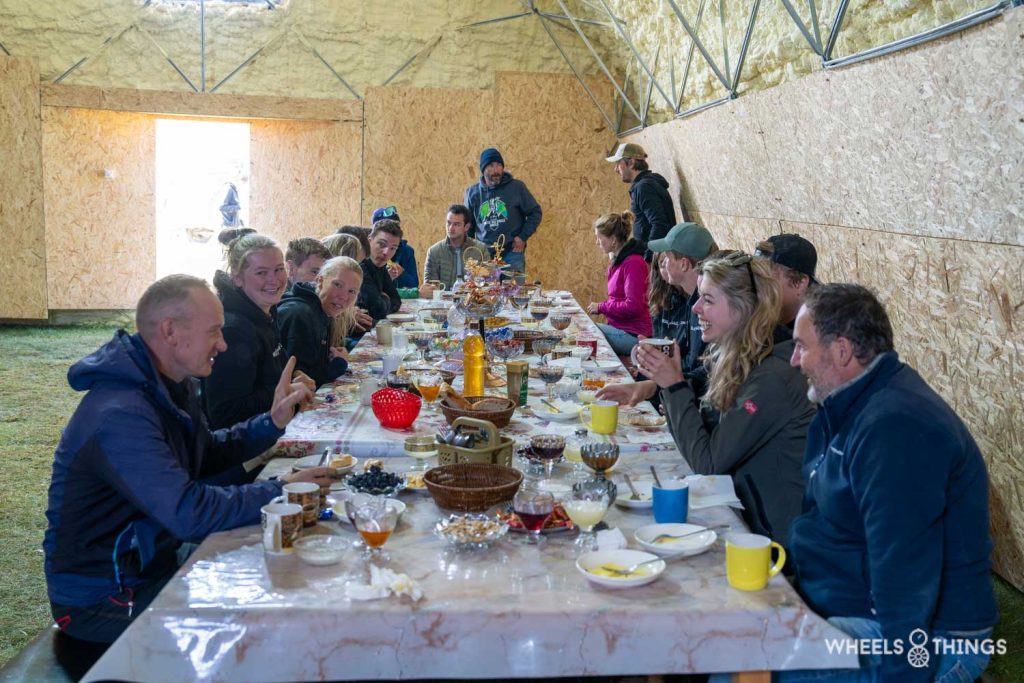
We could all eat together in a kind of hangar where we again met the three girls from Koekelberg. There was a very nice and relaxed atmosphere and both we and the Dutch were able to talk fully about the events of the past few days.
Above, you can see a short video of the second part of our road trip.
Did you miss the first or second part? Then click here for part one and click here for part two
If you are also interested in this adventure, check out the website of De Verdwaalde Jongens
